Pathfinder Roleplaying Game by Alien Rope Burn
| 1 | Introductions |
| 2 | Pathfinder Open Gaming License |
| 3 | Getting Started |
| 4 | Races |
| 5 | Classes |
| 6 | Skills |
| 7 | Feats |
| 8 | Traits |
| 9 | Equipment |
| 10 | Additional Rules |
| 11 | Combat |
| 11.1 | Grappling |
| 12 | Magic |
| 13 | Spells |
| 14 | Prestige Classes |
| 15 | Gamemastering |
| 16 | Environments |
| 17 | Creating NPCs |
| 18 | Magic Items |
| 19 | Appendices |
| 20 | Epilogue |
Introductions
Original SA post
Yup. The roughs are done. After writing and rewriting it's time. The 2012 apocalypse is upon FATAL & Friends.

Pathfinder Roleplaying Game Part 1: Introductions
Let's look at the cover!

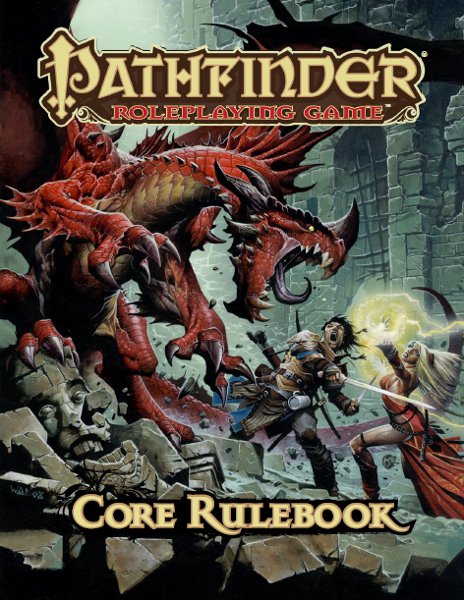
"Look oooout, there's a prostitute trying to cast a spell behind youuu!"
"What?! Where? Maybe she's just pro-sex, you scaly dick!"
Let's look at the back. Blah blah exciting adventure, traps, fate is yours...
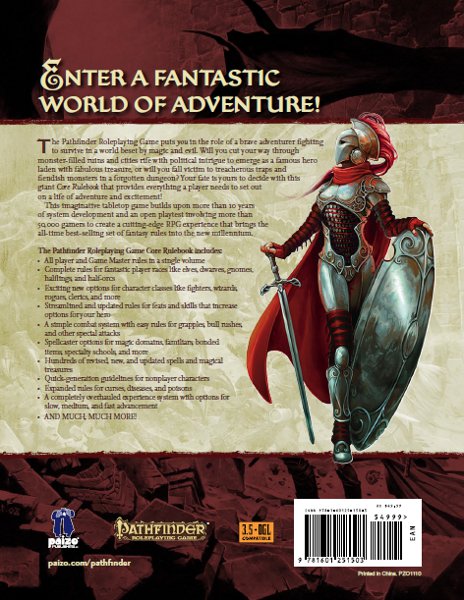
Pathfinder Roleplaying Game posted:
This imaginative tabletop game builds upon more than 10 years of system development and an open playtest involving more than 50,000 gamers to create a cutting-edge RPG experience that brings the all-time best-selling set of fantasy rules into the new millennium.
What you have to realize - in case you've just crawled out of a womb and haven't heard - is that Pathfinder is based directly on Dungeons and Dragons 3.5 and its tie-in system, d20. So that's what they're getting "more than 10 years" of development. Of course, they didn't develop it for ten years. Wizards of the Coast did.
But wait. Hang on. Hold up a second.

Dungeons and Dragons 3rd Edition was released in 2000. Pathfinder was released in 2009. So. They're counting development time before release, maybe? In 2003, it was revised as Dungeons & Dragons 3.5 . Now, one thing to understand is that Dungeons & Dragons 3.5 did develop many new ideas. None of which Pathfinder is legally allowed to use.
So yes, it was being developed, but very little of that development can ever be used in the Pathfinder Roleplaying Game . Mostly, they're just revising 3.5, a game which was, if you count 1999-2003, roughly four years in development.
I realize this might sound a little nitpicky, but what I'm demonstrating from the outset is that Pathfinder is developing a mythology. Not a mythology of elves and dragons. It's about developing a mythology of being the true bastard heir to the Dungeons & Dragons empire, unjustly cast off of its throne. And well, crunching the numbers is a bit of primer before I mention...
... 50,000 playtesters ? Assuming groups of around five people apiece, you mean to tell me Pathfinder's crew of about two dozen writers and editors collated 10,000 playtest reports in any meaningful sense?

Nonsense, of course, to build the mythology, that this is a game rescued by and for the people. I have no doubt the designers probably even think that. It doesn't necessarily make it true, sadly.
I hate to slander this early on, but something I hear over and over while I've been writing this has been how Pathfinder basically ignored any genuinely critical playtest information. This is all anecdotal, of course, but every indication seems to point towards the playtest being more a marketing ploy - the game was set in a design course and that wasn't likely to change notably.

Jason "Car Warrior" Bulmahn
The lead designer is Jason Bulmahn, a former architect that was hired to be the editor of Dragon back in 2004, though there's no indication of editing experience before that. He also worked on some products for Dungeons & Dragons 3.5 , like Elder Evils or Dungeonscape ... wait, stop.
Hold up.

"Lead designer" is misleading, isn't it? I mean, Pathfinder is a systemic successor to Dungeons & Dragons 3.5 , in that 90% of the rules are the same. So he's more of a lead revisionist, I guess? Plagarist, if you're going to be blunt about it. I mean, we know he can write and design, I'm not sure that's the best title here.
So who did design this game?

Monte "Muppet" Cook
Well, the next name we see is Monte Cook, or "Design Consultant". He actually was involved in writing Dungeons & Dragons 3.5 , but he got his start in writing for the crispy crunchity games known as Champions and Rolemaster . He then worked for TSR doing books like A Paladin in Hell and Faction War . Leaving Wizards of the Coast after Dungeons & Dragons 3rd editoin he continued to write for Dungeons & Dragons prolifically through his "Malhavoc" imprint published by White Wolf.
In 2006 Monte said he was done with RPGs and would focus on other creative efforts, a state of affairs that would last a year before he was back to making his own World of Darkness or somesuch, and then quit RPGs again, which lasted like half a year, and then wrote some more RPG stuff, and then he got hired for Pathfinder , but only as a consultant, because he doesn't write RPGs anymore. Whew! He recently finished a kickstarter for his new sci-fi RPG of the sort he doesn't write anymore, Numenera , a game that "focuses on story and ideas over mechanics". Given his previous work on Rolemaster (mechanically complex), Champions (mechanically complex), and Dungeons & Dragons 3e (mechanically complex)... we'll see.

The other two key designers of Dungeons & Dragons 3rd edition , Jonathan Tweet and Skip Williams, just get an "inspired by" towards the bottom of the page. Jonathan Tweet gave us Ars Magica , Over the Edge , and Everway , all of which are pretty interesting RPGs, and worked on developing Dungeons and Dragons 3e & 3.5 for 8-9 years. He is now working on 13th Age , a fantasy RPG that draws upon Dungeons & Dragons but introduces a lot of added or radically redesigned systems. Skip Williams worked for years doing the "Sage Advice" column answering rules questions about Advanced Dungeons & Dragons , which is the nerd equivalent of hopping in an iron maiden and twirling around as fast as you can. He has done freelance work for Dungeons & Dragons since helping design Dungeons & Dragons 3rd edition , and now writes for the Kobold Quarterly magazine. Neither did any work on Pathfinder .
There are some other people but fuck, I'm on the first page here and I'm already exhausted. Look up Sean K Reynolds on wikipedia.
They give a dedication to Gary Gygax and Dave Arneson, even though Gygax expressed an emphatic distaste for Dungeons and Dragons 3.5 and the Open Gaming License that makes Pathfinder possible at all. In fact, Gary predicted that the OGL could be used to rob Dungeons & Dragons of its IP, rather prophetically.
But that's another part of the Pathfinder mythos: that it's a continuation of what Gygax started, that it owes everything to him. And perhaps it does. But pretending Pathfinder is a continuation of the old brown box is purest fabrication. And if you don't think they've made that assertion, well, read on.
That low humming sound you hear in the background is Gygax's corpse hitting 20,000 RPM.
And so, we have Monte Cook's introduction....
Monte Cook posted:
For almost three years, a team of us worked on developing a new rules set that built upon the foundation of the 25 years prior. Released in 2000, 3rd Edition started a new era. A few years later, a different set of designers made updates to the game in the form of 3.5.
And, of course, who carries on that tradition? Tell us, Monte.
Monte Cook posted:
Today, the Pathfinder Roleplaying Game carries on that same tradition as the next step in the progression. Now, that might seem inappropriate, controversial, or even a little blasphemous, but it’s still true. The Pathfinder RPG uses the foundations of the game’s long history to offer something new and fresh. It’s loyal to its roots, even if those roots are—in a fashion—borrowed.
Yep, Pathfinder is the true heir, unjustly dethroned, according to Pathfinder's creation myth. And - Monte - "Borrowed" is when you use something and give it back. This is taking. Grabbing. But being a grabber doesn't sound as nice. So he says "borrowed".
Monte Cook posted:
The game’s designer, Jason Bulmahn, did an amazing job creating innovative new mechanics for the game, but he started with the premise that he already had a pretty good game to build upon. He didn’t wipe the slate clean and start over. Jason had no desire to alienate the countless fans who had invested equally countless hours playing the game for the last 35 years.
It's like a series of political talking points. Continuation of 35 years. Comforting reinforcement of fandom. There is nothing that will challenge you or surprise you. Here, in Pathfinder , you are home. Game of the people.

Monte Cook posted:
One of the best things about the Pathfinder RPG is that it really necessitates no “conversion” of your existing books and magazines. That shelf you have full of great adventures and sourcebooks (many of them very likely from Paizo)? You can still use everything on it with the Pathfinder RPG.
This is not actually true .
Monte Cook posted:
In fact, that was what convinced me to come on board the Pathfinder RPG ship. I didn’t want to see all the great stuff that had been produced thus far swept under the rug.
Translation: "I, Monte Cook, can finally sell my backlog of d20 material once again, including the $120 Ptolus set."

Monte Cook posted:
The Pathfinder RPG offers cool new options for characters. Rogues have talents. Sorcerers have bloodline powers. It fixes a few areas that proved troublesome over the last few years. Spells that turn you into something else are restructured. Grappling is simplified and rebalanced. But it’s also still the game that you love, and have loved for so long, even if it was called by a different name.
See folks, it's still the real Dungeons & Dragons! And don't worry about the changes! It's not real change. Scary change. Threatening change. None of that here! Only gifts to the true fans who stay true... to trueness!
Monte Cook posted:
I trust the gang at Paizo to bear the game’s torch well. They respect the game’s past as much as its future. They understand its traditions.
Not like a certain other company by the coast that has destroyed Dungeons & Dragons ... not that you need to be a wizard to know what I'm talking about! hint, wink. Wink, hint. HINT, WINK.
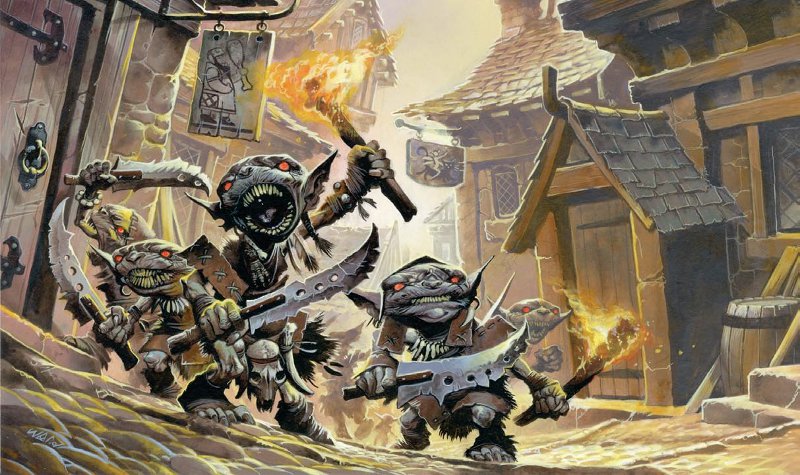
Pictured: Paizo employees raiding Wizards of the Coast. Man, I should get into poltical cartooning.
Next, we get Jason Buhlman, who thank lawful goodness is a little more subtle. He just talks about the great adventures you're gonna have and how the whole thing came out of his house rules but has become a whole game which is actually somebody else's game plus his house rules.
But wait!-

Jason Bulmahn posted:
So while the Pathfinder RPG is compatible with the 3.5 rules, it can be used without any other books. In the coming months, you can expect to see a number of brand-new products, made specifically to work with this version of the rules, from Paizo and a host of other publishers through the Pathfinder Roleplaying Game Compatibility License. This license allows publishers to use a special logo to indicate that their product works with the rules in this book.
Actually, the Pathfinder RPG ... is missing monsters. Not a monster to be found. It's not actually standalone. You need the Pathfinder Bestiary , sold separately.
Oh, and the license? Very clever. It lets them exercise some control over their licensees that the Open Gaming License does not. Of course, they don't actually need to raise a legal finger. People will jump in any pool if they think there's change at the bottom.
Jason Bulmahn posted:
Since the spring of 2008, these rules have undergone some of the most stringent and extensive playtesting in gaming history. More than 50,000 gamers have downloaded and used these rules.
Oh. That's where they get the 50,000 number from. Somehow, 50,000 downloads = 50,000 playtesters. This seems questionable. It seems like... bulllshiiit.

Oh, hey, here's something .
Originally when the playtest closed they said they had 45,000 playtesters. Here's another thought: they said they had 50,000 downloads. But there were four separate playtest documents. Was that for all four documents, or was it for the highest amongst them? Where did the extra 5,000 playtesters come out of? Is Paizo just really, really generous with rounding?
I don't want to call them liars. Maybe they're just really bad at the truth.

Next: The Pathfinder Roleplaying Game Compatibility License! It's easy! It's free! It's... worth what you pay for it.
Pathfinder Open Gaming License
Original SA post
Pathfinder Roleplaying Game Part 1a: The Pathfinder Compatibility License
After hearing of the Pathfinder Roleplaying Game Compatibility License , I decided to look further into it. After all, many, many companies have signed up for it, as it turns out.
There's no fee, but you're not allowed to use any of Pathfinder's setting material. Nor are you really allowed to get into adult content. You're supposed to hand in a copy of anything you publish 30 days after publication. Other than that, it's pretty fancy-free. And it turns out there's a registry where you can view all the applications. Most, frankly, are pretty bog-standard.
And then...
... there is...
... the
quote:
Christopher Glen Phernambuca
http://www.grimora.com
Its a campaign setting of a world known as Grimora. I understand that in your book on the Great Beyond: Guide to the Multiverse there is a planet with doors to different worlds, well this is where my world would come from. The world itself is set up in comparison to like judge dredds universe. The cities are civilized, while, the laying country sides are harsh worlds.
Brief:
The people of Grimora are a strong city-oriented culture.
With magic that has aided the development of the world
for the last three thousand years. Science seems to have
molded with the arcane, and machines are engineered
with the aid of magic. Ships fly through the sky, carriages
pull themselves, and weapons know no bounds.
The world is teeming with endless possibilities.
Though, the world hasn't always been so. Civilized had
only bred destruction at its foundation. Grimora hides her
secrets closely, and all the questions of how or why things
have come to be. Nearly a thousand years ago a great war
took place, it was called the great cataclysm, cities fell from
the sky, and an ocean of souls would perish.
An earthquake shook with such force that the large cities
crumbled to the ground, and all there powerful magic fell.
In the aftermath the surviving people would flee to different
corners of the world, where some sort of magical aura
still flowed.
A few found such places but for the most part, they took
support from an interplanetary race known as the Draconians
which introduced them to mundane tools and science to aid
them in their rebuilding.
Now more than a thousand years later. Grimora is still healing,
and people have returned to a semblance of reality. However
outside the high walls of the city, the country side is still a
lawless world, of thugs, bandits, and warring bands, trying
to seize the days of ole.
A cataclysm?! A lawless land? It's Clicharia, the sacred land!
Dane of War Publishing posted:
http://daneofwarpublishing.blogspot.com/
Dane of War Publishing® is a DK-based company, which specializes in producing unique projects of our own.
Dane of War Publishing® exists to expand the frontiers of roleplaying and wargaming by developing new and better ways of doing things. Above all we want the people using our products to have fun.
In addition to our upcoming WWII Skirmish game, F.U.J.I.G.M.O.™, and Danes of War: For Konge og for land™, the The Danish military in the 17th and 18th Centuries sourcebook, I have chosen to adapt all of our zombie RPG material to be compatible with the Pathfinder Roleplaying Game.
Future products designed specifically for The Pathfinder Roleplaying Game will also be developed.
Dane of War Publishing® has committed to print all of our titles on chlorine free, recycled paper.
How would the Siege of Tönning be affected by the use of summoned giant frogs?
Also, Dane of War has made a habit of taking freely available work, removing the author's name, and reselling them on rpgnow.com, as it turns out. To be fair, his plagarism is both legal and environmentally friendly.
Doyle Motes posted:
Doyle Motes
doyle32%40verizon.net
I am new to Pathfinder but not to Role playing games. I have played Dungeon and Dragons and the Advances System. I have started a Dwarf Fighter "Moto-sarus. Looking forward to joining in and having fun. I am up for playing day or night contact me.
In case if you were wondering if Paizo actually reviews submissions?
They do not.
Empty Room Studios posted:
http://www.emptyroomstudios.com
Empty Room Studios plans to produce a Steampunk Musha compatible product, followed by several other settings.
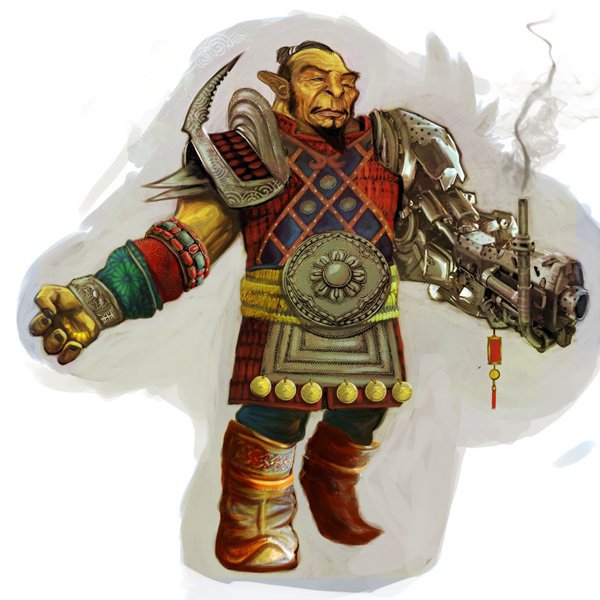
I just want to say the subtitle of his product is "Victoriental Adventures".
Yuuup.
Eridanus Books posted:
Eridanus Books
http://eridanusbooks.blogspot.com/
Remember when facing a dragon was a big deal and just getting across a chasm could be a challenge?
Eridanus Books presents a series of adventures and alternate rules for a Grittier kind of Pathfinder. Low-magic, skill-powered games in which quick thinking, improvisation and planning win the day. After all, how are you supposed to beat that Stone Golem without magic items?
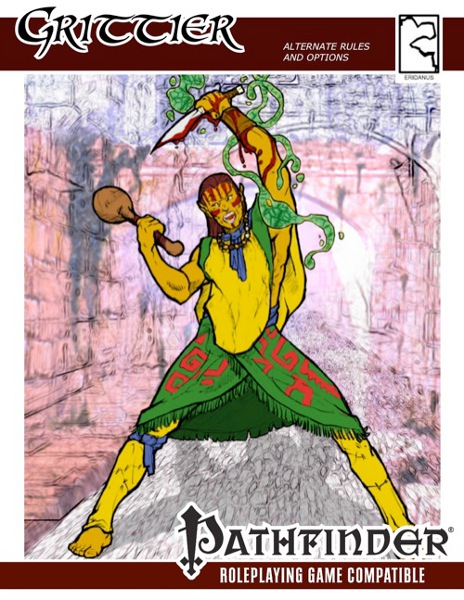
Hire a wizard.
ICOSA Entertainment, LLC[/quote posted:
http://puresteamrpg.com
Pure Steam is a gritty, credible, feasible steampunk setting. The basic set provides low-magic options for fantastic adventure, but wizards, clerics, and other spellcasters are fully integrated. Expanded territories introduce more fantastic elements to satisfy players' magic desires. Firearms, pneumatics, dirigibles, and ironclad ships allow for a whole new way to explore and interact with the game environment.
Playing Pure Steam is akin to slipping into a comfortable shoe. Monsters and challenges are fresh yet familiar. Politics, religion, and geography are relatable to players' real world experiences. Winks and nods to the history of earth exist, but are tasteful and subtle, so as to not detract from gameplay.
Will you be a halfling hillbilly alchemist, distilling potions by moonlight? What about a Dwarven sea captain, making a harsh voyage to uncharted isles to discover new races? Why not attach your bayonet and charge the savage forces threatening frontier towns? Try an experimental gyrocopter to get to your drop zone. Or test your fate in a steamsuit, wrought with power but riddled with dangers.
Technology is on the verge of robust advances, with inventors nearing completing of short wave radio communications, cartridge ammunition, and oil boilers...

I prefer my new genre, called "Sparkpunk", where everything runs on the fanciful, wondrous technology of alternating and direct current, which is even more gritty and feasible because it is real.
Jason Bulmahn posted:
http://www.facebook.com/jasonbulmahn
Free product for fans of the Game's Lead Designer. The file can be found through the fan page site on facebook.
The first installment of the Weekly Grind, a Pathfinder Roleplaying Game compatible adventure blog is now available online.
It can be found here .
It's interesting that the game's lead designer needs to apply for a Pathfinder Compatibility License. Also very, very confusing. This is the result.
John Wick Presents posted:
http://www.johnwickpresents.com
The Book of Thieves.
Written and Designed by John Wick and Jess Heinig
Not "rogues," who are sissy wanna-bes, but THIEVES.
This is not a book for rogues. This is the thief book. It contains a new character class: "Thief." The thief is a specialist in a particular form of criminal enterprise. None of this "I pick pockets of monsters" or "I open locks on treasure chests." The thief generally doesn't even like going into dungeons because they are dangerous and dirty and filled with things you can't con and sometimes don't even have treasure.
A thief will STEAL YOUR STUFF and he will do it with a smile on his face because your hard-won loot just paid for his ale and whores.
The Book of Thieves includes:
The Book of Thieves will also have the standard slew of new goodies: new Feats, new magic items, new gods to worship (street gods!), and all sorts of surprises.
- Rules for a new character class: the thief. Thieves are like wizards and sorcerers: all of them are thieves, but they have "specialty classes." The con man, the greaser, the wire, the thug, etc.
- Rules for building street gangs and guilds.
- Rules for City management and influence.
- A new system for designing capers and confidence crimes (see my previous game, Wilderness of Mirrors for an idea where I'm going with this).

At least with writing about con men, John Wick is speaking from experience, so there's that. Never actually released.
Wait, he put a second application in, for some reason-
John Wick Presents posted:
johnwickpresents.com
Hello,
You may be familiar with a series of articles Jess Heinig and I wrote for Kobold Quarterly entitled "Wicked Fantasy." They were re-interpretations of the classic D&D races (humans, gnomes, elves, dwarves and halflings) done with a "John Wick twist."
I plan on making some tweaks to make them compatible with Pathfinder as well as adding five more races: orks, gnolls, goblins, rat-men and kobolds. I'll be adding more detail to the first five races as well.
I plan on releasing each race as a PDF and then collecting them all in a physical book at the end of the year (the same plan I used for the Big Book of Little Games in 2011). Anyone who purchases any PDF will receive a discount on the physical book when it becomes available.
If you would like to see a sample of what Jess and I did, I've included "the Reign of Men" below. (This is the original article before I've added 5,000 words of additional material.) The other races follow the same format.
Thank you for your consideration and I hope to hear from you soon,
John Wick
The Reign of Men
<<archaic text>>
And this is the Reign of Men. When all are king. Not subject to any gods or tyrants, men choose their own destinies. Free to wreck or ruin our own lives or to lift ourselves up from the muck and sing songs that no voice has ever sung.
And this is the Reign of Men. We are free. And so shall we always be.
<<end archaic text>>
Men have always been here. They are the Old Race. Newcomers—such as the elves, haffuns and uvandir—bring with them their strange ways and gods, but men and their Kingdom have always been here. From the first fires of creation to the moment when the heat of those flames die, men will be here. First to step from the fire, last to walk into the darkness.
The word “Kingdom” is accurate, and yet, misleading: a term the New Races use when speaking of humanity. While men do have a King, their own word best translates as “reign” or “rule.” Not the Kingdom, but the Reign of Men.
Established by a line of warlords in the earliest days, the Reign of Men has transformed itself many times. Once a tyranny, now something very different. Five centuries ago, the Kingdom of Men suffered a plague of philosophers, all asking questions of liberty and social duty. The movement transformed the Kingdom and inspired a young and newly-crowned king—Mantias Colevale—to change the way men were ruled. Some called him “the Philosopher-King,” and others ridiculed as “the King of Mans.” But the laws Colevale passed forever changed the direction of the Kingdom, creating something the world had never seen before.
Now, to be human is to be part of something larger. A citizen of a self-deciding government, each man has liberty and responsibility. He has what the philosophers called courage: the ability to recognize you are not the most important thing in the world. As such, men do not serve themselves: they serve the Reign. While human achievement is always self-satisfying, satisfaction is not the end goal. “What betters the Reign?” is the prime question. The King serves the Reign. His magistrates serve the Reign. The citizens serve the Reign. And the Reign provides them freedom to pursue happiness.
At least, that is what was true. These days, the bones of the Kingdom are old and beginning to brittle. The blood is thin. And where the word courage was once shouted from the rooftops, it is now a chorus in a song: repeated over and over again from habit. True, there are those who still remember the passion of the philosophers and their transformative magic, but those days are long gone. The selfish reward themselves while the needy suffer with naught. Temples of foreign gods are on every street corner, their luring voices calling to the weak. And the King sits on the throne a bitter and broken man. Where is the courage of men? Where is the glory of the Reign?
Not all is lost. The courage of men remains, although it may be asleep in their hearts. There are those who carry it still. Those who inspire others through their deeds. Stories spread of young men and woman whose actions may yet ignite the quiescent fire. Even now, word of their deeds are told throughout the Kingdom through by voice and printer’s ink. Some even speak of a second Reign when men will rise up as they did before.
Rise up and take hold of their own destiny. Rise up and claim what is theirs. Rise up and Reign.
The Elevation of Men
“If we only contemplate on what we are, we will never see what we may become.”
— Valir Severin, The Philosophies
Humans are bound not by a common faith, but by a common philosophy: that all men may become more than they are through rigorous training, insight and learning. The Kingdom of Men builds schools and universities to bring this insight to all men and women.
While other races seek insight and power from external entities, humanity looks for power from within. Will, self-determination and dignity are the virtues of men and these virtues provide men with powers the other races can only describe as “magical.” But men would claim these abilities are the exact opposite of magic; instead, the abilities taught to children in human schools and universities are only tapping into latent power within the human spirit.
Instead of temples, men have universities. Each town and village has at least one building dedicated to knowledge and learning; a place where men go to cure their curiosity.
Instead of priests, men have philosophers (sometimes called “travelers” or “seekers”). These scholars bring books with them wherever they go, teaching and learning both, bravely baring the fragile light of knowledge to a dark and haunted world. These philosophers are not simply book-bound clerics, but men and women trained to find and fight wickedness and evil, to protect those who cannot protect themselves. They can be found everywhere in the Reign of Men, armed not only with knowledge, but also with armor, shield and sword.
Apostasy
In these dark days, many men fall away from the path of philosophy and take up the faiths of enemy gods. As it turns out, some of the most fanatical and devoted of any god’s followers turn out to be human.
Look in the temples of the elven or dwarven gods. You will find humans there, chanting prayers. Most of their human cousins upon these apostates sadly, seeing them as misguided fools, but more than a few even look upon them with a deep hatred, seeing them as traitors to their own race.
Human Pride
When the other races speak of humans, instead of “human will,” they often invoke “human ego.” Instead of “human pride,” they talk about “human overconfidence.” It is no secret humans are a proud race, but that pride can get the best of them from time to time. Tales of humans rushing into danger with no thought to their own safety or well being. Courage or hubris? It is hard to decide.
Human Racial Traits
• +2 to Intelligence, Wisdom, or Charisma: Humans have an ancient lineage and a proud heritage that stresses standing on their own. They excel at teamwork, innovation, and inspiration. As a result, humans have great wellsprings of inner strength.
• Medium: As Medium creatures, humans have no special bonuses or penalties due to their size.
• Human base land speed is 30 feet.
• Divine Power: Because humans developed as a culture without the influence of gods, they are fiercely resistant to the divine magic that other races take for granted. Humans who choose to adopt a divine patron, though, bring that conviction to their divine studies. As a result, humans gain one of two bonuses. Humans who are not divine spellcasters (those who do not have any divine caster level, divine spells, or access to domains) gain a +2 racial bonus to all saving throws against divine spells and effects (including effects from divine scrolls). This bonus increases by +1 for every four character levels. Humans who possess divine spellcasting ability instead gain a +1 caster level bonus to all divine spells. Humans who start with no divine casting ability and later gain it, or who have divine casting ability and lose it, change the bonuses from this ability appropriately.
• Improved Teamwork: When a human character takes the Aid Another action, the recipient receives a +4 bonus to the corresponding check, instead of +2.
• Martial Weapon Proficiency: Even humans who live in relatively secure areas must occasionally defend themselves, and many human cultures have a particular weapon associated with their nation. Humans gain Martial Weapon Proficiency in one weapon of the player’s choice at first level.
• Rally: Humans can drive others to new heights of determination through shouts of inspiration and encouragement (or threats). Once per day as a move action, a human can bolster the will of an ally by haranguing, shouting, yelling a battle cry, or otherwise inspiring new resolve in the ally. The ally must be within 30 feet and must be able to hear the human. Rally affects an ally who has failed a Will saving throw since the human’s last turn. Make a skill check using either Diplomacy or Intimidate skill; the result counts as a new saving throw result for the ally against one effect (human player’s choice). A human cannot use this ability on himself. Additional daily uses of this power are gained at every third level, so it can be used twice per day at 3rd level, three times per day at 6th level, etc. Rally is a sonic, mind-affecting, language-dependent ability.
• Skillful: Humans pursue a wide range of careers and live in a multitude of conditions, and as a result learn to excel in many different skills. Choose one skill. That skill permanently counts as a class skill for all classes. Additionally, that skill gains a +2 racial bonus. This bonus increases by +1 for every four character levels.
• Automatic Language: Common. Bonus Languages: Any (other than secret languages, such as Druidic). Humans have had to learn to deal with other cultures and races, so they tend to pick up languages from a wide range of sources, as well as having their own regional dialects.
• Favored Class: Any. When determining whether a multiclass human takes an experience point penalty, his highest level class does not count.
[[BEGIN FEATS SECTION]]
God Killer
Fighting against the followers of cults and religions has made you savvy to the ways of divine spellcasters and unholy monstrosities.
Prerequisites: Human, Knowledge (Religion) 4 ranks, no divine spellcasting ability.
Benefit: Your racial bonus to saving throws against divine spells and effects increases by +1. You gain a +1 bonus to melee attack and damage rolls against anyone with divine spellcasting ability. As a full-round action, you may make a single melee attack against a divine spellcaster and gain an attack and damage bonus equal to the highest-level spell that the caster currently has prepared. This bonus supersedes (does not stack with) the normal +1 bonus granted by this feat. If the target currently has no divine spells (or no spells above level 0) prepared, you gain no bonus from this special attack, but you can still gain the normal +1 attack and damage bonus on regular melee attacks.
Special: If you ever gain divine spellcasting ability, you lose the benefits of this feat.
Improved Rally
Your ability to rally others makes you a natural leader of men.
Prerequisites: Human, Diplomacy 4 ranks or Intimidate 4 ranks.
Benefit: When you use your Rally racial ability, your skill check counts as a new Will saving throw for every ally (except yourself) within 30 feet. Allies must still be able to hear you, as normal. The Rally effect only functions on allies who failed a Will saving throw since your last turn.
Normal: Your Rally racial ability affects one ally.
Love of Knowledge
You pursue philosophia, the love of knowledge.
Prerequisites: Human, any Knowledge skills 4 ranks total.
Benefit: You may make untrained Knowledge skill checks, even if you do not have any ranks in the Knowledge skill, regardless of the DC of the skill check. Once per day per four character levels (minimum of once per day), you may ruminate on a subject for 2 minutes in order to take 20 on a Knowledge skill check. As usual, you may only take 20 if you are not under stress or threat and have uninterrupted time to consider the question.
Normal: You may only make untrained Knowledge skill checks if the DC is 10 or less. You may not take 20 on Knowledge skill checks.
[[BEGIN NEW RELIGION SECTION]]
Elevation of Man
Neutral Good
Human clerics often pursue the Elevation of Man, a loose code of ethics that advocates self-improvement, community, reason, and tolerance. Some clerics advocate orderly societies with strong rules to help protect the weak and advance the goals of nations, while others promote self-determination and individual freedom to pursue one’s personal destiny, but all adherents of this philosophy promote the common good and welfare of all humanity.
Portfolio: Humans, Philosophy, Self-Improvement
Domains: Good, Humanity, Philosophy, Protection
Weapon: Long Sword.
Humanity Domain
Granted Powers
+2 sacred bonus to all Charisma checks and Charisma-based skill checks when interacting with humans. All humans who would normally start at an interaction stance of Indifferent start as Friendly instead.
Humanity Domain Spells
1. Bless: Allies gain +1 on attack rolls and saves against fear.
2. Eagle’s Splendor: Subject gains +4 to Cha for 1 min./level.
3. Heroism: Gives +2 bonus on attacks, saves, skill checks.
4. Tongues: Speak any language.
5. Telepathic Bond: Link lets allies communicate.
6. Heroism, Greater: Gives +4 bonus on attack rolls, saves, skill checks; immunity to fear; temporary hp.
7. Holy Word: Kills, paralyzes, blinds, or deafens nongood subjects.
8. Holy Aura: +4 to AC, +4 resistance, and SR 25 against evil spells.
9. Heal, Mass: As heal, but with several subjects.
Philosophy Domain
Granted Powers
For a total time per day of 1 round per cleric level you possess, you can act normally regardless of magical effects that control your actions or influence your mind as if you were affected by the spell mind blank. This effect occurs automatically as soon as it applies, lasts until it runs out or is no longer needed, and can operate multiple times per day (up to the total daily limit of rounds).
This granted power is a supernatural ability.
Philosophy Domain Spells
1. Comprehend Languages: You understand all spoken and written languages.
*2. Calm Emotions: Calms creatures, negating emotion effects.
3. Suggestion: Compels subject to follow stated course of action.
4. Imbue with Spell Ability: Transfer spells to subject.
5. Atonement: Removes burden of misdeeds from subject.
6. Owl’s Wisdom, Mass: As owl’s wisdom, affects one subject/level.
7. Scrying, Greater: As scrying, but faster and longer.
8. Moment of Prescience: You gain insight bonus on single attack roll, check, or save.
9. Astral Projection: Projects you and companions onto Astral Plane.
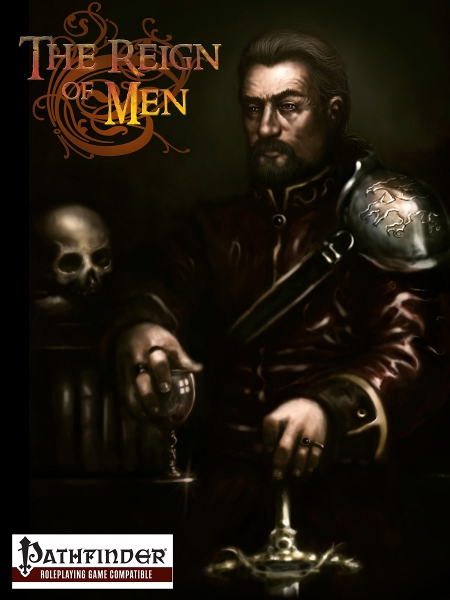
Did he just post the whole supplement?

Joshua L Simon posted:
http://www.avlis.org
Why Publish an Avlis Setting?
Avlis as a setting already exists and has existed for some time. It will continue to exist in whichever incarnation it takes in the coming years. Though it started out as a small project known only to a dozen people, today there are over 500,000 people who have heard of it. The majority of these people are players of Bioware’s Neverwinter Nights (nwn.bioware.com). A search on their message boards will reveal the degree to which Avlis’ existence is common knowledge within that community. Thus, this setting is not simply an amateur submission from an unknown fantasy author who has never shown it in public before. The concept of Avlis is tested and true.
The online incarnation of Avlis through Neverwinter Nights is arguably the most successful persistent world (PW) created with that software. Here are some references in which Bioware has mentioned or featured Avlis:
http://nwn.bioware.com/players/prof...rlds_avlis.html
http://nwn.bioware.com/players/profile_copap_part1.html
http://nwn.bioware.com/links/viewcat.html?c=10
Avlis has also been featured on many unofficial fan sites, such as Neverwinter Connections, where it is rated the number one PW:
http://www.neverwinterconnections.com/
A google search on “The World of Avlis” reveals over 6,000 hits:
http://www.google.com/search?hl=en&...+Avlis%22&btnG= Google+Search
Of course not every one of the 500,000 members of the Neverwinter Nights community would be likely to buy an Avlis sourcebook. Out of those 500,000 people, maybe 10,000 have tried Avlis.
Another piece of market research can be seen here:
http://www.avlis.org/viewtopic.php?t=44936
In this non-scientific poll, respondents were asked “Would you buy a hard cover d20 System Avlis Sourcebook?” There were 281 responses as of January 21st, 2006. 152 said “Yes”. 66 said “Maybe”, and 19 said they would buy more than one copy a piece.
In short, an Avlis sourcebook should be published because it already has an established market. The editor of Dragon Magazine commented in a seminar at GenCon2004 that any sourcebook selling 1,000 copies is considered wildly successful. For Avlis, the first 100 to 200 copies are going to be extremely easy to sell because no advertising is necessary. In effect, the publisher is getting a 100 to 200-copy jump on that 1,000 mark. Depending on the publisher’s quality and market penetration, this could go a long way.
Introduction: The World of Avlis
Sometime around 1977, a group of teenagers and kids in the back woods of New Jersey’s pine barrens began playing a Dungeons and Dragons (D&D) campaign that would last for decades in one form or another. Today, in 2009, The World of Avlis is ready to take the next step towards release and become a published Campaign Setting. This document will give a brief overview of Avlissian history, races, and magic. It will then briefly describe the unique features of the world and the advantages of taking it to publication.
[setting details snipped]
Avlis was designed to take advantage of two specific qualities that are not often seen in d20 campaign settings, or even official Wizards of the Coast releases. Chiefly, the world is designed to mesh well with any other fantasy roleplaying d20 supplement or fantasy world, which is historically the best-selling kind of RP world.
One disadvantage of the “new and innovative” d20 world approach is that the book must stand in isolation because no other material can mix with it without destroying the tone and feel of the work. As an industry, this hurts the sales of other d20 sourcebooks, and ultimately this affects the original sourcebook, causing it to sell fewer copies. Avlis is designed to work well with many additional classes, races, feats, dungeons, and adventures available in other d20 publications. On its own, it contains a good number of prestige classes, spells, and races that can be extracted and used in nearly any other setting.
The second design principle lies within the world’s fiction. Traditionally, questions of morals and ethics are extremely cut and dry in roleplaying games. “Good” kills “Evil”. Things are either bad or not bad. Law goes overboard on organization and chaos is strictly flippant. Cookie cutter monsters have horrible tactics and love to throw themselves into suicide missions, and heaven forbid they show any personality! Avlis’ design is decidedly not like this. The world responds heavily to alignment, but not in an absolute sense. Alignment is used as a guide to determine whether a being is selfish or selfless, intellectual or compassionate. Every creature on Avlis is self-aware. Each believes that it is “good” and that it is doing the “right thing”, but from its point of view there are those that would see its plans ruined. Even the history of Avlis has multiple points of view on what occurred and why it did so. The races that make up the population are never “cookie cutter monsters”, but instead they are beings with civilizations, motivations and concepts all their own. To illustrate this, the orcish race on Avlis has been retooled to be an intellectually advanced and stimulating race, which accomplishes its goals mainly through political duress, and not brute force.
This is only one example, and all in all these factors play into the main theme of Avlis: connection. Every decision in the world has a ripple effect that permeates into other things. The players of this world are constantly beset by moral dilemmas that require them to think about the results of their actions on other parties.
d20: enabling your heartbreaker settings for over ten years.
Mark White posted:
My compatible Pathfinder Role-playing game takes the best of Kung Fu movies and Asian culture and transcribes that into a role playing game. My core book will contain 3 main class types. The three types will focus on either Physical, Mental, or Spiritual Power.
The Physical classes will depend on the martial arts style chosen during character creation. They will have 30 different styles to choose from. As you level, you become more proficient in your style (class). You can multi class and gain benefits from multiple styles. An example would be a Level 6 Drunken Mantis Fist boxer. You could also replace a style with a weapon skill.
The Mental classes will be able to pick a martial arts style but the style will not be as involved as a physical classes would be and will not define the class. The mental classes will be similar to Rogue, Swashbuckler, Ninja, scout, and more.
The Spiritual classes will consist of spell casters and healers. Styles will function the same as the mental class styles. The spiritual classes will focus on different aspects of divine and arcane spells. Depending on your choices you can shape your character into a bard, mage, cleric, druid, etc.
The cool thing is that I'd like to allow all of the core races as well to add a fantasy feeling. So, you could very well have an Elven Buddhist Dragon Fist Master or a Half-orc Ninja of the Iron Head clan.
I would like to release my own bestiary eventually, expanded styles from different regions of the world, and have a line of adventures based on Asian history and movies but set in the Pathfinder universe.
d20: enabling your Asian stereotypes ofor over ten years.
Mossy Mountain Gathering posted:
Mossy Mountain Gathering is a group of independent designers, writers, and artists that live in the Appalachian Mountains and beyond. The focus of the group is on quality, economical 3.0/3.5/Pathfinder designs and system generic products. Mossy Mountain Gathering is interested in producing both free and commercial products as well as creating games in the interesting of promoting local charity interest. Quite simply, we are a bunch of free thinking, role playing loving hippies, ravers, etc. with creative gaming at heart. Mossy Mountain Gathering is also currently working on some innovative board game designs that may be released in the near future.
d20: enabling your hippies... wait.
Hippies?!
Otherverse Games posted:
www.otherversegames.blogspot.com
Otherverse Games is an imprint of Skortched Urf Studios, started by Chris A. Field. Otherverse Games produces sci-fi, fantasy and even erotic horror campaign material, including the popular Black Tokyo campaign, unusual Otherverse America future history, as well as the Thinking Races series, which brings an assortment of interesting new player species to fantasy gaming. Otherverse Games will produce top quality fantasy material compatible with the Pathfinder Roleplaying Game, and anxiously awaits a modern version of this interesting new system.
It should be noted the Pathfinder Compatibility License excludes adult content.
Postmortem Studios posted:
www.postmort.demon.co.uk
Initially 6-Pack adventures, which will be 'pick up and play' short adventures suitable for one-off evening's play or convention scenarios. Further support I have not yet considered but could be just about anything from game settings to campaigns or monster guides.
It should be noted the Pathfinder Compatibility License excludes adult content.
Prysm posted:
Prysm
http://www.sites.google.com/site/prysmworld
Prysm is a world that was created by myself and other Dm's and players, staring from first edition DnD, we actually had the world finished and left everything at a friends house but when he moved he lost several items. So I am trying to refinish my world and am still working on it, I have several friends helping out and even have the gaming community giving me help as well. We have our own gods (players who have gone to the epic levels), and some of our own house rules.
What I was trying to get out there first is an adventure, it is kind of an choose your own path type adventure that can be used by any level. The Dm only has to choose monsters and traps, the adventure also allows the Dm to customize the challenges.
The adventure is run by Karak The Dark and Terrible a one time loyal servant of Gumby, The First Lawful Evil Bard of Hell and God of Murder, but is now a follower of Amaril Nailo, Hunter of Evil, Patron of Oath Takers, and God of Commraderie. Karak now travels the world with his extradimensional dungeon, which he uses to test would be heroes, those who succeed are rewarded and those who fail come out a little broken but wiser.
one such room is a s follows: this room has a destinctive pentagon shape to it, 20 feet deep, it is 30 feet wide at the far end it tapers to only a 10 foot wide opening you have just entered. In the centre of the room is a jar floating in the air (at a random height determined by the Dm. Another of Karak's floating apprentices appear beside you looks to the key and smiles. 'You must retrieve that jar in order to proceed, it can't be grapsed with magic or touched by anything other than your body. Good luck). With that he disappears leaving you to ponder the problem.
The room looks like this:
[-E-]
[ J ]
\_D_/
The Dm can set the dc for the jump check for the key, I started at 15 and can go all the way to 23, as I ran this for 1st to 3rd level pc's.
The jar has a potion in it that gives a permanent 2 bonus skill points the pc's can put anywhere, if they get it and if they try to cheat the jar falls to the ground and shatters. No matter the out come the servant reappears and gives the pc's a silver key to unlock the next door.
There are other rooms where the pc's need to deal a certain amount of damage to a dummy to proceed, or they have to play chess, craft a key, ect.
It is through this adventure and others that I hope to eventually get my world published as part of the Pathfinder universe.
Mind: blown.
Punching Love Productions posted:
http://www.syndeconrpg.com/
Punching Love Productions is creating a campaign setting compatible with the Pathfinder Roleplaying Game. Trial-sessions are scheduled for January, and content will be released to the website leading up to that time. Content will be released as it is finalized. Eventually, .pdf files of "Syndecon: Vetrina di Tempo" will be released for sale, complete with professional art and all pertinent information. If sales of these .pdfs goes well, a hard-copy book will go into the works.
Here is a preview of what's to come:
“Schism: A state of disunion, dissension, or mutual hostility. A division into mutually opposing parties of a body of persons that have previously acted in concert.” The Oxford English Dictionary
Technology and magic are both fascinating concepts, and Syndecon is a setting where both have an equally powerful role. Taking some elements of the steampunk and steamgoth genres, tending towards the darker regions of each, Syndecon takes the world–Argethen–at a time where nations have grown to unexpected heights, and tensions between bordering countries are rising. The Last Schism, where the world itself was fractured into its current shape, is in the back of everybody’s mind as telltale signs of another schism are becoming evident. The weather has become increasingly more unpredictable and violent, warring factions plague Argethen’s resources, and strange, supernatural phenomena have drastically impacted numerous locations around the world.
Steamgoth? Will these genre innovations never end?!
Sean K Reynolds Games posted:
http://www.seankreynolds.com/skrg/
The goal of SKRG is to publish quality games that help you make better choices about your gaming. They may teach you something about game design in general, the game in particular, or even some part of the real world; ideally, SKRG products should leave you understanding the rules better so you can make better choices for your game, whether in designing your own material or evaluating published books to determine if they're balanced, campaign-appropriate, or worth reading at all.

A recent Pathfinder ruling by this author on the Pathfinder official forums has spawned over 2000 posts of rules arguments.
Storm Bunny Studios, LLC posted:
www.stormbunnystudios.com
Storm Bunny Studios, LLCis a games-design studio that focuses on innovative and non-traditional approaches to a variety of gaming – be it tabletop, tactical, or theatrical. Its principle product is the Rhune: Dawn of Twilight campaign setting – a fantasy fusion of northern ideas and steampunk sensibilities – that is best defined as stormpunk.
It will also support a wide array of common fantasy settings (across a number of systems) by producing unique products that focus on art and story – by keeping the “fluff” in the fore of its design philosophy. By keeping an eye on the elements of story and myth, it will push beyond the traditional lines established by the “crunch crowd.”
The company will offer future artists, writers, and designers a place at the 3PP table, but without necessarily forcing any given system on them (although it will remain in full support of the Pathfinder Roleplaying Game system). Additionally, it will explore projects that focus on solely story-driven material rather than mechanics, giving a large portion of the theatrical gaming community system-free stories to tell.
Storm Bunny Studios, LLC will continue to support its favorite gaming systems by providing quality, balanced products that include streamlined mechanical solutions alongside stunning art and layout.
Visit us soon at Storm Bunny Studios, LLC or check out Rhune: Dawn of Twilight. You can also see us on Facebook for more information about Rhune!

Stormpunk: congratulations, you have reached the end of creativity. Pack it up, folks, we're done.
The Shining Jewel, LLC. posted:
http://www.theshiningjewel.com/lsj
LEGENDS OF THE SHINING JEWEL (TM)
LEGENDS OF THE SHINING JEWEL is an ongoing living-style city of AMTHYDOR(TM), a city set in the player-created World of RAIA(TM). The LSJ Campaign uses the PATHFINDER® RPG game system and is for the mature, serious-minded role-players. Players will create their own Player Characters (PCs) that will advance and grow in LSJ Campaign tournaments. The campaign contains elements of High Fantasy, High Magic, High Intrigue, and High Role-playing. Originally started as a developmental project by the Universe Construction Company (UCC) for TSR, Inc. in 1992, the project has evolved beyond what TSR (or even WIZARDS OF THE COAST) expected, and continues to grow several years later.
[advert details snipped]
A lot of hard work is being done to make the LSJ Campaign a great place to be. If you have any constructive comments or questions, please feel free to email any of the campaign staff.
Thank you.
Jay Fisher
LSJ Campaign Coordinator
lsj-admin@theshiningjewel.com
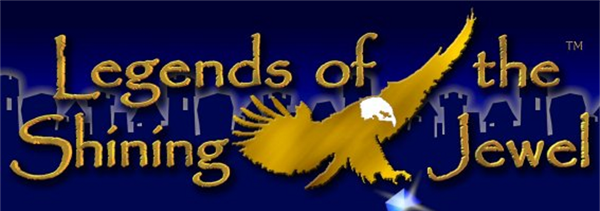
Wait, I have a little bonus content to share from these folks that speaks for itself.
www.theshiningjewel.com posted:
A gnarled gypsy woman, her arms covered in gold and silver bracelets, takes you by the hand, tracing the lines of your palm with a touch
that sends shivers down your spine. She looks deeply into your eyes, peering into your soul. She draws a card from a deck of small plaques
covered in ornate pictures and symbols. She selects a small talisman from her collection, placing in your palm and closing your fingers
around it. “No, don’t look now. That will spoil the magic. Save it for when you need it.” She is sure to have something that will aid
you in your darkest hour.
For $2 players may purchase a sealed envelope, to be delivered at GenCon. Each envelope will contain a cert for an item. The item may
be a potion, a scroll, a pet rock, a mundane object or even a permanent magic item.Opening the envelope represents using or activating the item (drinking a potion, reading a scroll, putting on a ring, etc). There’s no way
to know what’s inside until you open it.The rules are simple —- You can give an envelope to any of your PCs.– You may use up to two per scenario or interactive.
– You need to pay via PayPal, sent to dsamuels@aol.com . You cannot pay cash at the convention.
– 1 envelope for $2
3 envelopes for $5
7 envelopes for $10
"A pet rock from a Gypsy woman?!... I hit her in the skull with it. How much XP was she worth? Nevermind, fuck the XP, can I get my $2 back off her corpse?"
White Haired Man, LLC posted:
www.whitehairedman.com
What Is White Haired Man?
White Haired Man exists because Virtual Tabletop (VTT) software and other methods of online roleplaying have become viable within the last few years. We are excited about this nascent community and want to participate in the pioneering spirit that pushes online gaming forward. We can best do this by jumping in and creating content for online games.
We offer small-scale settings that can be easily introduced into a campaign and reduce the Gamemaster’s preparation time. Our settings do not force the Gamemaster to rework an existing campaign setting. Our work also reflects the roleplaying styles we enjoy a low level of magic, high drama, intense roleplaying opportunities, and realistic consequences for character actions.
The settings themselves are available for free on the White Haired Man web site in a rules agnostic format. That is, the free setting contains no rules that tie it to a particular game system. Each setting will include a number of adventures. While the adventures are designed to follow one another in a series, most of them can also stand alone if the Gamemaster desires.
The adventures comprise our core products, and do contain the information necessary to run the adventure in a particular game system. Adventure Formats include a stand alone PDF for Pathfinder, Savage Worlds or OGL/3.5. We also offer a PDF with a module for the Fantasy Grounds II Virtual Tabletop software for either Savage Worlds or 3.5 OGL rules.
We have posted our first setting: the swamp village of Kith’takharos. A Kith’takharos Fantasy Grounds II module is also available. The module includes all the Kith’takharos information from the web site, plus additional game mechanics and graphics for either Savage Worlds or 3.5 OGL rules. Check out Kith’takharos and let us know what you think.

Tell me more about this exciting swamp village, I see there's more.

White Haired Man, LLC posted:
Who Is White Haired Man?
Andugus – Graphic Design & Artist
“White Haired Man is the stuff of dreams. How many times have you met those who talked about their passions? How many of those people pursued one? One day I awoke and knew I had to pursue mine. That or live my life knowing my dreams would remain unfulfilled. That day I decided to stop talking about it and toss caution to the wind. In my heart I knew that passion would lead me to success though I couldn’t define how.
“I enrolled in college at age 40 to pursue a Bachelors Degree of Science in Graphic Design. Not because I needed a degree, I needed artistic skills to unlock ideas into visual information. A month later White Haired Man became more than a two year conversation between Viz and myself. Now, White Haired Man is the vessel of my passion and gained knowledge. Through thought, ideation, and plain hard work I contribute to the creative force that is White Haired Man. Without fear of failure or need of financial success. I am living the dream. It is my hope that our work will enrich your role playing game experience; creating intense role playing opportunities. Leaving you with memories shared with friends that create bonds; bonds that you’ll enjoy for many years to come.
“Today I have a new dream. I dream White Haired Man products will be as successful at your game table as they have been at mine.”
Viz – Writing and Electronic Design
“I could probably list at least a half dozen reasons why I joined Andugus to form White Haired Man. For our collaboration, the most important thing is that we have been friends for many years and have developed a good working relationship. We can be honest with one another with no reservations, and we are.
“I’m not going to list all the other reasons, because most of them are ancillary. The real reason is that I love to write and I love roleplaying. What could be better than to meld these into the collaboration that is White Haired Man?
“Writing is a magical process. Even though I might know what I want to write about, I never know ahead of time what words will result or how they will be arranged. Even this statement is an example of that. Somewhere within me these words are produced, and I am the vessel through which they emerge into the world. When they turn out well, I am as amazed as anyone else. All I know for sure is that practice is essential.
“In addition to the writing, I also create the Fantasy Grounds modules. This is an art of a different kind, working out the best organization of the material so that the Gamemaster has convenient access to the most important information.
“I could say many more things, and most would resemble the old cliches about doing what one loves, working hard, persevering, etc. But I have learned that those sayings are cliches because they’re true. Creating settings and adventures is deeply satisfying.”
Okay, that was a little weird.
And to prove I read through them all-
Zombie Sky Press posted:
www.zombiesky.com
We'll have a little bit of everything. Stay tuned!

Let's have a look- Mosquitofolk?! Okay, I'm not sure I can hate on that at all.
And that's it for the Beworst of the Pathfinder Compatibility License. Really, most of this is a super-depressing read that I can't go into any detail on - reams of generic, indisguishable adventures and settings, tons of derivative monsters, races, feats-
Fuck, have you people looked at the Pathfinder product line now? Paizo's pumping out product material like a binger on a diuretic. What's more, it's better produced, better marketed, and better known than anything on this list. There are some folks on this list I think do genuinely good work - FunSizedGames, Green Ronin Publishing, or Reality Blurs - but the Pathfinder Compatibility License feels more like a rat trap to lure writers and designers into, and then watch as they try and compete with a company well out of their weight class for the same kind of material.
Okay, I'm thoroughly bummed out. Let's get back to the corebook.
 Certainly that'll help me feel better!
Certainly that'll help me feel better!
Next: Roll 3d6, then buy our stuff.
Getting Started
Original SA post
Pathfinder Roleplaying Game Part 2: Getting Started
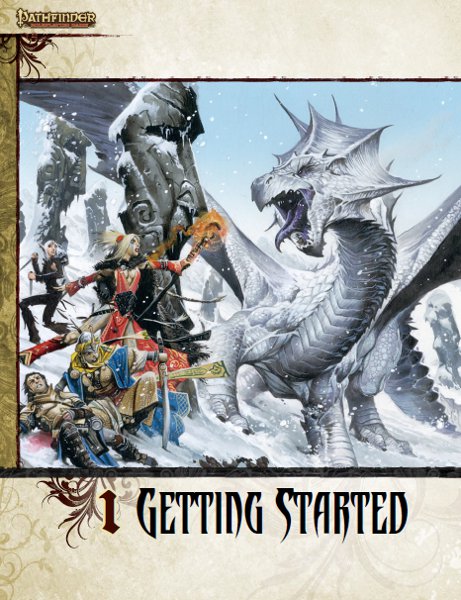
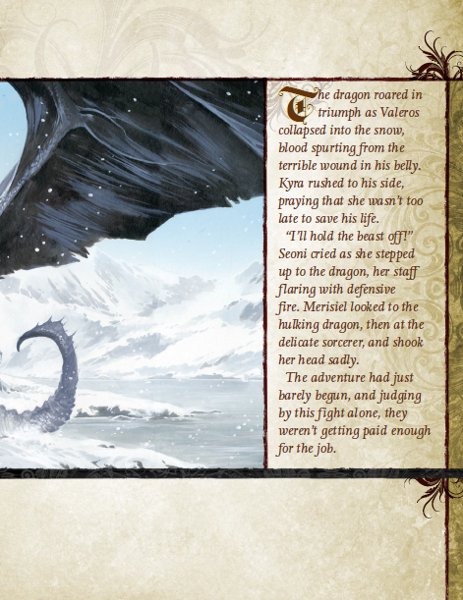
And what is the Concentration check DC for frostbitten cleavage?*
Enough faffing about, time to start on the main course.
*deep breath*

Okay, so we start out here with your "what a roleplaying game" is sort of explanation, which is honestly described pretty well.
And then they mention some things new gamemasters might need!

-
Paizo's
Pathfinder Adventure Path
series
-
Pathfinder Modules
-
Pathfinder Chronicles.
-
Pathfinder RPG Bestiary
Players might need dice (available at paizo.com, it says). You might need minis if your GM decides to use a map, and if you use a map, how about Paizo's line of GameMastery Flip-Mats? Wow. I really am speechless.
You know, for the record, I looked up Dungeons & Dragons 3.5 for comparision to see if it tried to shill supplements and supplies. In the verrry back it it has an ad for Dungeons & Dragons novels. And obviously you're going to need a Dungeon Master's Guide and a Monster Manual , but that's only aimed at dungeonmasters. What about the current edition of Dungeons & Dragons**? The back page has an ad for their online service. That's all. So Pathfinder is different in how it's marketed. Right here, from the first page of Chapter 1, it's not just trying to sell you on a game, it's trying to sell you on a game line . Paizo is, frankly, better at marketing its game, and it shows.
Then it gets into the basics - how dice are rolled, that you gain shit (gold shit, magic shit, experience shit), going up levels, adventure awaiting, etc.
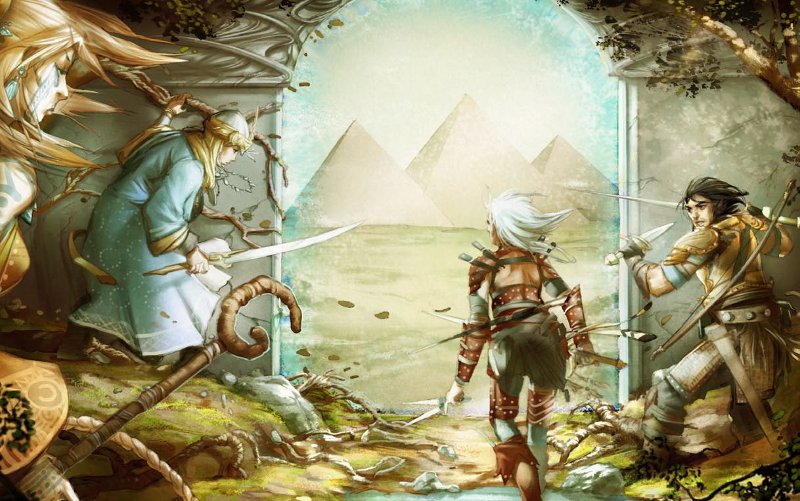
As Merisiel strode off to adventure, all eyes were on her butt.
Then we get:
Pathfinder Roleplaying Game posted:
The Most Important Rule
Oh boy.

Pathfinder Roleplaying Game posted:
The rules in this book are here to help you breathe life into your characters and the world they explore. While they are designed to make your game easy and exciting, you might find that some of them do not suit the style of play that your gaming group enjoys. Remember that these rules are yours. You can change them to fit your needs. Most Game Masters have a number of “house rules” that they use in their games. The Game Master and players should always discuss any rules changes to make sure that everyone understands how the game will be played. Although the Game Master is the final arbiter of the rules, the Pathfinder RPG is a shared experience, and all of the players should contribute their thoughts when the rules are in doubt.
Pathfinder: "We know you just paid $50 for a 576-page rulebook, but we already have faith in the fact you're going to want to throw rules out."
That way when you find out some of the rules are bad we can be like "But look at the Most Important Rule".

Anyway, then we get a chapter list, and then a listing of terms. I'm going to go out on a limb and assume most people are basically familiar with Dungeons & Dragons third edition (if you're not, here it is ), and am just going to list the major differences:
-
Combat Maneuver Bonus (CMB): A new figured value used when making fancy moves like trips or disarms.
-
Combat Maneuver Defense (CMD): Like above, but to defend against said moves.
-
Concentration Check: Unlike Dungeons & Dragons, there is no concentration skill; this is a determined value. This has the drawback of Concentration Checks being more difficult, but the upside that spellcasters no longer have to pay a "Concentration tax" out of their skill points.
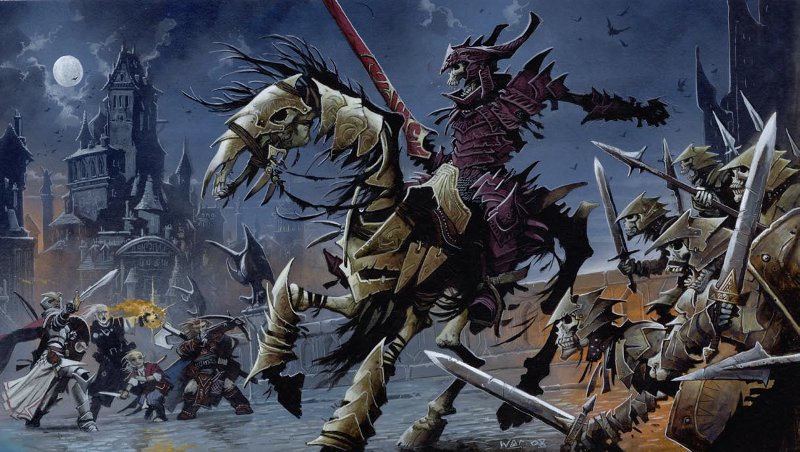
Victory goes to the most metal.
Finally, it's time for:
Generating a Character
It goes over the basic steps of character creation - ability scores, race, class, skills, feats, equipment, then stuff like name or blue/grey eyes.
Then we get into the first rules of the game.
Ability Scores
First, they cover how we're going to generate ability scores. There are five methods provided:
-
Standard: Roll 4d6 and then drop the lowest die. Roll six times, and then assign those six rolls to the six ability scores as you like.
-
Classic: Roll 3d6 six times and assign those rolls to your six attributes.
-
Heroic: Roll 2d6+6 six times and assign those to your six attributes.
-
Dice Pool: You get 24d6 you can assign to each of the six attributes, then you roll the d6s assigned to each attribute, and keep the three highest dice rolled for each attribute. You can't roll less than 3d6 for each attribute.
-
Purchase: Here you have all attributes start at 10, and then you use points provided (10-25 points) where an attribute of 14 costs 5 points, an attribute of 18 costs 17 points, and an attribute of 7
gives
you four points, etc.
Pathfinder Roleplaying Game posted:
This [purchase] system is typically used for organized play events, such as the Pathfinder Society (visit paizo.com/pathfinderSociety for more details on this exciting campaign).
- neeevermind. And if you're wondering if that's free, not quite. The Pathfinder Society requires you to buy the Pathfinder Campaign Setting: Pathfinder Society Field Guide . Only $19.99.

I'm hopping a bit forward in terms of rules to explain something. Every monster has a Challenge Rating. Every character has a Character Level. In theory, you take four characters of Character Level X and they can reasonably face a monster of Challenge Rating X and have a fight that's challenging but that they have a solid chance of winning.
You may notice that attributes - one of the core means of determining a base power level - does not figure into this. For some reason, this game assumes that a character created with "Classic" generation is equal to one with "Heroic" generation, much less somebody that rolls a plethora of ones versus somebody that throws a litany of sixes.
What's more, when you roll attributes, you're stuck with them for a long while, unless your Pathfinder game is particularly deadly. A Pathfinder campaign can last for years, and you can suffer from having a few dice rolls cripple you for ages, restrict your options, and basically punish you for having a gamemaster who's asinine enough to make you do any of the roll options listed above.
See, random attribute generation can work well for short-term games where you don't have much choice in character creation anyway. For something light and short, random attribute generation can work, because there's no need to invest overtly in your character. Pathfinder has a 576 page rulebook where your choices are fucking essential to your character's effectiveness. It should never, ever, ever restrict your choices based on a dice roll at the start.
It's like baking a pizza, and you get to flip a coin. Heads, you get to make your pizza with some fine-ass tasty dough. Tails, you get dough that literally came from somebody's ass. Flawed characters can be cool, but it's even cooler when you get to choose to play a horribly flawed character, rather than having it forced on you.
Anyway, they haven't even covered attributes yet! Well, they do now. Each attribute score provides a modifier to rolls equal to:
(Attribute Score - 10) / 2 = Attribute Modifier
Round down to the nearest whole number.
The attribute score is never used for rolls. Why would you have an attribute score in the first place? Tradition. There's no other reason to have a figured attribute for every rolled attribute , other than to give people the illusion that they're playing Dungeons & Dragons. You could easily create a means to roll and generate a modifier if you're hung up on rolling scores like some kind of troglydyte.
Yeah, I said trogs. Complete with:
Aura stench (30 ft., DC 13, 10 rounds)
In case you really are a trog (sorry, I don't mean to be mean to trogs, some of my best friends are trogs) and have come out of a cave, these are:
-
Strength: Good for lifting stuff (encumbrance), hitting things close up (melee attack), and hurting things with dangerous objects (weapon damage).
-
Dexterity: Good for doing graceful things (acrobatics, sleight of hand, etc.), hitting things far away (ranged attacks), and avoiding getting hurt (armor class bonus).
-
Constitution: Good for taking hurt (Fortitude saves and Hit Points) and not dying (death saves).
-
Intelligence: Good for knowing things (Knowledge skills) and languages (free languages). Also important for Wizards, who get extra spells from being smart.
-
Wisdom: Good for noticing things (Perception, Sense Motive) and taking mind bullets (Will saves). Important for Clerics, Druids, Paladins, and Rangers, who all use it to get extra spells.
-
Charisma: Good for being well-liked (Diplomacy, Bluff) and getting followers (Leadership). Important for Bards and Sorcerers, who get extra spells from it.
Also there is a huge chart that details when caster get bonus spells from their attribute.
The formulae boils down to this:
Attribute Modifier = X where X is the number of Spell Levels you get a single bonus spell in, to a maximum of the 9th Spell Level.
X - 4 = Y where Y is the number of Spell Levels you get two bonus spells instead of one.
Y - 4 = Z where Z is the number of Spell Levels you get three bonus spells instead of two.
Z - 4 = Fuck where Fuck is the number of Spell Levels you get four bonus spells instead of three.
Well, that's complicated. Why not just give bonus spells equal to the attribute modifier? Well. Once again... tradition.
And that's all for this chapter! Attributes! My review of them: terrible.

Next: Races & Racists.
* There are some of you that might say "Gosh, she's obviously using endure elements !" Well, congrats, she's used a valuable spell slot to fix an issue she could have solved with a parka.

** By which I mean the fourth edition of Dungeons & Dragons, which I will endeavor to generally keep out of the conversation to avoid aggravating PTSD symptoms related to the Edition Wars.
Races
Original SA post
Pathfinder Roleplaying Game Part 3: Races
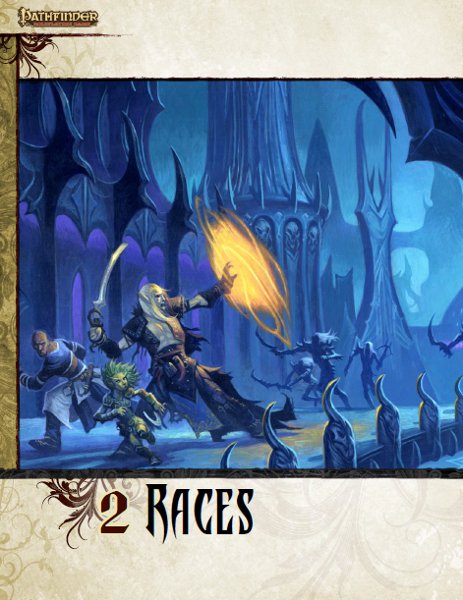
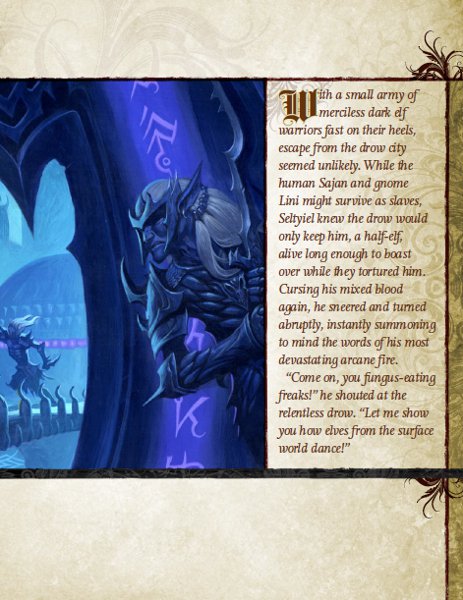
Caught in a tight spot, Seltyiel arms himself with self-loathing, racial epithets, and dance moves.
Pathfinder Roleplaying Game posted:
From the stout dwarf to the noble elf, the races of the Pathfinder Roleplaying Game are a diverse mix of cultures, sizes, attitudes, and appearances.
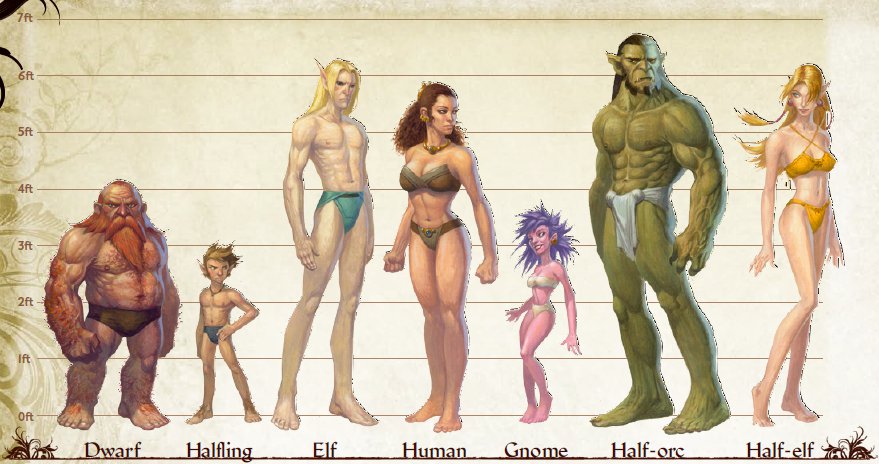
Pathfinder is a clothing-optional game.

Well. Um. Most of those look pretty caucasian to me, or close enough. Sure, some are small, and some have sharpened ears. Only the Gnome and Half-orc are really different on the skin tone spectrum.
Also, to nitpick entirely, you'll see a little black seam on the edge of the art in this chapter where it was pasted in sloppily. It really does look that way on the PDF. I hope it was fixed for the print version, but I don't have one handy to reference.
Pathfinder emphasizes the importance of race because you can't change it later on unless there are wizards involved. It at least has the decency to point out some races are really bad for some class or character choices. It doesn't get a lot more specific than that, though. Yes, it's pretty much saying "warning, traps ahead!"
Basically, each race modifies your attributes from before. Yes, it would have been nice to know what attributes your race favored before you assigned your attributes, but... traditionally the attribute section came first. Doing this ass-backwards is important because that's the way Gary did it, fuckers.
They also get a bunch of miscelleanous crap bonuses, as you'll see.
It mentions Chapter 12 has rules for playing moe powerful or unusual races. I checked Chapter 12. There are no such rules.

Now, before I dig into the races proper, I want to explain one of my theories behind Pathfinder-style design. I call it "balance by nickels", where races are given a bunch of tiny bonuses that mostly don't add up to diddly shit. In addition, fairly often a race will get some skill bonus that won't sync up with the Class Skills associated with their class, or get won't get skill bonuses their Attribute Modifers would actually assist. It's a badly thought up design theory, where many races end up only being barely-distinguishable, and hell, it's hard to remember modifiers when your race literally gets five or six of them.
Dwarves
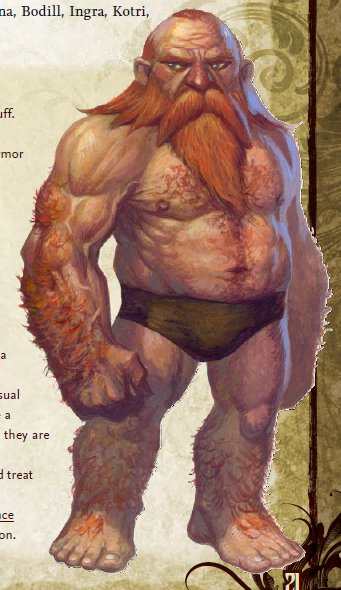
We're told "Dwarves are a stoic but stern race", as if those two terms were contradictory. They're pretty much the same dwarves from anywhere else. They live in mountains or underground, and fight giants, orcs, and "goblinoids". In fact, they are genocidal where orcs and goblins are considered, and train everybody, from the warrior to the midwife, how to murder them. Yes, dwarves are racist as fuck.
They like beards, rocks, wealth, metal, and think halflings, elves, and gnomes are a bunch of elitist fops. Because they're racist. Short and racist. And greedy.
Anyway, they're tough and wise (despite racism), but not very likeable. Not even dwarves get along with dwarves very well. They're stable on their feet, able to see in the dark, resist poison and magic, and get to use dwarfy weapons like axes, heavy picks, and warhammers. And, best of all, they don't have their speed reduced by armor!... even though other races get to run in armor just as fast as dwarves do, because the speed penalities just bring them down to dwarf level.
They're a good example of what I mean by having nickel bonuses. They get stuff like a +2 bonus (10%, or a "dime") to... notice traps or hidden doors if they're made out of stone. Oh, and they get to make checks automatically. Alternately, any other race can just pixelbitch every inch of the dungeon. They get a +2 bonus to Appraise checks!... but only where gemstones or precious metals are involved. These are the kind of bonuses that rarely come up, and are flavorful but ultimately inconsquential. Still, most dwarven bonuses do add up - for example, they get a good Constitution and Wisdom and bonuses against poison or magic that play off of that.
Play a Dwarf if you like:
-
Being an unloveable genocidal dick.
-
Being perfectly specialized for the worst classes in the game.
-
Holes, glorious holes!
Elves

Elves are like faeries, but not really, because... um. I got nothin', and neither does Pathfinder . They're also like amazingly slow chameleons, as it turns out, and have their coloration reflect their environment, which is how you'll get the
But they love kindness and beauty. Also fuck ugliness (metaphorically).
Anyway, they get to be graceful and smart, but kind of frail. They can see better in the dark, get to be better at overcoming magic resistance, resist enchantments better, and they notice things better, and all of them get to use bows and stuff.
Oh, and very randomly they gget to be immune to sleep spells. Unlike Dungeons & Dragons 3.5 , they still sleep, though.
Play an Elf if you like:
-
Being a powerful wizard!... not as good as a human, but still, you know. Well enough, I suppose.
-
World of Warcraft.
-
During a graceful lovemaking session, accidentally impaling your lover's eye with a stray ear.
Gnomes
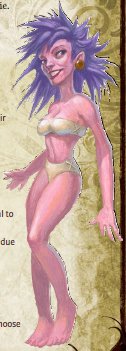
These are tiny people who are more fey than elves but still aren't fey, because! That is why. They're supposed to be weird and come in funny colors like green or pink, and have fancy animu hair. And-
Pathfinder Roleplaying Game posted:
Gnomes possess highly mutable facial characteristics, and many have overly large mouths and eyes, an effect which can be both disturbing and stunning, depending on the individual.
Anyway, they're hard workers, pranksters, tend to be mercurial and passionate, etc. They like magic and music, blah blah. Oh, and they all train to kill goblinoids and reptilian creations, so. Racist are they.
They're hardly and winsome, but physically weak. They move slowly and can get knocked around easily because they're wee, but have an easier time hitting and dodging. They see better in darkness, get to cast a few minor spells, resist illusions, get bonuses on Perception, Crafting, and get to use gnome weapons whatever the fuck those are.
Oh, and they get a bonus on a Profession skill, a skill no self-respecting adventurer will touch, since it has no mechanical use save making pathetic amounts of money in downtime. Oh, and both gnomes and dwarves get a large (+4) bonus to dodge attacks from giants, but since giants have such large strength bonuses and high hit dice for their Challenge Rating, they're generally pound the shit out of dwarves and gnomes anyway .
Play a Gnome if you like:
-
Being an annoying tit.
-
Super Deformed Kamaii Animu
-
Being a childlike cartoon character that's legally allowed to fuck.
Half-Elves

Humans and elves like to get it on, apparently, and then disown their offspring, which are half-elves. Or half-humans, maybe? Homo Elvish. Once again, we're already back to the racism.
They're big on freedom and being adaptable and wander around. Also they have shiny, colorful eyes. Like marbles! They a boost to any one attribute they want, your standard model sees-better-in-dark vision (seriously everybody gets that), they get to be better at any one skill, that dumb sleep immunity, resistance to enhancements, better senses, and they get two favored classes instead of one, a trait that is only useful if you multiclass, which is way less useful than it was in 3.5, so fuck it.
They're just kind of generic and hated by humans and elves because, that is why. Boring!
Play a Half-Elf if you like:
-
To play an elf, but have a fantastic moustache.
-
Seriously, that's all I got.
-
Yep, pretty much just an elf with a moustache.
Half-Orcs
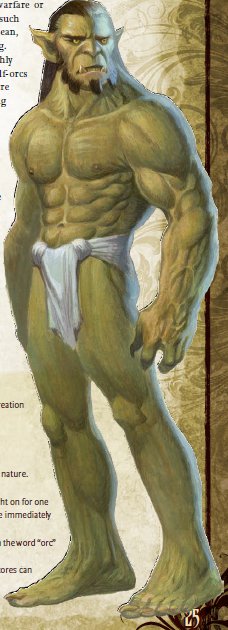
Pathfinder Roleplaying Game posted:
Half-orcs are monstrosities, their tragic births the result of perversion and violence—or at least, that’s how other races see them. It’s true that half-orcs are rarely the result of loving unions, and as such are usually forced to grow up hard and fast, constantly fighting for protection or to make names for themselves.
Yes. It pretty much starts out saying "By the way, your character? Probably the result of a rape."
So people hate on them a lot and so they get tuff, and often become good fighters and-
Pathfinder Roleplaying Game posted:
... orc leaders have actually been known to spawn them intentionally, as the half breeds regularly make up for their lack of physical strength with increased cunning and aggression, making them natural chieftains and strategic advisors.
Egh.
Anyway, most half-orcs are tough on the outside but softies in the inside. Elves and dwarves hate them, because racism.
They get a bonus to any one score as they like, just like half-elves, so they can be smart or charming, they can see in the total dark, they get bonuses to intimidate, and can fight for one round when they'd normally fall over. Which is kind of neat, but half-orcs are just kind of lousy compared to the other races we've seen so far. See, back in 3.5, half-orcs got less in terms of racial benefits since they got a bonus to Strength, and the designers falsely thought Strength was the best attribute. But here, they get less benefits because... um... they get less benefits.
Play a Half Orc if you like:
-
Playing a weaker race to prove your roleplaying masochism chops.
-
To be a orc, but this game only includes half-orcs and not orcs because
racismtradition.
-
Just writing "rape" repeatedly for your written background.
Halfling
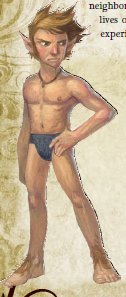
They're half-human and half-ling- wait, what? They're not that? This game is confusing with names.
Anyway, they're cheery, lucky wee folk, but they don't get a pot of gold or anything. They're cowards, but sometimes get into trouble because of curiousity. Also they like to walk on bare feet. Wow, these guys sound a lot like hobbits.
They only have small towns or live in the bad parts of town. They're good at hiding, tricking folks, and taking their shit. They get along with gnomes really well. Also they're magically lucky and often go off on adventures like in that one book about the Rings.
Yeah, yeah, we all know where a lot of these races come from, I just find it amusing all these years later and we still see this race nabbed from one of the most famous fantasy novels so shamelessly. At least other games try and give them some twist or alteration. There's no twist here. These are skinny hobbits.
Anyway, they're agile and charming, but weak. Like gnomes, they're small, and get bonuses against fear, a bonus on noticing things, climbing and being agile, and they get to use slings (exciting!). Oh, and the luck they kept talking about? Halflings get a nickel bonus - a +1 to all saves - that's it. That's their fancy luck.

Play a Halfling if you like:
-
Kender.
-
Feet. Mmm. Feet.
-
Giving the finger to destiny.
Humans
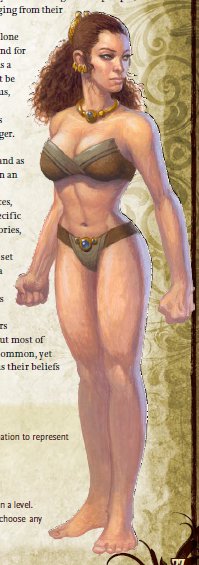
Who let these jerks in?
Humans are the dominant race, they're really varied, come in a variety of skin colors from brown to not brown, they're ambitious and ingenious and flexible and :wank:
Also they fuck and make lots of babies. Well, they don't say it that way, necessarily:
Pathfinder Roleplaying Game posted:
Humans are fecund, and their drive and numbers often spur them into contact with other races during bouts of territorial expansion and colonization.
Humans tend to see the other races as stereotypes, which is is convenient, because they are, except for elves, they're hot for elves. They can be evil or good and blah blah vague shit blah blah more vague shit etc.
Anyway, humans get a bonus to one ability score, a bonus feat, extra skill ranks, and... that's all. That may not sound like much, but generally they're the best race. Why? Because they can just specialize in whatever class they want with that feat and those skill points. And that extra feat? Most classes have to wait two levels and about 40 encounters (seriously, I mathed that shit) to get that second feat. Of course, they'll have to spend it wisely, since the feat section is laden with the trap of crappy, crappy choices.
Play a Human if you like:
-
To get a bonus feat.
-
A bonus to baby production checks.
-
Really just the bonus feat.
Next: Classes! Or: nerds rule, jocks drool.
Classes
Original SA post
Pathfinder Roleplaying Game Part 4: Classes
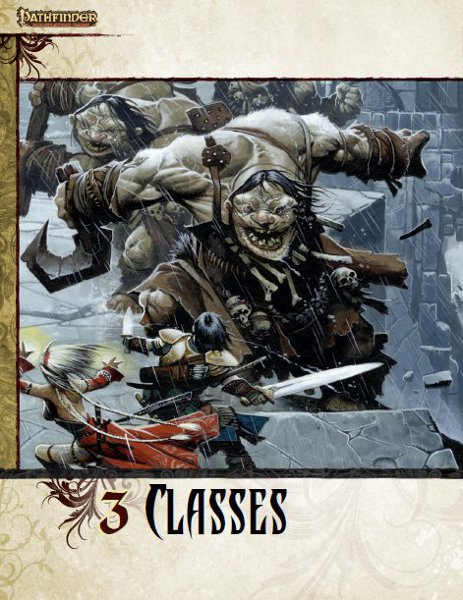
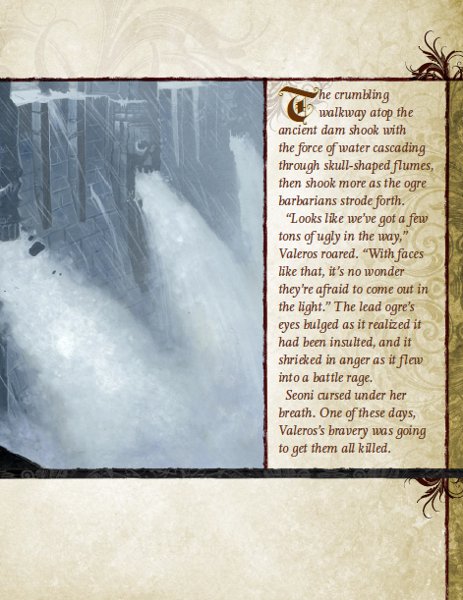
Or raped, Seoni.

Time for classes!
Well, first it starts with character advancement. Most of this is the standard from Dungeons & Dragons 3.5 , though there are some differences. There are three experience point tables - slow, medium, and fast, which the gamemaster decides from. Also, favored classes have changed. Instead of incurring an XP penalty for multi-classing too much, each character chooses a favored class. Every time you take a favored class, you can gain an extra skill point or hit point, which is a welcome improvement from Dungeons & Dragons 3.5 .
Don't get too hopeful, mind, we're about to talk about classes.
Barbarian
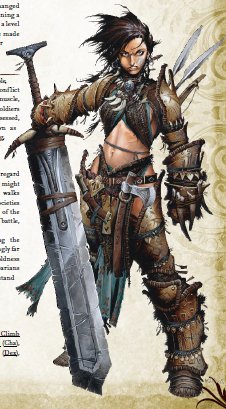
Cue victory theme.

Apparently, all fighters that ain't urban don't bother training as warriors. Instead, they become barbarians, who just charge at people like maniacs. It would have been better named "berserker", but... sigh... tradition. Anyway, they're warriors that go crazy, flip out and murder things.
They get to be solid frontline combatants, and get the most hit points of any class, improved movement speed, the ability to rage out and get strong but careless, reduced damage taken, and can sense ambushes. Also, they get a bonus to avoid traps, but since their base ability to avoid traps isn't very good anyway, it's a shit bonus.
Rage is their core ability, but it's got problems. It only lasts for so long, so they've got a time limit to their ability which is X amount of rounds a day. Which means barbarians pretty much just need to deal damage. They don't have the luxury of being able to pull fancy moves too often, because they need to take enemies off the board before they become fatigued and their damage-dealing capability really drops. So they're effective at what they do, but it ends up being a boring, repetitive thing to do.
The big thing that Pathfinder adds are Rage Powers, which are special abilities the barbarian gets while raging. But the balance is all over the place with this stuff, from getting to rage again after your rage runs out (fantastic) to niche and dumb, like being better at jumping or swimming while raging (NSFW) . Or really, really dumb, like superstition , which gives you a +2 to save against spells... but you have to make saving throws against all spells, including buffs and healing thrown at you by other party members. That's possibly a death sentence if your rolls go awry. Not exactly worth a +2.
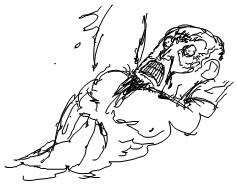
The angriest backstroke.
The real problem with bullshit like raging climbing or raging swimming is that you get X rounds of rage a day, which means you're spending your combat effectiveness to clamber a wall, most often. What's more, it doesn't really improve your swimming or climbing speed appreciably, so you have a very short window of time to swim across a river or climb up a mountain, after which if you haven't gotten to the shore or the top and are suddenly fatigued, which can put you in a real bind.
To be fair, there are some handy combat abilities, especially as you go up in levels. But how those abilities are implemented has been done with little thought to their implications or actual usage.
Oh, and a side note: rage increases your constitution (and thusly your hit points), and you gain constitution from it, but- when you fall unconscious, you go out of rage. Which means your constitution drops, your hit points drop, and chances are you either die instantly or fall very near death, since you just lost your (level x 2) in hit points.
But all and all, barbarians are probably one of the more effective nonmagical classes - they're just boring because of their laser-like focus on "roll to hit, roll damage" ad infinitum. Firmly middle of the road, and one of the few classes Pathfinder didn't really power-up.
Bard
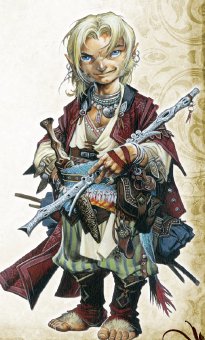
Aaaa he has monkey feet aaaa-
Bards are magical performers, but also jerks-of-all-trades for some reason. Really, they're like a bunch of class features were left in a pile and assembled into a class. They know how to use swashbuckling-type weapons! They cast arcane spells! They can buff friends with magical music! They have sage-like knowledge!
They get middle-of-the-road hit points, good skill points, the ability to buff via magical performances, a bonus to knowledge checks, and... uh... a bonus against the magical music of other bards. They also get spellcasting, which is pretty huge.
Unlike Dungeons & Dragons 3.5 , you don't actually have to take Perform to most Bardic Performance uses. This is good in that the bard is not longer taxed out of skill points just to use their core ability. This is bad in that the buff effects require no Perform ranks, so you flail on a broken guitar and give your party courage, somehow.
Another key difference from Dungeons & Dragons 3.5 is instead of having X uses that last X rounds, the bard's music is tracked by having X rounds per day instead. This means the bard has to balance noncombat uses and combat uses much more closely, especially since noncombat uses inherently consume more usage.
The really big drawback of bards is a lot of their buffs are matched by the spells of clerics and other spellcasters. It seems like it's a unique buffing ability, but it really isn't.
The spells of bards tend towards illusion and enchantment spells, with some divinations. At low levels than can do things like mind control people, create illusions, put people to sleep, summon monsters, etc. At the top level they can see far away, get large buff spells, force people to dance, etc. They get spells slowly compared to full spellcasters, but faster than token spellcasters like the paladin or ranger.
Ultimately, bards are solid in that they can at least do many things at a moderate level of competence, and really shine outside of combat or in social situations. They're also boosted a lot by the Leadership feat, which basically lets them break the game with the use of buff spells and numerous followers.
Cleric
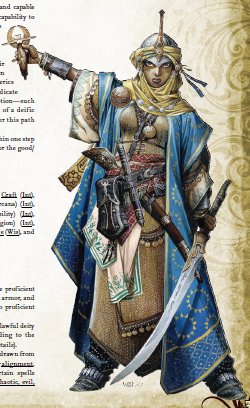
Don't worry, her goddess handles the cleavage end of things .
Fuck us, it's the cleric.

Dungeons & Dragons 3.5 overpowered this class in response to trying to make healers fun to play, and Pathfinder apes that mistake. Though they get middling hit points and low skills, they get plenty of devastating abilities. They're the most robust divine spellcasters in the game, since they get full spellcasting, the largest divine spell list, and domains, specializations that add to their spell list. Unlike most other spellcasting classes, they can completely swap their spells everyday, and aren't restricted to a list of chosen spells or a spell book. That means every time you add a supplement to the game, they get a whole new bunch of powers.
They also get the ability to channel energy, Pathfinder 's replacement for the old turn undead ability. It's thankfully cleaner rules-wise, and is also more reliable, since it practically always works, but less powerful in some ways. Essentially, good characters channel positive energy, which heals all living creatures around them and damages undead. Evil characters channel negative energy, which heals undead and damages living creatures. Neutral characters get to pick one or the other. They get to use this 3-6 times a day or so.
Then there are Domains. Domains give the cleric some bonus abilities that work like spells, and a extra set of spells they can prepare. The thing is, the balance is all over the place with this shit. Take, for example, the Artifice Domain, which lets you use mending at will. Sounds great? Mending is a 0-level spell that any Cleric can prepare. 0-level spells can be used at will. Yay! You just wasted a Domain, practically. Or you could take Liberation, which gives you the ability to cast freedom of movement for a limited time each day, at 1st Level. Freedom of Movement ordinarily requires you to be 7th level to prepare it, and lets you do things like automatically escape grapples. Yeah. Which would you like?
Oh, and if the ability for the cleric to cast healing / hurty spells isn't enough, with channel energy on top of that, they also have the ability to spontaneously change any spell they have prepared into a cure spell (if good) or a cause wounds spell (if bad). Yep. If it wasn't enough that they get to choose any spell on the list, they don't need to worry about preparing healing spells, since they can just discard any prepared spell to cast them.
What's more, their spell list is one of the better ones in the game. At 1st level they can do things like buff the entire party and penalize all enemies (no save). They can speak any language. They can create an area where no violence can happen. They can walk in the snow naked without harm.
At higher levels, they can heal practically any malady, raise the dead, find traps like a rogue, paralyze creatures, know if any idea is good or bad, summon angels and demons, mind control people, turn into mist, etc. At the top levels they can have their god directly intervene, travel to other worlds, negate all magic in an area, and so on.
Angel Summoner and BMX Bandit ? Hell, Angel Summoner could only summon angels . A cleric can summon angels, make people implode, control the weather, and know if you've been bad or good and where to find you. Hell, they can bring back a person's that's been dead for a century even if they don't have the body, even if the body is in another universe, just bam, back to life.
Oh, and they fight pretty well and get to wear armor. If they violate the tenets of their god, they lose their powers, but since these tenets are entirely undefined in the class description, I'm just going to assume they don't exist.
Druid
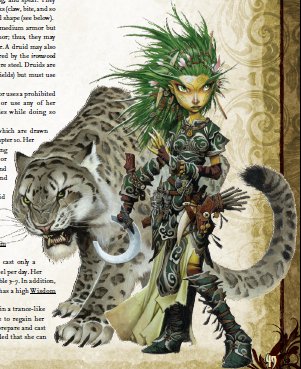
Big eyes, small mouth.
These are people who get power from worshipping nature. Not a god, or anything, just nature is like, bam, you are now magical . Okay, they master "primal magics", but how they learn or find those magics...
 Anyway, they're like clerics, but get more skills and wear crappier armor. They get full spellcasting, but have a more limited set of nature spells. They can also drop any spell they've prepared to instead summon a fightin' animal.
Anyway, they're like clerics, but get more skills and wear crappier armor. They get full spellcasting, but have a more limited set of nature spells. They can also drop any spell they've prepared to instead summon a fightin' animal.
They can either gain an animal companion or choose a cleric domain, but they have a limited list of domains that seems to have been picked from "worst domains clerics can choose". Animal is the best one they get, ironically, and it's entirely fucking redundant for them. On the other hand, their animal companions get to level with them, gain magical powers, get bigger, etc.
There's also a bunch of random nature abilities they get, befriending animals, walking through brambles unhurt, can't be tracked, good at resisting faerie magic, etc.
The big bugaboo ability they get - and it's a doozy - is wild shape. Ever wish you could fly at first level? Well, just turn into a bird. At later levels, being able to become a bear or elemental starts to make them into devastating combatants that well exceed most combat classes in the long run, especially since they can team up with their animal companion for double magic bear action.
Oh, and did I mention they're full spellcasters to boot? I did. Like clerics they get to cast healing spells, and even at low levels they can throw fire or bind people in vines. Later on they get to call lightning from the sky, attack you with giant bees, or turn you into a sloth. At the highest levels, they can see anywhere, make people die, summon a "swarm" of elementals, or create a tornado.
The big difference from Dungeons & Dragons 3.5 is that they only get buffed by wild shape, rather than morphing into a whole new set of attributes. Without any doubt, their power level has been reduced. That being said, it only changes them from "insanely strong" to "insensibly strong".
Definitely comparable with the cleric. Not as cosmically powerful, but their ability to shapechange, summon creatures, have a companion, and so on, lets them fill in a combat role with or without genuinely risking their own hide.
Fighter
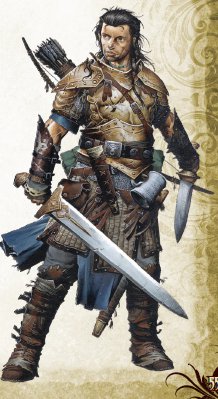
"Madmartigan? Never heard of the guy, I swear!"
Or you could play a fighter. They get to swing a sword, or fire a bow, or use any weapon they like! They get a strong amount of hit points, though not as much as the barbarian, but for some reason are as unskilled like clerics or sorcerers, even though they don't have spellcasting. So what do they get?
Feats. Remember the whole idea of nickel bonuses I discussed in the race section? Feats are nickel bonuses writ large. Most provide +1 and +2 bonuses to this roll or that roll, generally in a narrow circumstance. So, for example, an iconic feat they can pick up is Weapon Focus, which gives then +1 to hit with one type of weapon. So if they choose a longsword, it doesn't apply to rapiers or shortswords. Hell, they have to be 4th level to pick up Weapon Specialization, which gives them +2 to damage with a single weapon.
For contrast, barbarian's rage gives them +2 to attack and damage at level 1 with just whatever weapon, and they get bonus hit points while raging on top of that.
What's more, Pathfinder has taken time to reduce the power of some fighter feats from Dungeons & Dragons 3.5 . For example, Combat Expertise. Combat Expertise used to let you add +1 to your Armor Class for every -1 you took to hit, and was limited by your attack bonus (to a maximum of +5 / -5. Now, it's +1 / -1 at level 1, with another +1 / -1 for every four levels you have. So instead of waiting for 5th level for the feat to max out, a fighter has to wait until 16th level .
So by the time a fighter gets a -5 to hit and a +5 to Armor Class, a wizard can cast limited wish and a cleric can cast resurrection .
Granted, the fighter has gotten token improvements. They get a bonus against fear effects, reduce penalties from armor, gain bonuses to hit and damage with a specific group of weapons, etc. But they're tiny bonuses that don't scale on any level comparable to spellcasters.
What's more, since they don't have any skill points, they're not much good outside of a fight. What's more, there are classes that are better at dealing and taking damage (barbarian) or good at dealing damage and noncombat functionality (ranger, rogue).
But it could be worse, it could be a...
Monk
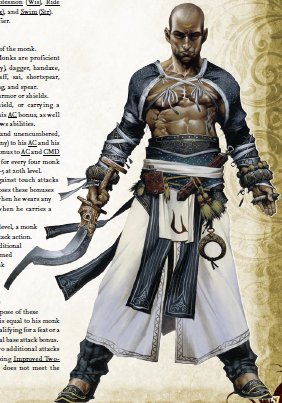
Monks are basically the result of Brian Blume really liking Chiun from the Remo Williams books, and thus that Asian stereotype was passed on, and now Pathfinder picks it up blithely, and carries it on through a distorted game of racial stereotype telephone. Dungeons & Dragons 3e tried to buck the stereotype by making their iconic monk an African woman, but Pathfinder brings it back to form with an Asian man.
So. They're good at being disciplined and punching people. They get a middling hit die, a bad sign for a melee fighter that doesn't wear armor, middling skills, but very good saving throws. Ironically, for a class that's supposed to fight close in, they get a weaker attack bonus than any other melee class, for no apparent reason. They get a bonus on their Armor Class from their Wisdom Modifier when not wearing armor, which is pretty much there to keep them from being totally screwed from the fact it requires them to not wear armor. They get extra attacks and improved punching damage as they level up, but most of that isn't valuable until later levels. Their average attack bonus, lack of magical weapons, and penalties for multiple attacks means they don't hit very often when they do their "Flurry of Blows".
They get a vast array of abilities that looks impressive, but the major issue is that they specialize in nothing enough to shine. They can heal themselves, but nothing like a cleric or paladin. They can move quickly and jump high, but that doesn't match up to a flying wizard. They can dodge area attacks, but not as well as a rogue. They can teleport or gain spell resistance, but not as soon or effectively as a sorcerer or wizard. They can avoid falling damage, but under more limited circumstances than a sorcerer or wizard. And so on.
What's more, their movement abilities conflict with their flurry ability. Their flurry ability requires them to stand largely still. Ever see those wuxia films where characters just stand in one place while punching at each other for the whole fight? Me neither, but the monk has to make a choice between flitting around and actually doing damage.
They do get stunning fist, which lets them inflict status effects once they overcome their mediocre attack chances, or quivering palm, which is strong a save-or-die effect. They also get a ki pool, a pool of points which they can spend to bypass damage reduction, do an extra attack, or improve their ability to dodge for one turn.
All the same, they have to wait until their later levels to start getting impressive abilities, and once they do, classes like clerics and sorcerers have reached their stages of cosmic power.
Oh, and if they become nonlawful, they can't advance their abilities, because Pathfinder equates personal discipline with your moral leanings for some reason.
Perhaps the biggest dissapointment, unlike Chiun, you don't get a set of class abilities based around being a bitter, racist old man, so really it falls down in just about every respect.
Paladin
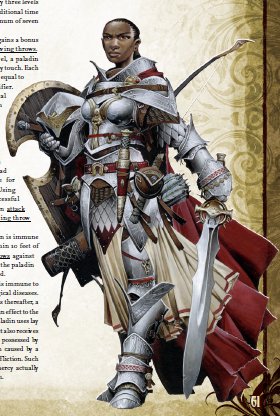
Note the chink in her armor right between the breasts.
These are holy champions who gain power from... um... it doesn't really say clearly. From being good and lawful, I guess. Worship isn't mentioned anywhere in the class description, so I guess the Pathfinder world just rewards being a disciplined, benevolent guy on a horse. There's no talk of them being taught magic or anything, they just get it.
Anyway, they get to be magic warriors, kind of like fighters that get divine powers instead of feats feats feats. They can sense evil, do extra damage to evil creatures, solid saves, the ability to heal with a touch, bonuses against fear, immunity to diseases, and later on they get the ability to heal status effects. They can channel energy like a cleric, but not as well, a special magic weapon or magic riding animal, and finally they get a short list of spells to cast.
Their smite ability got changed from 3.5 from it being a X uses per day ability to where when they smite, they get to smite repeatedly until their foe's dead. This is a huge damage increase for them.
Their spells only go up to 4th level over 20 levels. Most of their powers just buff or heal, with a few lie-detector spells. At the lowest levels they're just improving a weapon or shielding other characters from damage, and at the top end gaining a powerful holy sword or neutralizing poisons. It's a very limited list, and contains a lot of redundancy - a lot of the later spells are just improvements or variations on earlier spells.
They lose their powers if they perform an evil act or violate a particular code of conduct, but the game doesn't really define what an evil act is, so it mainly serves as a vehicle to inspire GM / player arguments. (Do a search for "grognards.txt" and "paladin" for just a small taste.) Oh, and if they lose their powers, they need a cleric to cast a spell to give them a chance to regain their powers.
Ultimately, paladins are supposed to be clerics what fight better, but the problem is clerics' robust spellcasting list actually lets them replicate most of a paladin's abilities and surpass them. The paladin is a better fighter early on, but quickly gets outpaced, and has abilities solely around healing, preventing, or dealing damage... but when not facing evil or chaotic foes, much of their utility fades away.
What I say is: play a cleric, buy a horse, take the war domain, and be a superior fascimile. If you want to be a paladin, you can at least say "Well, it could be worse, I could be a fighter." Paladins get to be a lot better than their Dungeons & Dragons 3.5 counterparts, but they're not in the big leagues.
Ranger
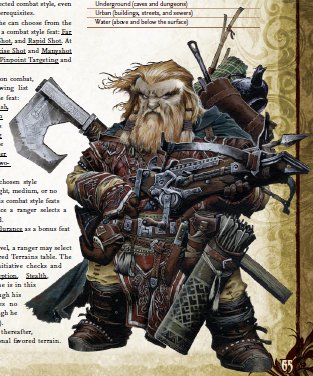
Ugh.
Look, over there! It's Aragorn. Hey, Aragorn!
Aragorn says hello.
This is the class to be if you want to be a Ranger of the North from Lord of the Rings. Like the not-Hobbits earlier, or the Monk just before, D&D is just like "Let's take this character and call it a class! It's the perfect crime! No one will ever know! "*
Aragorn says to shut the fuck up and talk about his class before he jams a piece of cram into my eye.
Rangers are tough and fighty like fighters, but are skilled like bards. They get favored enemies, which are class enemies they get bonuses against, and favored terrains, when are terrains they get bonuses in. As such, they're a "GM-dependent" class, and get to play the fun sub-game of making educated guesses of where and what will be included in adventures, and hoping they get their bonuses to apply! It's exciting because it's risky.
They also get a choice of an animal companion, like a bard, or the ability to boost their friends against favored enemies. They also get bonuses on tracking, taming animals, and evading traps and explosions. They also get a choice of getting bonus feats for bows or paired weapons. Why the latter? Aragorn, bitches.
They also get nature-spells, like shitty druids. Most of these have to do with healing, animals, plants, or generic utility like a magic alarm. So they can enchant animals, run faster, or at the top levels they can teleport using trees or move through any impediment through freedom of movement - remember that spell that Clerics of liberation get at 1st level? Rangers get it at 12th.
Ultimately rangers have it decent. They're to druids what paladins are to clerics - a melange of fighter and a casting class, but unlike paladins, they have more useful skills and less redundant spells. They also get to fight pretty well.
Firmly middle-of-the-road along with barbarians and bards- Oh shit, MY EYE!
FUCK YOU, ARAGORN! YOUR BOOKS WERE BORING AS SHIT! Fuck, *ow*.
* A genuine quote attributed to Gary Gygax, no doubt while rubbing his hands together fiendishly.
Rogue
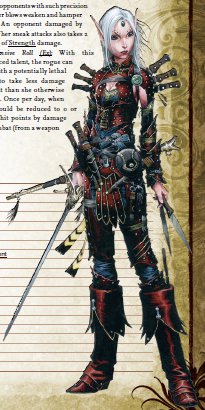
Merisiel,
Rogues are more assassin than assassins. Oh, sure, they're supposed to be replacements for thieves, but their core ability is murdering people by stabbing them by surprise and doing a bunch of extra damage when they do it.
Oh, sure, they can just knock people out with a sap, I suppose, but fuck, this is Pathfinder , where people leap around fighting tiger-wizards. There will be stabbing.
Rogues also get bonuses against being surprised, can avoid area spells and traps better, get a bonus to find traps... but see, there's been a change. In Dungeons & Dragons 3.5 , only rogues could sense a trap of sufficient complexity. Now that's no longer true, so the rogue trapfinding ability is devalued greatly. Which is why many variant Pathfinder rogue classes "sacrifice" the trapfinding ability, as if it were a sacrifice in the first place.
Also, rogues get rogue talents. These are a variety of abilities, from the useful - a bleeding attack that causes damage over time - to total garbage - the ability to crawl faster on all fours. Whee! Look at me, I'm adventuring like a baby!
However, rogue talents can also be exchanged in for combat feats like a fighter gets, and the rogue gets them at the same rate. Later on, they can choose any feat. They also get the best skill selection in the game.
So they're like fragile fighters, but are way more useful outside of a fight, and can potentially do crazy damage with their backstab. Unlike Dungeons & Dragons 3.5 , their sneak attacks work on most sorts of creatures, except blobs. And unlike fighters, their ability to deal damage seriously ramps up as they level, given they can get the right angle on their foe.
Ultimately, they're the best class that doesn't have magic powers of some sort, since they rule the skill check, so they're useful in a variety of non-combat situations, and have high damage potential in combats. Even in combat, they can take talents like resiliency and defensive roll that grant them increased survivability.
It's a more interesting design, though, and looking at rogues is like a glimpse at how much better non-casters could have been designed. They're still dwarfed by non-casters, but they're at least a lot less sloppily designed.
Speaking of sloppily designed...
Sorcerer
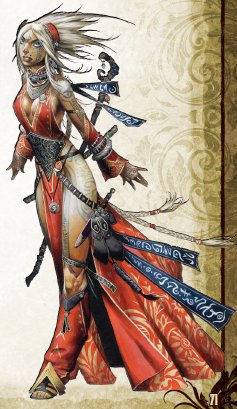
Mandatory Achewood reference
Sorcerers are magical slackers. They just get magical powers from their heritage and don't have to do the hard work like their more nerdly wizards. That's why they're weaker than wizards, and in fact, weaker than all the other full spellcasters in the corebook. They're just too saucy to gain nerd power.
Anyway, they get low hit points, low skills, but that doesn't matter, they get access to the best spell list in the game. Fire energy bolts that hit people automatically! Put people to sleep! Shrink people! Fall from any height safely! And that's just first level... at the top end, they get to teleport, kill with a word, stop time, or wish for whatever they like.
But that's not all!
They also get to ignore minor material components when casting spells (not a huge deal) and also get to choose a bloodline. As you may have guessed by now, some are fantastic choices and some are terrible choices. Each gives magical powers, bonus feats, extra spells known, another skill, and a special ability for your spells. Like Draconic, which gives you great spells like spell resistance and fly , and gives you a bonus skill in the form of Perception, the most-used skill in the game. On the other hand, there's Celestial, which gives you Heal, a useless skill for any party with magical healing, and terrible feats like Mounted Combat and Ride-By Attack (not too useful once the bloodline gives you wings ...).
The big drawbacks sorcerers face is having to dump their attribute points into a lousy attribute (Charisma) and they have to choose their spells they know as a subset of their actual spell list, and don't get to change them very often. They also don't get very many spells, and high attributes don't improve it.
Still, they have high potential for smart play, and later spells let you upend the game system and slap it silly.
Wizard
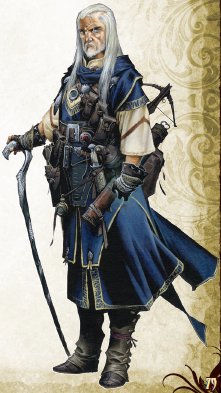
World's Best 1st Level Grandpa
The best for last. These are ubernerds that learn magic by reading books and learning math and recipes and shit like that. They are, most likely, the most potent most versatile class in the game once you start getting to the mid-to-later levels.
They get the same spells as general class layout as sorcerers, only they get to choose every day what spells they want to prepare from their spellbook., and can spend time and money learning new spells without leveling up, unlike a Sorcerer. They are the nerds supreme, focusing on intelligence, and so get decent skills as a side effect, even though their basic skill ranks are on the low side.
Oh, and they get to choose either to have a magically empowered item or a familiar animal. Also, the item can we used to give the wizard and extra spell slot. They also get a handful of bonus feats every five levels, but can only choose magicky feats. Not much of a drawback, given a wizard focuses solely on spellcasting most of the time.
They also get to choose a specialty, which allow them to focus on a single school of magic. You're going to want to do this, because you get a good deal more spells you can use every day through this effect. Specialties also give special magic powers only that specialty gets. And yes, some are crap and some are great, not just because of the powers, but just the fact that the schools are badly balanced, with some getting more or better spells than other.
For example, the conjuration school covers all summoning, has numerous useful attack and defense spells, or... you could go with abjuration, which is a one-trick pony of defense, with numerous spells that are redundant, and defensive magical abilities that don't stack with each other. Or you could play a universalist, and fuck you if you do, because you get no bonus spells at all, ha ha. Ha. Ha. Cue cartoon sequence where your head turns into a candy sucker. Also, they get all their specialty powers by 8th level, after which they can prestige class without giving up class abilities at all if they build themselves right.
But in any case, wizards get to turn invisible, see anywhere, teleport, throw fire and lightning, create illusions, mind control people, raise zombies, summon monsters, slay people with a word, turn into a dragon, create gates to other worlds, and, of course, wish for anything they like.
And if they don't like the powers they have, they can just choose other powers from their spellbook.
Or you still could play a fighter and get piddly bonuses to hit and damage. Your call! Pathfinder is all about choice . Granted, some of those choices are ice cream and some are ass cream, but that's part of the challenge of Pathfinder - having to play the mini-game of optimization, and learn which traits are worthwhile and which are worthless.
One Last Word
The thing about Pathfinder classes is that they look balanced to the beginner's eye. That is, let's put the monk progression list and the wizard progression list next to each other.
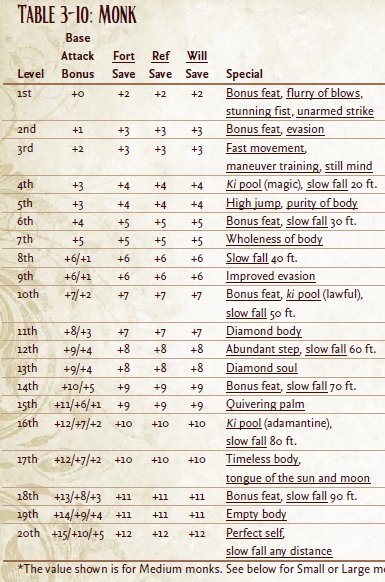
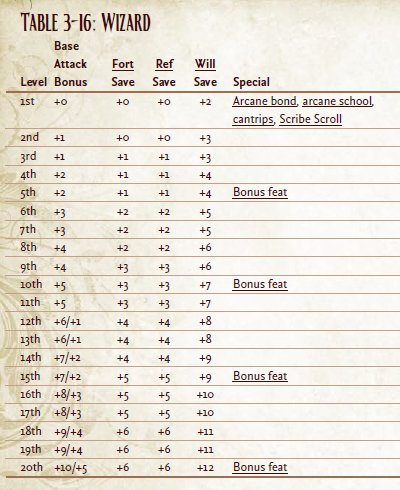
Which looks more impressive? The monk's, of course. The wizard has a lot of white space where it looks like they're not progressing, when in truth they're leaping and bounding beyond the monk.
Pathfinder is good about the illusion of balance to those that don't analyze the utility and effects of different class abilities. Once you realize spellcasting is broken, or that most feats are shit, though, the whole thing falls apart like a crumbly cookie.
And, honestly, having tons of options is fun! Even sometimes realizing what abilities benefit you and which don't can be fun; there's a sense of discovery, of finding hidden treasure and outwitting the character system.
But it's bad design , and punishes those unwilling to get out the scale and set different options against each other. It was a big leap forward when Dungeons & Dragons 3rd edition came out to offer more interesting mechanical options than Advanced Dungeons & Dragons could ever manage, but Pathfinder does very, very little to advance the game it's based on. It rounds off some of the edges, but that's it.
Next: Skills, or what you're stuck using when the spellcasters are napping.
Skills
Original SA post
Pathfinder Roleplaying Game Part 5: Skills
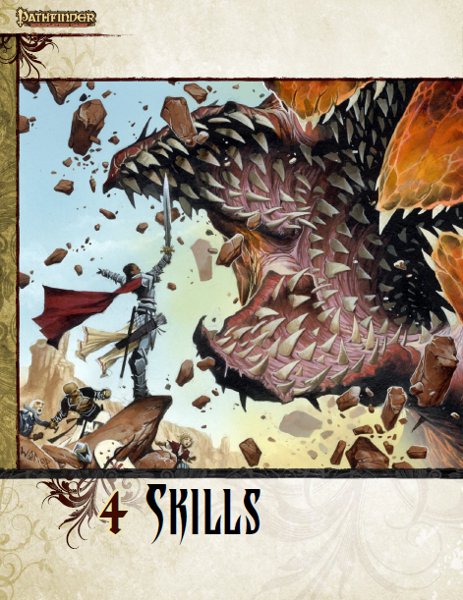
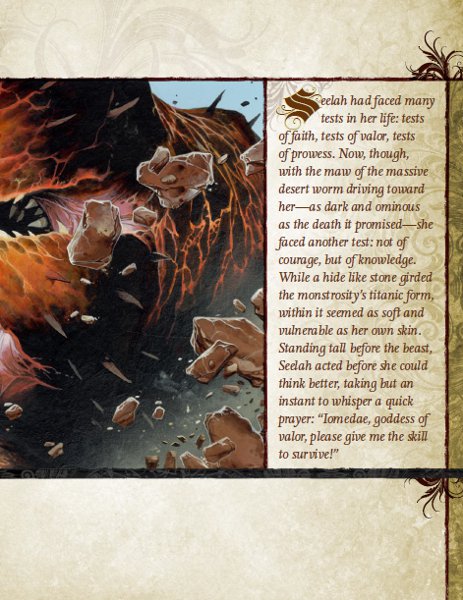
"And so, Seelah prepared to penetrate into the soft, wet spaces of the worm."
So. Every character gets skills based on their class. The amount of skills is shown on the list below:
-
Two Scoops:
Rogue
-
One Scoop:
Bard, Ranger
-
Fun-size:
Barbarian, Druid, Monk
-
Store Sampler:
Cleric, Fighter, Paladin, Sorcerer, Wizard
Of course, this is a little deceptive, since Wizards will jump up to "Fun-Size" or "One Scoop" based on their Intelligence attribute. No other class focuses on Intelligence, though many rogue players like to buff up to "Three Scoop Sundae". Of course, humans get more skill points for being human.
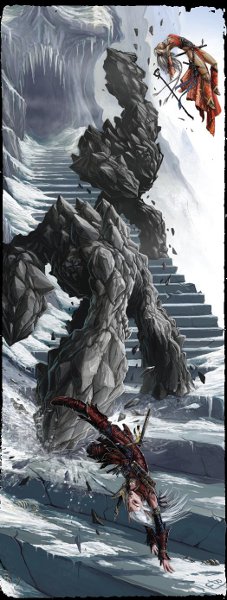
Shoryuken.
Now that we're done with those scientific measurements, I'll note the big change: there are no longer cross-class skills. Anybody can buy any skill, which is a big advantage for the "store sampler" folks, who before had to pay extra for some of the best skills to try and "balance" them. Not anymore! Good news for the fighter, fantastic news for a wizard.
Instead, each class skill you have gets a +3 bonus to rolls with it, and you can't have more ranks in a skill than your level. A much cleaner way to do it, but as mentioned, it devalues skill monkey characters like the rogue somewhat.
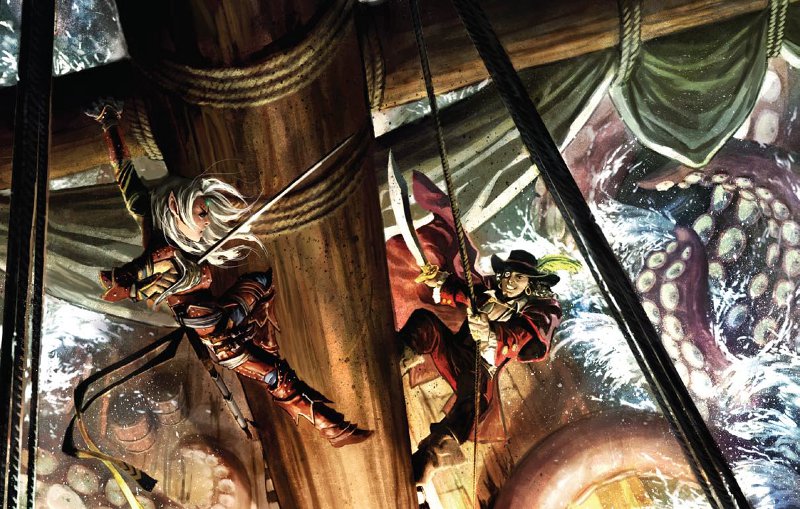
This is actually pretty rad.
The skill rolls are otherwise the same, you're rolling attribute modifier + skill ranks and trying to beat a number on d20. You can throw away the d20 if there's no risk of failure and just take a 10 for your roll instead, or 20 if you take 20 times as long to perform your action.
So let's see the skills. A lot of skills have been consolidated to reduce the amount of overall skills, which is good, though multi-focus skills like Knowledge are still massively bloated. But here they are: lot of skills have been consolidated or eliminated.
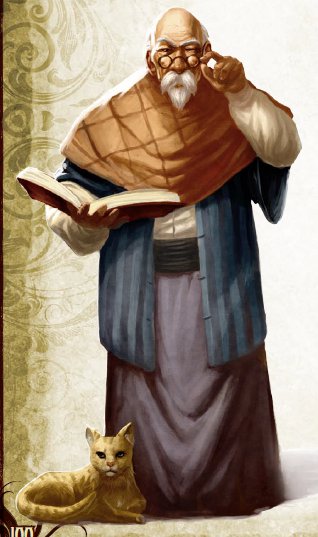
Old man, cat. (I can't always come up with something.)
On to the march of skills!
-
Acrobatics:
This lets you walk on narrow surfaces, flip over monsters, jump, or roll with high falls. This combines the old skills of Balance, Tumble, and Jump. Also, this makes jump checks Dexterity-based instead of Strength-based, so raging barbarians can only bunny-hop.
-
Appraise:
Find out how much things cost. The DC has been notably increased from
Dungeons & Dragons 3.5
(from 12 to 20).
-
Bluff:
This lets you lie, feint, or give people secret messages. It also has the difficulty where you can get people to believe impossible things. This is opposed by Sense Motive, which some NPCs won't have. Did you know that blue, green, or white dragons have no Sense Motive ranks. "How did you defeat the ancient green wyrm?!" "Oh, convinced him logically that he was a watermelon, then... coup de grace."
-
Climb:
This lets you, uh, climb. No big changes here.
-
Craft:
This lets you make things. It's divided into
21
sub-skills, one of which is, yes, baskets. Or pottery! Be the finest pot-maker in all of Legendaria! You have to buy them all seperately, in the interest of punishing people who want to take this niche downtime skill, the jerks.
-
Diplomacy:
This helps you persuade others. Unlike Bluff, there is an upper limit, and the rules on figuring your difficulty have been cleaned up from
Dungeons & Dragons 3.5
into a standardized formula.
-
Disable Device:
This lets you pick locks, disarm traps, and generally muck with mechanical devices. This combines the old Open Lock and Disable Device skills.
-
Disguise:
This lets you look like other people. Not quite so useful in many monster-filled environs. "I'm a cloaker, see, look at my cloak!"
-
Escape Artist:
This lets you get out of ropes and grapples.
-
Fly:
If you can fly, you're good at manuevering around. This is an all-new skill, but really only of use to spellcasters like druids, sorcerers, and wizards. Really just a skill tax to try and make flying a little more expensive and a little less effective. Doesn't really work.
-
Handle Animal:
This lets you command and train animals. Not of overt use if you have an animal companion, since those come pre-trained. Like crafting, it's mostly suited to downtime.
-
Heal:
This lets you treat wounds, stabilize dying charcters, and treat poison and disease. Quickly becomes redundant and then obsolescent if you have a cleric or paladin in your party.
-
Intimidate:
Lets you persuade people through force, or demoralize enemies in combat.
-
Knowledge:
This is divided into ten skills that all have to be bought seperately, in the interest of punishing people who want to know things.
-
Linguistics:
This lets you gain new languages and decipher unknown languages. It combines the old skills of Forgery, Speak Language, and Decipher Script.
-
Perception:
This lets you sense things; it combines the old skills of Listen, Search, and Spot. Of course, this makes it the most rolled and probably most useful skill in the game. For the most part the slimming down of skills is good, but here it's much more problematic. The strongest, most often rolled skill in the game.
-
Perform:
This is divided into nine skills, in order to punish bards. Each is a different type of performance act, from dance to flutes to drums or whatever.
-
Profession:
This gives you the skills for a mundane job like courtesan or miner. Completely useless for adventuring, largely just for flavor.
-
Ride:
The skill of riding animals. Overlaps with Handle Animal, but for some reason not folded together with it.
-
Sense Motive:
This lets you resist bluff and sense when people are being mind controlled. But mostly just resisting bluff.
-
Sleight of Hand:
Lets you pick pockets, palm objects, etc.
-
Spellcraft:
This lets you identify spells and magic items. Apparently this is unrelated to Knowledge (arcana) for some reason.
-
Stealth:
This lets you sneak around. Really strong skill, at least until somebody in your party can turn invisible. Combines Move Silently and Hide.
-
Survival:
This lets you gather food, follow tracks, avoid hazards and find shelter. Tracking can now be done by anybody with a skill, and doesn't require a feat.
-
Swim:
What it says on the tin.
-
Use Magic Device:
Let's you use magic items even if you're not trained in their use. Mostly a tax for non-spellcasters, but spellcasters can use it to bother with devices keyed to a different class than their own.
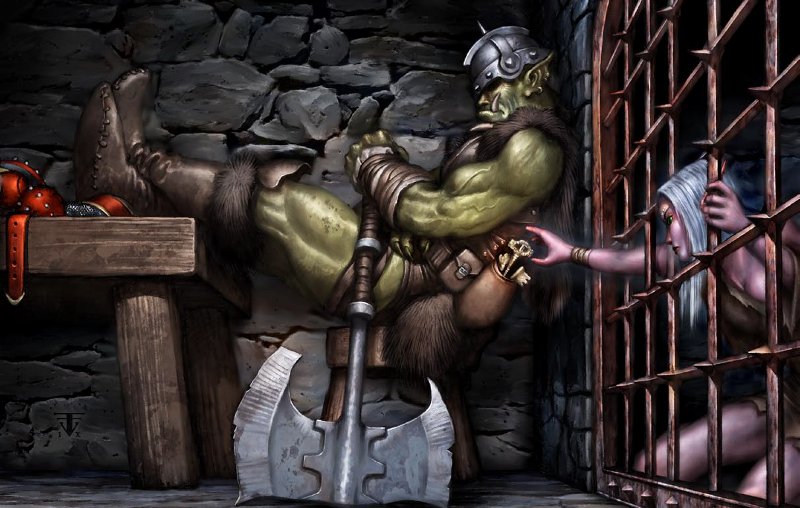
A
So! You may be wondering how spellcasters maintain their dominance with so few skills. Well, I did a little exercise to see what spells either replicate or invalidate a major portion of a skill. Let's see:
-
Acrobatics:
beast shape, dimension door, elemental body, ethereal jaunt, etherealness, feather fall, fly, form of the dragon, jump, polymorph, shapechange
-
Bluff:
glibness, modify memory
-
Climb:
animate rope, beast shape, dimension door, elemental body, ethereal jaunt, etherealness, fly, form of the dragon, gaseous form, levitate, polymorph, rope trick, shapechange, spider climb, teleport, wind walk
-
Craft:
fabricate, major creation, make whole, minor creation, mending
-
Diplomacy:
charm person/monster, dominate person/monster, geas, hypnotism, suggestion
-
Disable Device:
knock
-
Disguise:
alter self, disguise self, polymorph, seeming, veil
-
Escape Artist:
freedom, freedom of movement
-
Handle Animal:
animal trance, awaken, calm animals, charm animal
-
Heal:
breath of life, cure wounds, delay poison, heal, heroes' feast, neutralize poison, raise dead, regenerate, remove disease, resurrection, restoration, stabilize
-
Intimidate:
cause fear, fear
-
Linguistics:
comprehend languages, tongues
-
Knowledge:
commune, contact other plane, divination, legend lore, vision
-
Perception:
alarm, detect secret doors, detect snares and pits, find traps, foresight, mage's faithful hound
-
Perform:
enthrall
-
Ride:
phantom steed
-
Sense Motive:
detect thoughts, discern lies, zone of truth
-
Sleight of Hand:
shrink item
-
Spellcraft:
analyze dweomer, arcane sight (greater), identify, read magic
-
Stealth:
invisibility, invisibility sphere, silence, zone of silence
-
Survival:
commune with nature, create food and water, create water, detect animals or plants, find the path, know direction, locate creature, speak with animals
-
Swim:
beast shape, elemental body, form of the dragon, polymorph, shapechange, water breathing, water walk
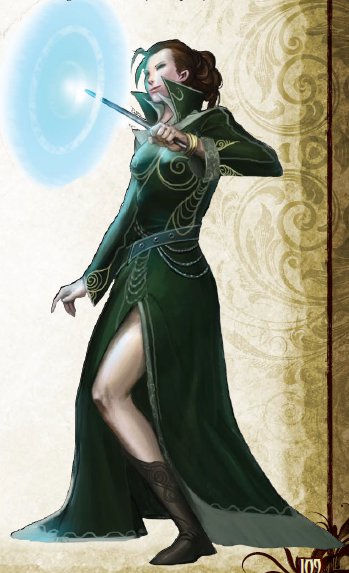
One-legged spellcasting.
The same principle can be applied to class features, replacing a barbarian's rage with bull's strength and bear's endurance, using bless in place of a bardic performance, etc.
This is the problem that skills run into is that many spells exceed their capabilities without even requiring a roll . Skills are still useful, but they have the unfortunate quality as being a fallback condition when more useful spells aren't available.
Shrinking the skill list was a solid change, but falls into the issue that some skills, like Acrobatics or Perception, benefit hugely from it. In addition, you still have skills like Spellcraft and Knowledge (arcana) that work in very similar fields, but for some odd reason weren't folded together.
So - two steps forward, two steps back.
Next: Grimtooth's Feats, the most cunning traps in roleplaying.
Feats
Original SA post
Pathfinder Roleplaying Game Part 6: Feats
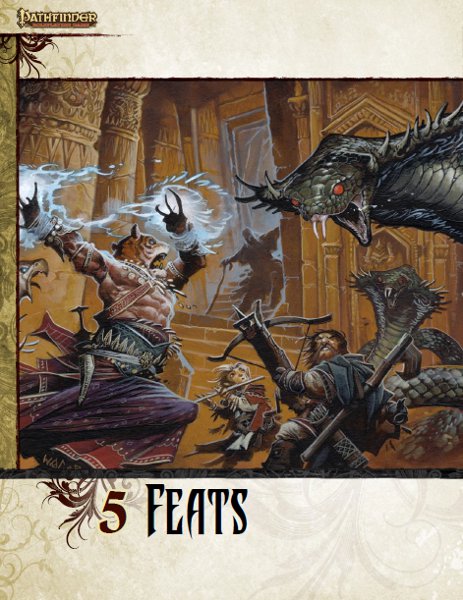
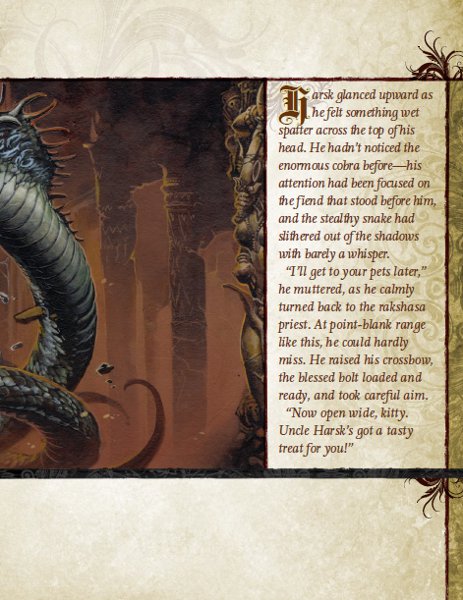
Correction: "At point-blank range like this, thanks to the Point-Blank Range feat, he became 5% more likely to hit, so his chance of missing was slightly reduced."
Now, each character still gets feats, which generally provide additional options or a small bonus to a statistic. There's no real thematic or mechanical characteristic for that feats represent, other than the fact you get to choose them every three levels or so. Most characters get ten feats over twenty levels, plus from their class:
-
Fighters get 11 "combat" feats.
-
Rogues can gain up to 4 "combat" feats and 6 of any other feats.
-
Rangers get 5 feats from their fighting style plus Endurance.
-
Monks get 5 feats from a very specific list as well as Stunning Fist.
-
Wizards get Scribe Scroll and 4 other Metamagic or Item Creation feats.
-
Sorcerers get three feats from their bloodline list of feats.
-
Humans get a bonus feat.
-
Half-elves get Skill Focus as a bonus feat, so that everybody can point and laugh at them.
-
Everybody else gets a +0 booby prize.
Each feat has different prerequisites, which are generally roundabout ways to restrict what level you can choose them at like attack bonus. Which is one way monks and rogues get screwed - they have a lower attack bonus, so they can't select a lot of the combat feats often until they're obsolete. The rogue, thankfully, has enough other benefits to compensate; the monk does not.
Also, some have attribute prerequisites, which present the issue I put forth in the attribute section: roll badly or assign your attributes without enough foresight, and you can't take certain feats. What's worse, many feats have "odd" requirements for attributes like 13 or 15, attribute values that normally have no benefit over a 12 or 14, for example. Some feats also require a certain amount of planning out your level increases from level 1 to obtain before they become obsolete or you literally get locked out of purchasing them. They not only often represent nickel design, but make you bend over backwards for those nickels. What's more, the balance between feats is nonexistent; some give you a +2 bonus on two skills, while another might give you a whole unit of troops and a sidekick.
There are several types of feats; a feat can be more than one type. For example, most critical feats are combat feats as well.
-
General:
These are your disorganized, does whatever, no-focus kind of feat.
-
Combat:
These enhance fightin' with weapons.
-
Critical:
These make critical hits hurt more.
-
Item Creation:
These let you create magical items. This costs a lot of time and gold, and sounds boring to me, but it's a good way for spellcasters to break the game. Short story: it used to cost XP to use these feats, now they don't. I'll go on to why that's bad in the magic item chapter.
-
Metamagic:
These let you beef up your lower-level spells. Bards and sorcerers need to take longer actions to prep these, because fuck them for not being wizards.
-
Acrobatic:
You gain a bonus to both Acrobatics and Fly. If you can fly, chances are you don't need to worry about balancing on narrow surfaces or moving past characters (given you can just fly around them in most circumstances). If you are worried about balancing on surfaces, you probably can't fly.
And this is the first feat on the list
.
-
Arcane Armor Training:
Wizards are usually penalized with a percentage chance of their spells failing when they wear armor. So this feat allows them to ear some armor!... up to leather. So they can spend two feats and some coin to wear armor that gives them a +2 armor bonus. Or they could memorize
mage armor
, which lasts for hours and gives a +4 armor bonus. (And no, the two don't stack.)
-
Arcane Strike:
You could take this feat, which gives a wizard or sorcerer a bonus to hit and damage, or learn Greater Magic Weapon, which has the same effect and lasts for hours. Noticing a theme? Me too.
-
Bleeding Critical:
This lets your attacks do damage over time when you crit! Which is great, until your realize that any healing stops the bleeding. Congratulations, fighter, the feat you waited until 12th level to buy got stopped by a 1st-level cleric's spell.
-
Brew Potion:
It's a magic item feat that only lets you work with up to 3rd level spells. Yep, after 5th level it doesn't significantly get any better. Bottoms up!
-
Catch Off-Guard:
This lets you use an improvised weapon without penalty, which would be nice if improvised weapons weren't terrible. It also makes unarmed opponents flat-footed against such attacks, just when you need it most - against a foe who can hardly harm you!
-
Cleave:
Unlike the Dungeons & Dragons 3.5 feat, this lets you get an additional attack to attack two foes, and then... gain a -2 penalty to Armor Class, because fuck fighters.
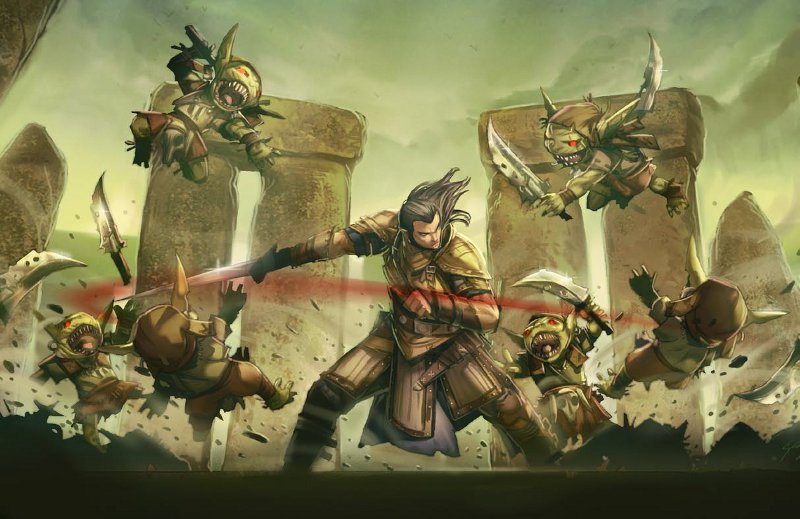
This is how the new cleave feat works! Get an extra attack, then get the shit stabbed out of you.
-
Combat Casting:
This gives a +4 bonus to casters to make Concentration checks to cast on the defensive or while grappled. Yes, this feat is designed to cover up one of the only weaknesses casters have.
-
Combat Expertise
Normally, in
Dungeons & Dragons 3.5
, this let you reduce your chance to hit to improve your Armor Class, but you couldn't reduce your attack to less than 0 or your Armor Class by more than 5. In Pathfinder, you can only do -1 to attack and +1 to defense and level 1, and you have to wait until
16th level
to get that -5 / +5. Oh, and it requires Intelligence 13, an attribute that benefits very few melee combatants.

-
Craft Rod, Craft Staff, Craft Wand:
Yes, because we need three types of feat for "magic stick". Also, sarcasm!
-
Craft Wondrous Item:
If you do take a magic item creation feat, this is the one to take. It lets you make elixirs, tokens, bracers, figurines and statues, musical instruments, cloaks, bags, ropes, gloves, ointments, jewelry (except rings), incense, gems, bottles, vests, quivers, boots, bells, candles, silverware, eyeglasses, boats, fans, helmets, backpacks, carpets, belts, books, masks, cards, forts, skulls, gates, mirrors, orbs, and more. Compare with Forge Ring, which lets you make rings. Just rings.
-
Critical Focus:
When you hit with a critical hit, you have to roll to hit again to confirm the critical hit and earn your bonus damage. This gives you a +4 on that confirmation roll! Sounds great? If you do the generous damage of 15 points on average, and get critical hits on 18-20, this means you do 0.45 extra damage on average on every hit. And you waited until 9th level for this feat.

-
Deadly Stroke:
If you're a fighter, this will have taken five feats and Level 12 to do double damage and 1 point of Constitution damage to a stunned or flat-footed opponent. Or you could have played a rogue and instead do +6d6 damage and have spent no feats. Just bringing that up.
-
Deafening Critical:
You were lucky enough to get a critical! Now your opponent is deaf. They get a penalty to cast chatty spells, notice checks, and initiative (which they already rolled). So. Chances are, they're not penalized at all. Also you had to wait until 14th level for this, because fuck fighters.
-
Disruptive:
I want to give them credit for having an anti-caster feat in here, that makes it harder for mages to concentrate while you're aware of and threatening them. But a fighter has to wait until 6th level to get this feat. A wizard can get
invisibility
at 3rd level, and
fly
at 5th level, both of which will immunize a spellcaster against this feat.

-
Dodge:
This feat has been improved from
Dungeons & Dragons 3.5
, where it gave you +1 to Armor Class against one enemy you chose on your turn. Now it gives +1 to Armor Class. Still shit, unfortunately. A nickel bonus? No thanks. Still just a punishment feat required to take more potent abilities.
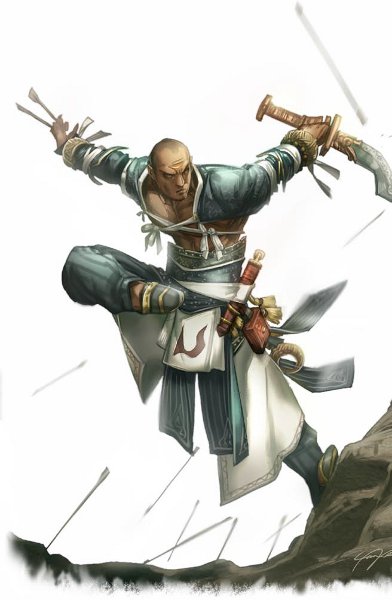
You can only use Deflect Arrows once per round, cheater.
-
Elemental Channel:
Now you can finally oppose air elementals and use your ability to channel energy to smite them! Their plans to envelop the world in breezy doom will never come to fruition!
-
Empower Spell:
Lets you prepare a spell as two levels higher than normal to make it do 50% more damage! Noting mostly for comparison - crap compared to many wizard feats, but still way better than most of the combat feats I've noted here.
-
Extend Spell:
This is an example of a
good
wizard feat. Add one level to a spell in order to double its duration?
Mage armor
and spells like it are even better when you don't have to recast them as often.
-
Fleet:
You can move 5' faster while wearing light or no armor. You can take this feat multiple times,
if you're a masochist
. (Also, there's a 1st-level spell that increases your speed by 30'. Which do you want?)
-
Forge Ring:
I just wanted to bring up this poor feat again because it has a level requirement of 7th level. Craft Wondrous Item has a level requirement of 3rd level. Just rubbing it in... like the efreeti bottle you can make with Craft Wondrous Item!

-
Greater Bull Rush:
I'm going to point this out as actual interesting feat design. You can normally bull rush people to shove them around, but this ability lets you shove somebody so their movement provokes attacks from your friends. This is interesting feat design that provokes tactical ideas. Greater Overrun has a similar effect, and so does Greater Trip.
-
Greater Two-Weapon Fighting:
Gives you another attack, etc., but that's not the important part. The important part is that it requires Dexterity of
19
. Which means if you didn't plan your build from the start to take this, chances are decent of never, ever being able to take this. What's more, Dexterity doesn't fucking help you at all to hit people in melee without investing in another feat (Weapon Finesse), and then you have to use light weapons, and light weapons are crap.
-
Greater Vital Strike:
This is pretty much the top combat feat at level 16 for fightin' types. It lets you multiply your damage dice by four once a round. Better design than most combat feats for its simplicity, but unfortunately arrives way too late.
-
Improved Critical:
If you're doing 15 points of damage, doubling the crit range of a weapon with a high crit range of 18-20 and a multiplier of x2 adds an average of 1.5 damage. Not as good as Weapon Specialization, even if you're focused on it.
-
Improved Familiar:
Meanwhile, in the wizard court, you can swap your owl or cat for a mini-dragon, elemental imp, and other genuinely magical creatures. A fun feat that more feats need to look up to, though it'd be more fun if the wizard could just be cool from the start. I mean, you might as well at this point, it's not like it's going to unbalance them
more
.
-
Improved Feint:
Lets you feint as a move action. An example of a good combat feat, but one most fighting classes won't be able to use it effectively, given it requires Int 13 (yay, attribute tax) and a high Bluff skill.
-
Improved Great Fortitude:
This lets you, once per day, reroll a Fortitude saving throw. Only you have to take the second roll, even if it's worse. Fuck it. Terrible option.
-
Leadership:
One of the best feats in the book. Only requires level 7, and you get a sidekick and a gang of minions. Generally a great way to make combat slow to a crawl, craft fantastic items, make the GM hate you, and completely wreck the action economy of the game. Originally in the
Dungeon Master's Guide 3.5
as a sort of optional rule (optional meaning "this is busted" in this case), but anybody can nab it in
Pathfinder
.
-
Master Craftsman:
At first, I'm like, cool. A feat that lets non-casters create magic weapons. That's pretty rad. Then, I'm annoyed as I realize it basically just punishes non-casters with a feat tax. Then I'm just unhappy again. Oh, and you can use any skill to craft magic items with this feat. This means you can Swim or Bluff your way to a more powerful sword. "Sword, you are more powerful!" (Let's see if the sword is fooled!)
-
Medusa's Wrath:
I don't know if I like this feat for being interesting - it gives monks bonus attacks when attacking foes who are dizzied. But then, getting bonus attacks against people you managed to stun, daze, or paralyze is like... haven't you already proven you can batter them?
-
Mounted Combat:
Lets you make a Ride check to negate a hit on your mount once per round. I kind of wish more defensive feats in here had similar mechanics, even though there's some weirdness where attack bonuses and the Ride skill scale with level entirely differently.
-
Natural Spell:
Or "the feat every druid will take". Lets you cast spells while using wild shape. Essential to being a totally game-busting magic bear.
-
Nimble Moves:
This lets you move normally on difficult terrain for 5 feet. If you have the 1 out of 10 GMs that remember difficult terrain exists and uses a terrain map and minis, congratulations! You can now move 20 feet per round instead of only 15.

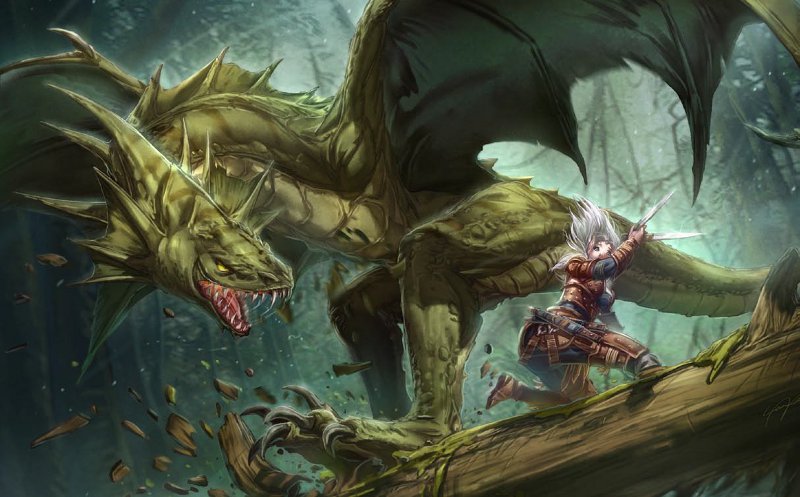
Maybe she's using the upgrade, Acrobatic Steps, that lets you move up to 25'! Man, these feats are exciting!
-
Penetrating Strike:
This allows you to ignore a small amount of damage reduction. Note that spells already ignore damage reduction. Fuck you, fighters, pay your effectiveness tax here.
-
Pinpoint Targeting:
Lets an archer ignore all armor, which would be a fun effect for later levels, only you only get to make one attack. Making one attack at 16th level for a dedicated combatant is like saying "it's okay, I don't actually need to deal damage".
-
Quicken Spell:
Lets you cast a spell as a free action once a round by preparing a slot four levels higher. Breaks the action economy, breaks spellcasting, especially if you combine it with effects that make it cheaper to use.
-
Rapid Reload:
The feat tax you have to take for using a crossbow for more than one attack a round. So are crossbows better than bows? Not really.
-
Selective Channeling:
Lets a cleric ignore a certain number of targets when channeling energy. Fantaaastic. Lets a cleric murder everybody nearby without touching the party, or heal everybody in the party without healing the enemy boss. Frankly ridiculously good; every cleric should take this at level 1.
-
Shield Master:
The apex shield feat. Lets you ignore all penalities from shields when attacking, and lets you use defensive magic on a shield as offensive for attack. A great boost that should not take four feats and level 11.
-
Spellbreaker:
This lets you take attacks of opportunity against spellcasters that fail to cast defensively, which should probably be a default rule, not a feat, given how dominant spellcasting is. Also, you have to be a 10th-level fighter to take this, while a 9th-level wizard gets
greater invisibility
, which entirely negates it. I want to laud them for including anti-spellcaster feats, but a competent, prepared wizard in this system doesn't need to worry about force of arms.
-
Spirited Charge:
Doubles or triples damage on a charge attack while mounted. A key element of degenerate warrior builds, since multipliers break the damage limits they largely have set up.
-
Stand Still:
Lets you make a maneuver check to keep an enemy from moving in place of getting an attack of opportunity. Pretty much the core tanking feat for warriors, and... it has the whole issue where it requires a decent Dexterity, a non-essential attribute for melee combat.
-
Step Up:
If your enemy moves 5', you can move 5' after them. A secondary tanking feat, thankfully with minimal requirements.
-
Stunning Critical:
Probably the best critical feat, since it stuns or staggers a foe for 1d4 rounds, but most characters will have to wait until at least 18th level and still have to take two prerequisite feats, including the terrible Critical Focus.
-
Weapon Focus:
Gives you +1 to hit with a single type of weapon. Specifically, like, a longsword, not just swords. A bold example of nickel design sense. Also, it's shit.
-
Weapon Specialization:
Requires you to be a 4th level Fighter, and gives you +2 to damage with a weapon. Nickel design, garbage. Spellcasters can regularly get damage that levels up with them or bonuses to every die of damage rolled without spending feats. See also: the ghettoization of warriors.
-
Whirlwind Attack:
Lets warriors hit everybody around them, but isn't compatible with other feats, spells, or abilities that add bonuses or attacks. Needlessly nerfed to be garbage, especially at higher levels, requires Dexterity and Intelligence, four feat picks, and is a emblematic of everything wrong with the combat feat revisions in
Pathfinder
.
So that's feats. It seems any feat related to combat tends to have much more stringent requirements, while most spellcasting feats have mild requirements at best, when they have them at all. What's more, many warrior feats for fighters, paladins, or rangers requires them to develop additional attributes. A fighter that wants to maximize effectiveness of Whirlwind Attack, one of the higher-tier fighter feats, has to develop Strength (to actually hit), Dexterity, and Intelligence. A wizard that wants Quicken Spell, one of the higher-tier spellcasting feats, needs... Intelligence, to improve his spellcasting, and that's all. Some of the higher-tier warrior feats require attributes of 19 in Dexterity, often a nonessential attribute for them (useful, but not essential). A great cleric feat like Selective Channeling requires Charisma 13, and that's all. Metamagic feats generally have no requirement at all other than level.
It's a mess. It's a system that really needs to be scrapped and rebuilt from scratch, but Pathfinder would never be that daring. Instead, it gimps a wide number of combat feats in the name of "balance", when they were already weaker options in Dungeons & Dragons 3.5 .
Granted, Dungeons & Dragons 3.5 actually advanced fighters by giving them more interesting options like tactical feats, more effective class variants, and finally martial classes. Pathfinder , however, rewinds the clock back to 2003, and then somehow manages to play things even more conservatively for feat design.
Next: Traits - feats' inbred cousin.
Traits
Original SA post
Bonus post for a short subject...

Pathfinder Roleplaying Game Part 6a: Traits
This seems to be a good place to discuss traits. Now, traits you won't find in the corebook - they originally appeared in Paizo's Adventure Paths as feats that tied players closer to their setting. There's a free web supplement for the core that details them, and I'm going to cover it, since every
Pathfinder
book down the road assumes you know what the hell they are.
What are traits? Well, basically, half-feats that are intended to be flavorful and add background detail to your character. Every character gets two, but they note GMs can choose to give more or less.
Pathfinder Roleplaying Game posted:
Trait bonuses do not stack—they’re intended to give you a slight edge over the non-PCs of the world, not a secret backdoor way to focus all your traits on one type of bonus to gain an unseemly advantage over the rules.
Funny, is that why they give a mechanical advantage? And if you're thinking by now "I bet some are better than others..."
... you bet your bippy.
Here's a sampling!
Combat Traits
-
Armor Expert:
Reduces your armor check penalty by 1. Getting this kind of bonus could be really rare and valuable for an armor wearer. Not worth a feat, but definitely worth it for a trait.
-
Bullied:
You get +1 on attacks of opportunity with unarmed attacks. Except... you still need to buy Improved Unarmed Strike, or play a monk, to use it. Unless you're a monk, it's fairly worthless, and not even all that great even then.
-
Reactionary:
+2 to initiative checks. Every number counts in the high-level rocket tag play of Pathfinder later on. A great investment.
-
Birthmark:
Hey, it's a holy focus people can't disarm you of! Also gives the narrow, lame bonus of +2 on saves against compulsions and charms. I suggest putting the birthmark on your butt, and when it's time to drop the hammer, you show your foes the
moon of god
.
-
Caretaker:
Gives you a +1 bonus on Heal checks, and Heal is considered a class skill for you. It's a crap bonus for a crap skill. Enjoy.
-
Sacred Touch:
Hey, you get the ability to stabilize somebody with a touch! So does any bard, cleric, ranger, or paladin with at least one healing spell. Save your traits for shit that matters.
-
Focused Mind:
Gives an extra +2 for concentration checks, letting you break the usual cap on it. Practically essential for spellcasters.
-
Dangerously Curious:
Gives you +1 to Use Magic Device and also adds it as a class skill. A fantastic skill for many classes, allowing you to use the items of ultimate power usually reserved for spellcasters.
-
Magical Knack:
Adds +2 to your caster level if your caster level is less than your hit dice. If some reason you have found yourself with less caster levels than hit dice, you have gone wrong and the game will punish you for it. This will not make up for the spell capability you lose forever. Crap in a wrap.
-
Adopted:
Lets you choose any one race trait (which you gain as a part of this trait). Basically breaks all racial requirements for traits, forever. Whups. You may have to put up with the awkward background story of being a half-ogre raised by dwarves or something, tho.
-
Natural-Born Leader:
Leadership is broken. Things that improve Leadership are broken. This improves Leadership. It is also broken.
-
Rich Parents:
You get 900 gold. Kind of impressive at first level! Later on, pocket change. You don't need pocket change later on. Shitfeat.
There's also an "Additional Traits" feat added, which gives you two traits, in case you need a secret backdoor way to focus all your traits on one type of bonus.
James Jacobs and F. Wesley Schneider get the
Next: Equipment - things to kill with and get killed in.
Equipment
Original SA post
Pathfinder Roleplaying Game Part 7: Equipment
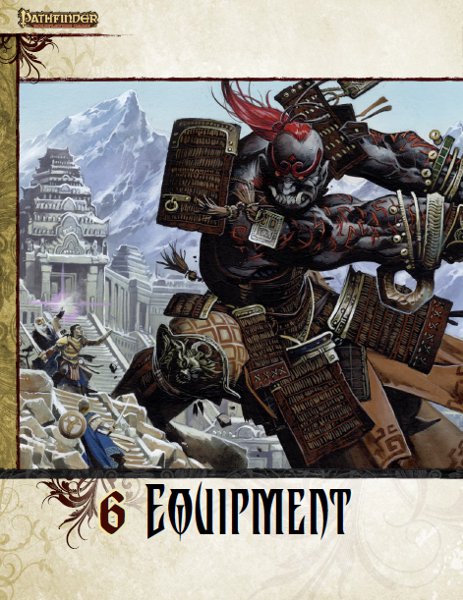
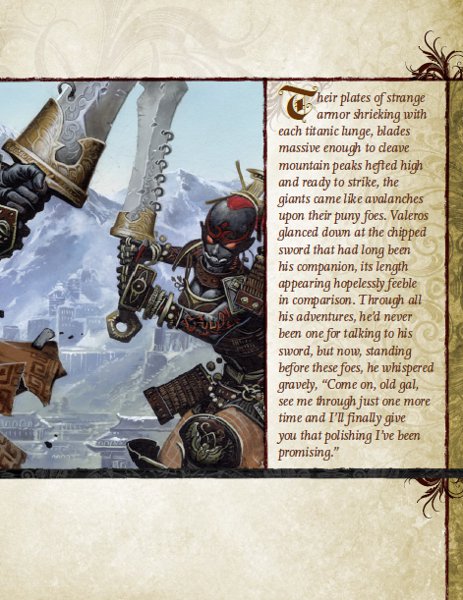
Don't recognize these monsters? Find them in Pathfinder Bestiary... 2!
First, we start with how much money a character gets. Yep, if you wanted to have a fighter with heavy armor? Hope you roll enough gold to purchase it! Granted, they do give the higher gold amounts to characters more likely to use quality weapons and armor, but not enough to buy top-end items.
They go over coins, which are gold, silver, copper, and platinum pieces. 50 coins are one pound. It also gives us an idea of what trade goods are worth. One pound of pepper is as much as one sheep which is as much as one dagger which as much as two hundred sling bullets. A light repeating crossbow will cost you one hundred and twenty five sheeps or twenty five cows.
Fuck adventuring, I've got enough money here to start a farm instead.
Exotic Weapon Proficiency: Livestock
Anyway, it mentions that if you sell stuff to stores, you'll generally gets best price, which means the optimal solution is to have a party member set up their own item store and sell to other
Weapons
Yeah, it's time to talk about weapons! Weapons deal damage, get a critical hit on a 20 (and make a confirmation roll). Weapons have several categories, like simple (nearly anybody can use these), martial (mostly just warrior-style classes), or exotic (you have to pay a feat tax to use these). And there are special weapons like:
-
Reach Weapons:
Lets you hit people from farther away, but not close up.
-
Double Weapons:
These are treated as two weapons for two-weapon fighting.
-
Thrown Weapons:
I'll let you folks work these out.
-
Projectile Weapons:
Ditto.
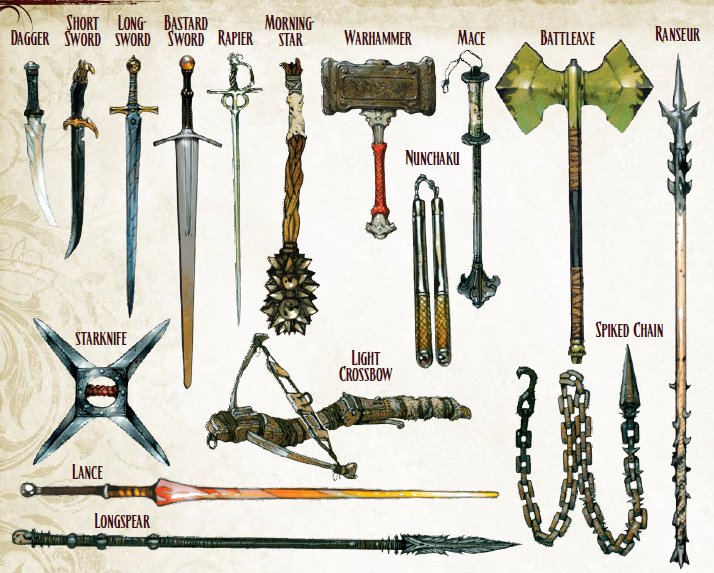
Then we get a big table of weapons!
-
Axe, Throwing:
These cost four sheep a throw. That's an expensive throwing weapon!
-
Pick, Light vs. Handaxe:
You could do an extra +1 damage with each hit of the handaxe, or you do do an extra 1-8 damage about 3% of time with the light pick. Pathfinder, balanced by people who can't do math.
-
Starknife:
A new weapon for
Pathfinder
. It's like a throwing axe, only it does less damage with a higher crit mod. Oh, and it costs
twelve
sheep to throw this puppy.
-
Siangham:
It's like a shortspear, only it costs three times as much, can't be thrown, and requires a feat pick to use if you're not a monk.
-
Sword, bastard:
If you spend a feat pick, you can use this weapon one-handed, just like a longsword! It does 1 extra point of damage. That's all you get.
-
Curve Blade, elven:
Another new weapon, pretty much a bastard sword that can't be used one-handed, but instead gets a threat range 1 increment larger. Requires a feat pick, or being elfy.
-
Whip:
This is a weapon that does no damage if they have any armor on, or a natural armor bonus of +3 or higher. It requires an feat choice to use, does a whopping 1d3 lethal. You get a +2 to disarm or trip, but I hope you weren't planning on
killing
anyone.
-
Crossbow, Repeating Light:
It costs more than a longbow, you can't use your strength bonus to damage, requires a feat pick, and pretty much shows why the exotic weapon mechanic is a honey trap.
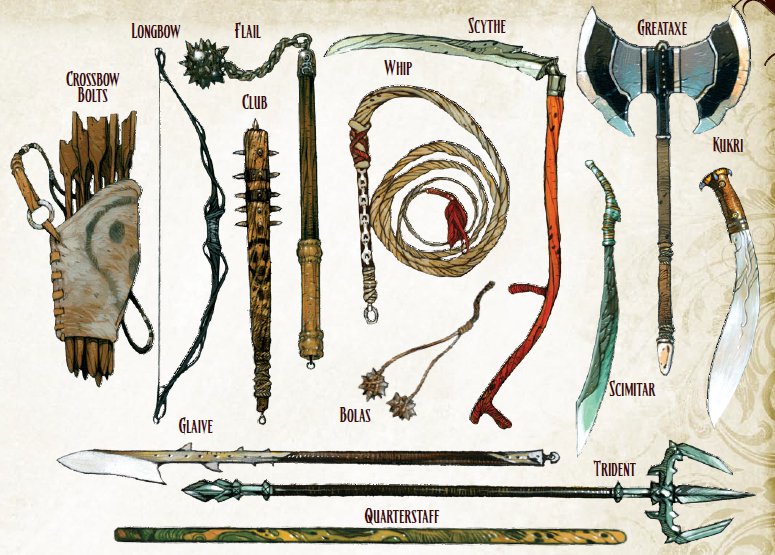
Also, about using double or paired weapons? It can work, but bear in mind you need a high damage bonus to offset the lack of accuracy (usually though some ability like Rage or Sneak Attack). It also costs you more feats, you need a really high Dexterity, and you have to invest in two magic weapons in the long term, and fuck that, just grab a greatsword already.
There are also Masterwork weapons, which get a +1 to attack rolls. It costs 300 gp for all weapons, so it costs as much for a dagger and a greatsword equally, because Pathfinder sticks with old, dumb rules through thick and thin, dammit.
Armor
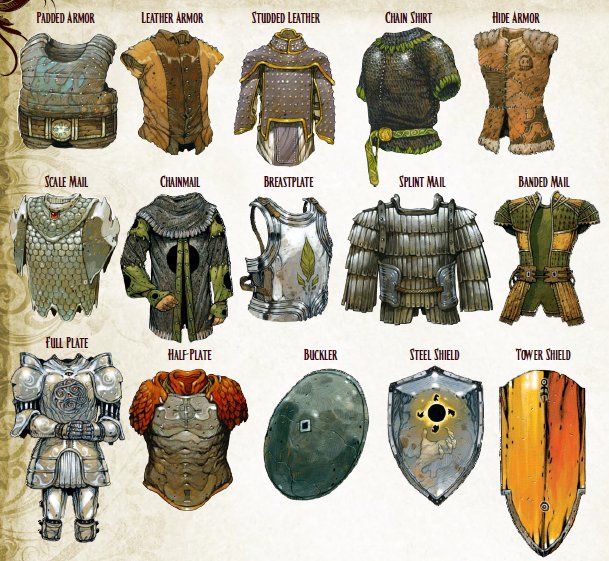
Now armor gives you Armor Class, which makes it harder for you to be hit, because attacks bounce off, right?
I mean, it makes sense that a mace might do a lot less damage against a hard plate suit, right? Well, let's extremeify that example.
How about a greatsword against padded armor? How about a greatsword that's on fire against padded armor? How about a 20' greatsword wielded by a 100' tall giant where both the giant and the sword are on fire against padded armor? Well, you get an extra 5% (nickel) bonus to defense each time.
Yeah, it's goofy, and I don't care how many fluffy pads you're wearing.

Armor has drawbacks, however. Each has a "maximum dexterity bonus" where if you have a high dexterity, your bonus is capped. So if you were dreaming of being a sword-and-board fighter in full plate, swingin' with your sword and bashin' with your shield, ha ha, you dumb fuck, you fell into a trap.
See, the two-weapon feats require Dexterity, which will be a big expenditure for you to fufill. But your armor will restrict you from ever using that Dexterity effectively. You'll get your shield and sword at the same time, but you'll be punished with hefty penalities.
If that wasn't enough, armor also has armor check penalities that are applied to any Strength or Dexterity-based skills, ranging from -1 (studded leather) to -7 (half-plate).
Each armor also has an arcane spell failure chance. Whenever a wizard or sorcerer uses a spell while in armor, they have to roll a percentage chance or fail. Not a huge deal, they can get better protection via spells.
Lastly, armor can slow you down. Medium or Heavy armor slows you down by 10' if your racial movement is 30' a turn, or 5' if you're part of a slowpoke race that moves at 20'. Dwarves get to ignore this, but as mentioned, they're already slow.
There's masterwork armor that reduces the armor check penalty. There's also adjusted costs for armor by size. Finally, it has the time detailed it takes to put on armor (hint: don't bother if a fight has already started).
It should be noted that armor, if anything, makes you more vulnerable to magic. It doesn't protect you from magic rays, and potentially limits your Dexterity bonuses to defense. So if you want to fight a wizard, don't bother being an armored fighter. Just don't.
Special Materials
There are fancy materials to make weapons and armor out of, which are:
-
Adamantine:
This is made from rocks from the sky. Anyway, it gives you a little damage reduction if you make armor out of it, and can bypass some forms of damage reduction if you make weapons out of it. It's very expensive.
-
Darkwood:
Items made out of this magic wood are very light, so it's mostly used to make wooden weapons and shields.
-
Dragonhide:
I... huh? That doesn't make any sense, but whatever, have your disassociated nonsense mechanics, Pathfinder . Made from dragons, just counts as masterwork armor. Worth bragging rights only.
Pathfinder Roleplaying Game posted:
If the dragonhide comes from a dragon that had immunity to an energy type, the armor is also immune to that energy type, although this does not confer any protection to the wearer.
-
Iron, Cold:
Made to kill faeries and demons, and can bypass their damage reduction. It's found deep underground and is apparently "forged at a lower temperature", however that works.
-
Mithral:
This is a fancy light steel. It basically reduces all the penalties of armor - maximum dexterity, armor check penalties, and spell failure chances greatly.
-
Silver, Alchemical:
Special silver used to make weapons and fight werewolves and presumably wolfweres.
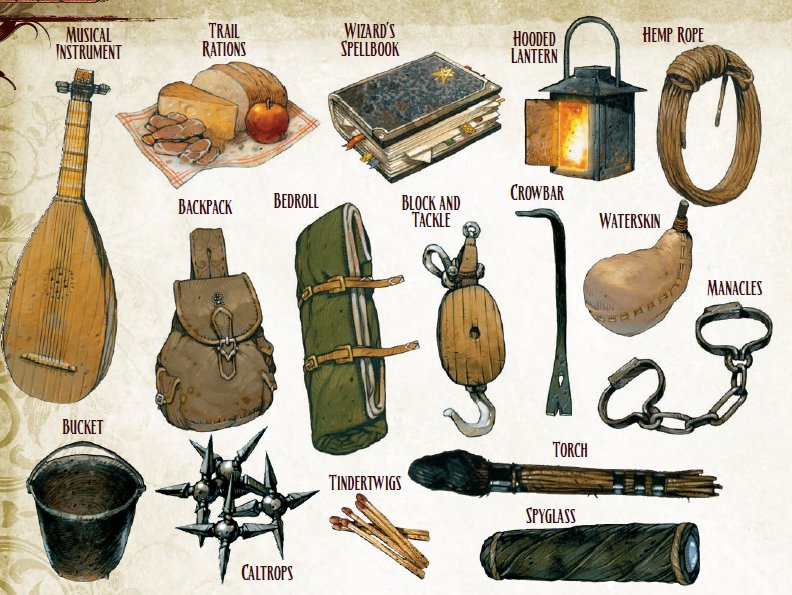
This is where a all the boring stuff goes that doesn't murder things that scream and bleed. Most of it is pretty standard fantasy RPG stuff and you already know what it does. But here's a few notables:
-
Caltrops:
These have special injury and healing rules, for some reason, but I still can't stab somebody in the foot manually.
-
Crowbar:
I just want to say the historical term is an "Iron Crow" and that's cooler to take into a dungeon.
-
Tindertwigs:
Anachronistic matches.
-
Alchemist's Fire:
This gets special rules to set people on fire. Note that dragon's breath and fireballs do not set people on fire. I don't understand it either, myself.
-
Tanglefoot Bag:
Lets you automatically entangle creatures. There's no saving throw as long as you hit an easy (touch) attack roll. Can have other effects like knocking flying characters out of the air or pinning creatures to the ground. Fairly ridiculous for a nonmagical item.
-
Healer's Kit:
This gives a +2 to Heal checks and is now exhausted after 10 uses, as if Heal wasn't lousy enough anyway.
-
Courtier's Outfit:
Includes special penalties for trying to influence nobles while not wearing this that never be mentioned anywhere else. Requires you to buy extra jewelry to get its effect, which for some reason is not part of the outfit's cost.
-
Inn:
A stay at a good inn for one night costs one sheep.
-
Dog, Riding:
Really the best reason to play a gnome or halfling.
-
Spellcasting:
The cost for a
true resurrection
or
wish
is 26,530-26,800 gp, for the record.
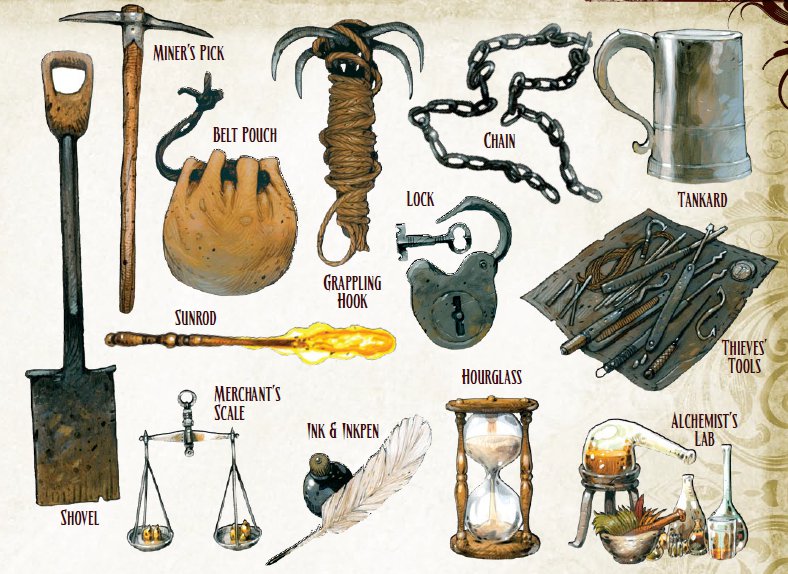
And that's it for equipment. Was it boring for you? It was boring for me. Oh, and for some reason there are no costs for spell components. One would think there would be, but many components are unpriced, because the game actually encourages you to ignore those costs. Yep, rangers have to count every arrow and rogues have to count every vial of alchemical fire, but wizards are assumed to have whatever they need as long as they have a pouch to carry it in.

Next: Additional Rules - the truth of good, evil, life, death, and encumbrance.
Additional Rules
Original SA post
Pathfinder Roleplaying Game Part 8: Additional Rules
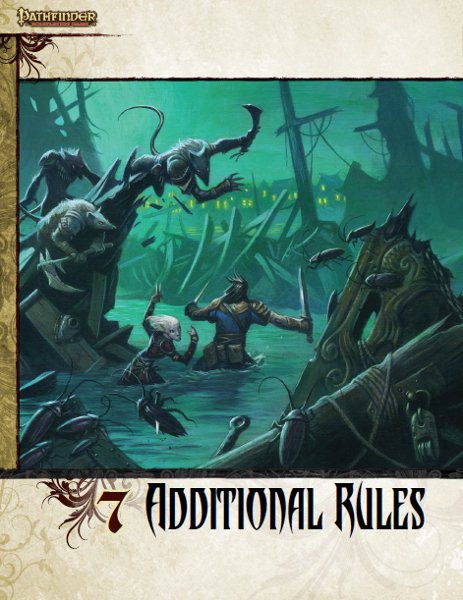
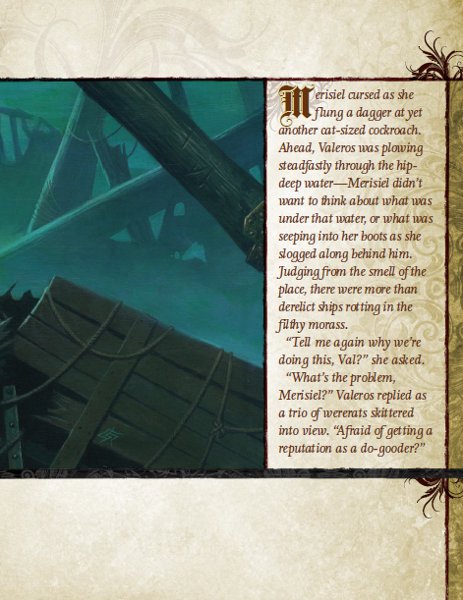
Best RPG chapter name ever.
Alignment
Oh, now Pathfinder is going to teach us about morality. Oh, Pathfinder! Teach us about morality!
Anyway, good creatures protect innocent life, whatever that is. Evil creatures debase and destroy innocent life, whatever that is. Good creatures love live and stuff, evil characters like harming people. Neutral people are basically without any convictions at all, or something.
Lawful characters are honest, trustworthy, obedient, etc., while chaotic characters do what they want. Lawful characters are reliable but also inflexible, chaotic characters do what they want. And so on.
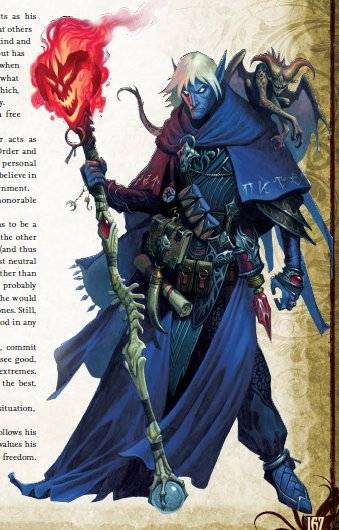
"Welcome to wonder of World of Warcr- what, that's tuesday?
Why didn't you tell me, you stupid imp? Welcome to the wonder of... Pathfinder!"
Anyway you have the nine standard alignments that mix that shit up, from Lawful Good to Chaotic Evil. There are some descriptions and they're passable, or at least as good as these olde-timey definitions ever get. It doesn't really define so much as handwave, in any case.
It notes that generally not to sweat if somebody's playing their alignment or not, but the gamemaster can switch it if they think their alignement switches, but that they should warn the player and talk it over with them first, especially since it can fuck over character types that are dependent on alignment. Reasonable stuff.
Of course, it would help if there were actual rules or guidelines for alignment shifts, but arguments between players and GMs are supposed to hash it all out, I suppose.
Vital Statistics
This covers stuff like height, weight, and age. And yes, elves still reach adulthood by 114-120. I imagine they must potty-train at 15, hit puberty at 68, and somehow still end up only being level 1. Elves are fucking slow .
Same goes for gnomes and dwarves only less so.
They also detail how to figure things like aging and encumbrance. Basic stuff, nothing more to pick on here.

Movement
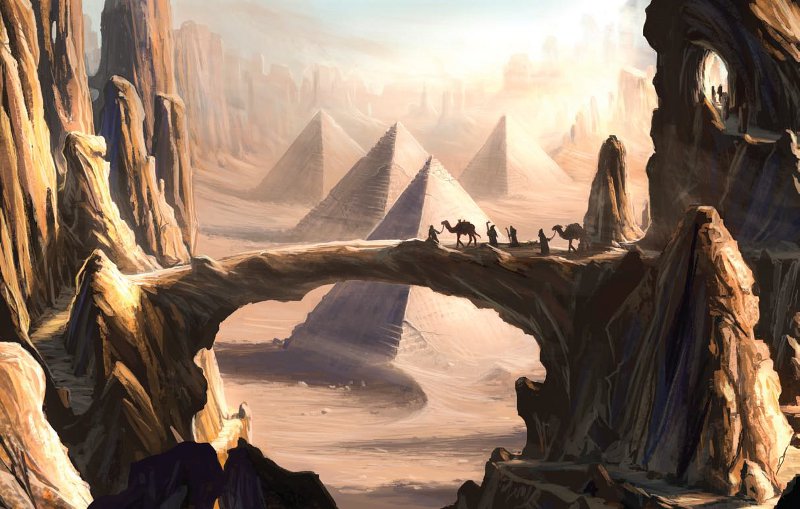
Adventure in the fanciful land of... Tpyge... and see the wonderous... Dimaryps! Man, I feel so creative.
Here is where we suddenly switch modes from character elements to the movement rules. There... was no warning. Suddenly... rules!
It details how overland movement works, that running multiplies your move by 4 unless your heavily encumbered, in which case it's only by 3. In tactical combat, there's also sometimes hampered movement where you're trying to move through tough terrain where your movement is halved.
There's details for how long it takes to move short distances (like around a dungeon) and long distances (like through wilderness). You can do forced marches, there's verrry basic rules for chases, etc.
Exploration
Here it talks about how lighting works and what penalities you take from darkness, how to damage objects or break down doors... blah blah, nothing really to discuss. The rules work at a basic level, and no doubt get wonky down the advancement road, but I'm not going to linger. It's time for a fight!
Next: Combat - how to TPK your BFFs, OMG.
Combat
Original SA post
Pathfinder Roleplaying Game Part 9: Combat
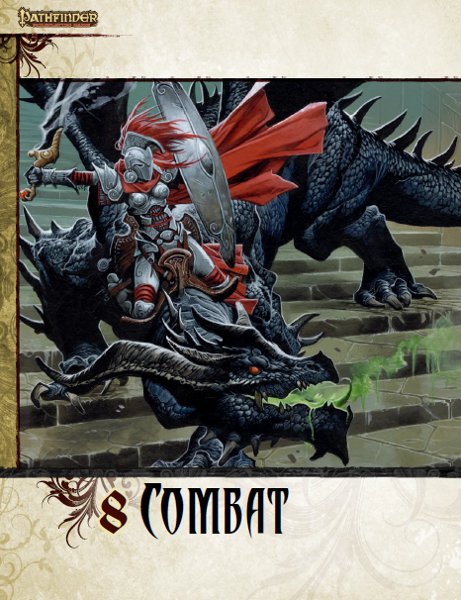
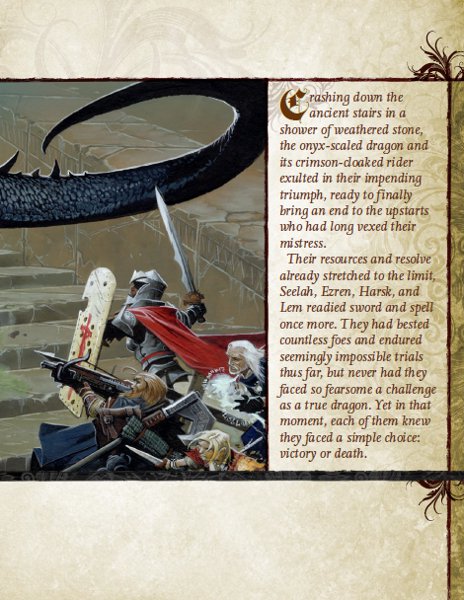
Disappointment results when we learn there's no rules for targeting bad boobplate.
Victory... or death!
Well, that's going to make for some short campaigns if the latter comes up too often. But this isn't the sort of system for those that play magical tea party baby games*!
How Combat Works
There's initiative rolls, determining surprise, resolving the surprise round, start normal rounds... each round is 6 seconds, etc.
Combat Statistics
You have your attack roll, which uses your Strength modifier and attack bonus (for melee) or Dexterity modifier and attack bonus (for ranged). You get your Armor Class, which is 10 + armor & shield bonus + Dexterity modifier. Sometimes you'll be flat-footed (stunned, surprised, stupid) and you don't get to use your Dexterity modifier, and sometimes things like bad touches ignore armor (like a lot of "touch" spells).
There are other bonuses and penalties you'll give from magic or feats or size or whatever. None of these can "stack" if they're bonuses of the same type, except dodge bonuses.
Then there's damage, where you get to add your Strength to a roll of dice dependent on your weapon. There's all sorts of side cases like if you have penalties to damage and don't do any damage you still do 1 nonlethal point instead and damage varies depending on what hand is holding a weapon as mentioned earlier and there's ability damage that can damage your abilities. And so on.
If you hit points hit 0, you're disabled. If they hit -1, you're dying. That's a bizarrely small cusp. And when you reach -Constitution, you die.
There's also attacks of opportunity, where if you rush in or out of somebody's weapon range, they get an attack against you. If you just mosey in or out, you're fine. Some other things also provoke these attacks of opportunity, like casting spells or firing ranged weapons. Each character can only make one attack of opportunity per round, unless you have the Combat Reflexes feat, which allows you to add your Dexterity modifier to the amount of attacks you can make.
Yes it is another example of Dexterity being
necessary for a melee feat-
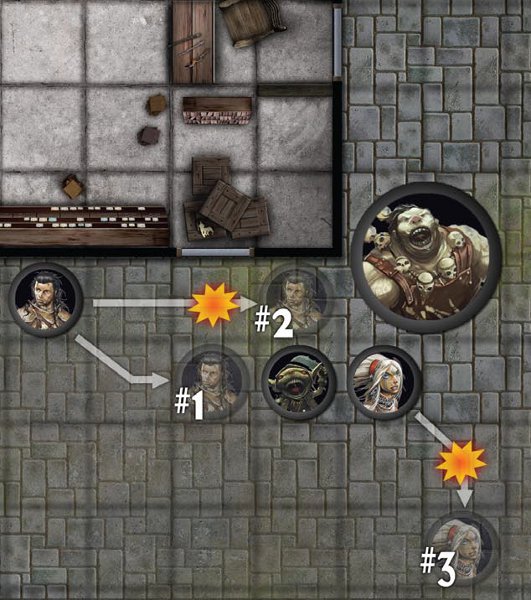
An example of when attacks of opportunity are triggered. Remember, the use of miniatures in Pathfinder is optional.
Anyway, there is a huge chart detailing when attacks of opportunity happen and when they don't, and visual aids.
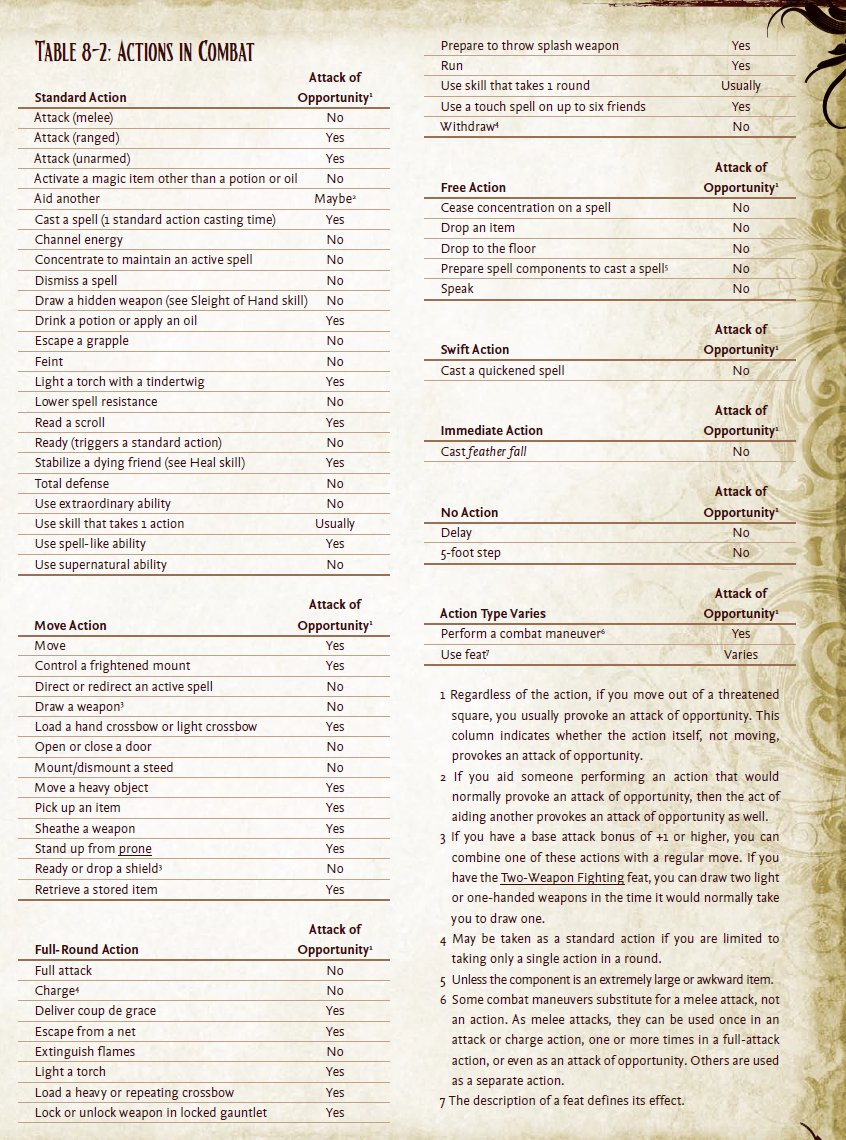
Pathfinder's simplified Attacks of Opportunity.
Yeah. Anybody who tells you Pathfinder "cleaned up" Dungeons & Dragons 3.5 , just point them at that page. No thanks are necessary, my misery is a public service.
They go over speed (again), and then we get saving throws. There are three types: Fortitude, which is used against stuff that attacks your body which is not hit point damage, Reflex, which is used to dodge things but is not related to your Armor Class, and Will, which is used to resist mental effects but is not your Concentration check.
Confused yet? Awesome!
Anyway, saving throws are usually done against spells, traps, and certain monster abilities. Why yes, d20 is wonderfully redundant, what with Constitution checks, Hit Points, Fortitude saves, etc.
Actions in Combat
There are different kinds of actions. You can perform one standard, move, and swift action in a turn, or a full-round action and a swift action in a turn, and any number of free actions, or two move actions and a swift and some free actions-
-
Standard Action:
This lets you do one action, like attack or case a spell.
-
Move Action:
This is usually used to move but also covers some miscellaneous actions like drawing a weapon.
-
Full-Round Action:
These are long actions that take all your effort. The most common is a full attack where you do multiple attacks in one round, if you're an experienced combatant.
-
Free Action:
You can do any number of these, but the GM may restrict how many you can do.
-
Swift Action:
Like a free action, but you can only do one a turn.
-
Immediate Action:
Like a swift action, but it can be performed at any time.
-
Not an Action:
Yeah. They define this.
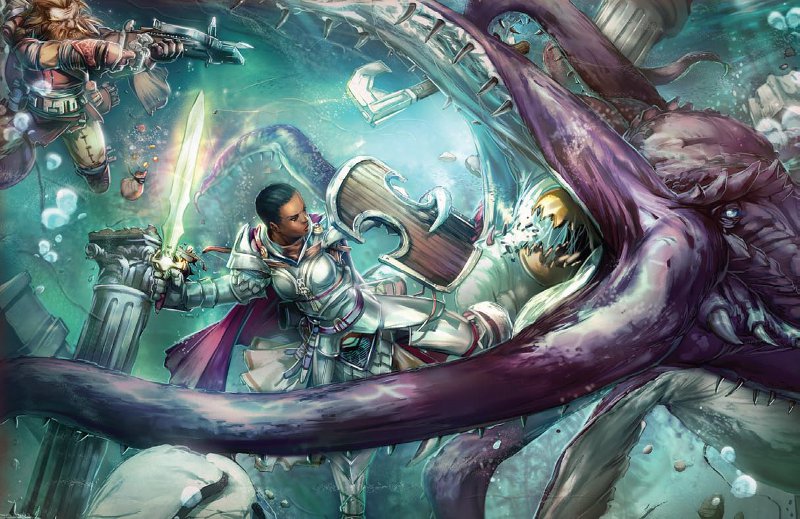
It took me a bit to realize they're supposed to be fighting underwater. (Those rules are later.)
Standard Actions
Here's standard actions you can do. Standard actions are the big, valuable piece of the action economy, like attacks and spells.
-
Attack:
This lets you do a melee, unarmed, range, or natural attack. You get a penalty to fire ranged weapons when the target is engaged in melee with a friendly character, a rule everybody always forgets about. Also, you can fight defensively, taking a -4 for attack for +2 to Armor Class, but nobody ever does that. Critical Hits are covered again.
-
Activate a Magic Item:
There's two types, there's spell completion items like scrolls where you're casting a spell from an item, which provokes attacks of opportunity, and then stuff like wands and rods that don't.
-
Cast a Spell:
There are several requirements, like if it has a verbal component, you have to be able to chat, and if it has a somatic component, you have to be able to swing. Preparing components is a free action for some reason. Also, spellcasters have to be able to concentrate, but those rules are detailed elsewhere, and I'll get to them later. Casting a spell provokes attack of opportunity, but you can make a Concentration check to prevent it from doing so. Also, you can cast spells that require a touch attack and get that attack as a free action, because :wank:
-
Start/Complete Full-Round Action:
Just in case you can't be bothered spending a full round, you can start a Full-Round action with a Standard action in one round, and then finish it with a Standard Action in the next.
-
Total Defense:
This lets you guard yourself for +4 to Armor Class.
-
Use Special Ability:
You can use magic powers, which provoke attacks of opportunity, but supernatural abilities don't (?). Extraordinary abilities, which are special actions coming from skill or training, also don't provoke attacks.
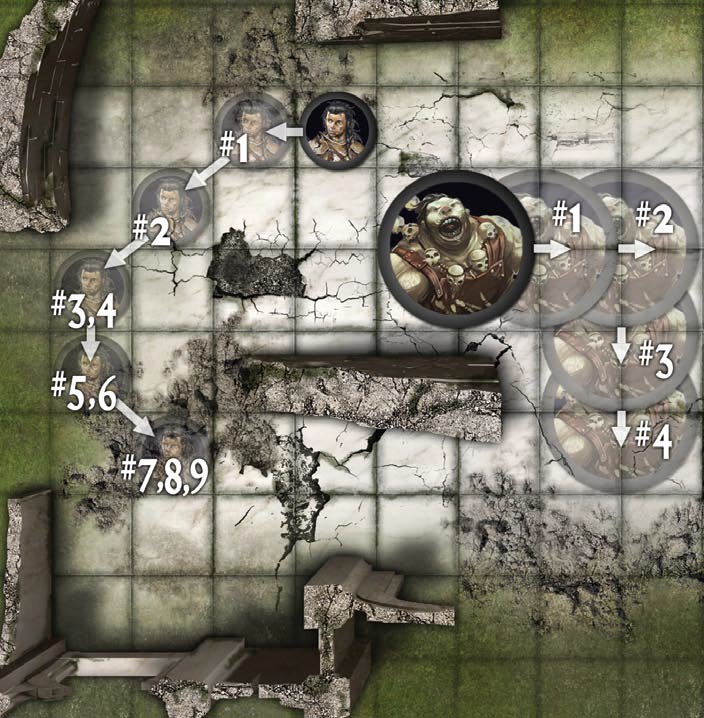
An example of movement through difficult terrain. Remember, the use of miniatures in Pathfinder is optional.
Move Actions
These are move actions. But they're not always involving moves, sometimes they're just lesser actions that are less taxing than standard actions. Confusing? Sure.
-
Move:
Well. I bet you saw this coming. Includes climbing and crawling.
-
Direct or Redirect a Spell:
If your spell lets you do this, this is how you do it.
-
Draw or Sheathe a Weapon:
This is a move action. If you have any basic combat training (an attack bonus of +1 or higher), you can do it as a free action. Not sure why this is differentiated, considering all PCs will have a +1 on attacks by level 2.
-
Manipulate an Item:
Like picking up an object or opening a door.
-
Mount/Dismount a Steed:
You can also do it as a free action with a successful Ride check, but only once a turn.
-
Ready or Drop a Shield:
Pretty much just like drawing a weapon, you can do it as a free action with training.
-
Stand Up:
If you're knocked over, this lets you stand up.
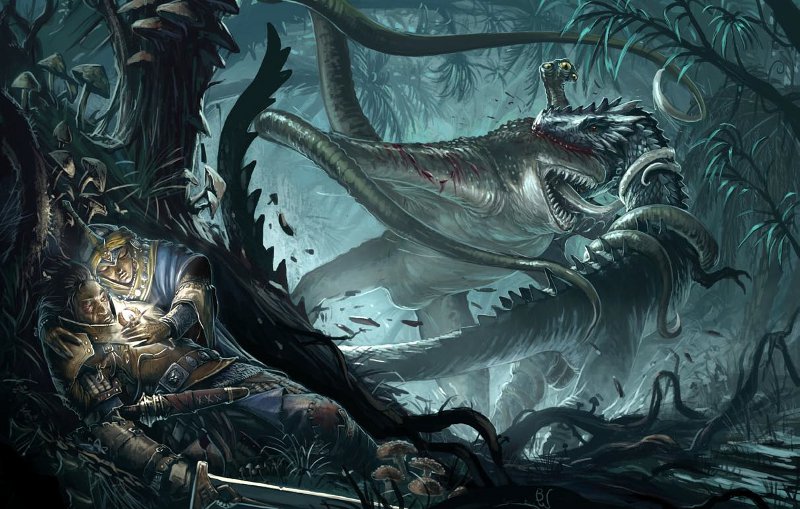
This is a pretty nice picture.
Full-Round Actions
These are the sort of big deal actions that take your entire turn. Mostly just a means to punish warriors to take multiple attacks.
-
Full Attack:
High-level combatants can do multiple attacks with this action, though each attack has large penalties to hit. This is a real problem for high-level warrior types, as it severely restricts their movement and options if they really want to be able to deal damage.
-
Cast a Spell:
Basically if a spell takes a full-round, you take a turn casting it and it takes effect on the beginning of your next turn. Also, sorcerers and bards need to take a full-round action to apply metamagic feats to their spells, because they're not wizards and clerics, which are better.
-
Move 5 feet through Difficult Terrain:
This lets you move 5 feet through difficult terrain without provoking an attack of opportunity.
-
Run:
This lets you run really fast but provoke attacks.
-
Use Special Ability:
Some rare special abilities may require a full-round action.
-
Withdraw:
This lets you do a double move without provoking an attack of opportunity to escape.
These are miscellaneous actions that barely take any effort.
-
Cease Concentration on Spell:
You just quit that spell, quitter.
-
Drop an Item:
Uh. Work it out.
-
Drop Prone:
There is very little benefit in ever doing this.
-
Speak:
You can only speak a few sentences, make sure to enforce this, GMs!
Like a free action, but you can only do one a round.
-
Cast a Quickened Spell:
If you have this busted feat, this is how you use it! Hooray!
There really aren't too many of these, they take up your swift action on your turn. Feather fall , a spell, is the only example they give.
Miscellaneous Actions
As if this wasn't complex enough, here are some special cases!
-
Take 5-Foot Step:
Whenever you don't move in a turn, you can take a 5-foot step that doesn't provoke attacks of opportunity.
-
Use Feat:
Some feats require actions.
-
Use Skill:
Some skills require actions.
Pathfinder Roleplaying Game posted:
What Hit Points Represent: Hit points mean two things in the game world: the ability to take physical punishment and keep going, and the ability to turn a serious blow into a less serious one.
But as you go up in level, it takes more healing to heal you, which means the less serious injuries are actually more serious or something and hit points still make as much sense as a mace of sharpness .
Also if you take 50 points of damage or half your HP on a single attack, whichever is more, you have to make a Fortitude save OR DIE.
If you're at 0 HP, you're disabled and can only take one standard action before doing into dying. If you're dying, you lose 1 hp a turn until you stabilize. You get to make a easy Constitution roll each turn to try and stabilize. Healing and Heal checks can stabilize you as well.
You heal 1 hit point per character level. Yes, that means tuff characters with more HP per level (like barbarians and fighters) effectively take longer to recover and heal than weak-bodied wizards or sorcerers. They also require more magical healing. This makes no sense, but Pathfinder is bad at math, as we're well aware by this point.
There's also nonlethal damage, but who cares? I want to see blood, you sissies!
Movement, Position, and Distance
It goes over the basics of movement (again) - encumbrance, hampered movement, movement actions, etc. Every square on a combat map equals 5'.
You can't move through an enemy square while they're up and about without making an Acrobatics check to cartwheel past them.
There's difficult terrain that slows you down, and obstacles that slow you down more. Flying and incorporeal creatures ignore this, of course.
Big and Little Creatures in Combat
Really small creatures can stuff into a square with other creatures. Really big creatures take up multiple squares. basic stuff. They get certain penalties and bonuses based on size, etc.
Combat Modifiers
Cover gives you a bonus to Armor Class, sensibly enough. Concealment, though, gives a random miss chance. Yes, a 20th level fighter and a 1st level fighter get an equal chance to whiff an unseen foe. Which is dumb, but that's how they do.
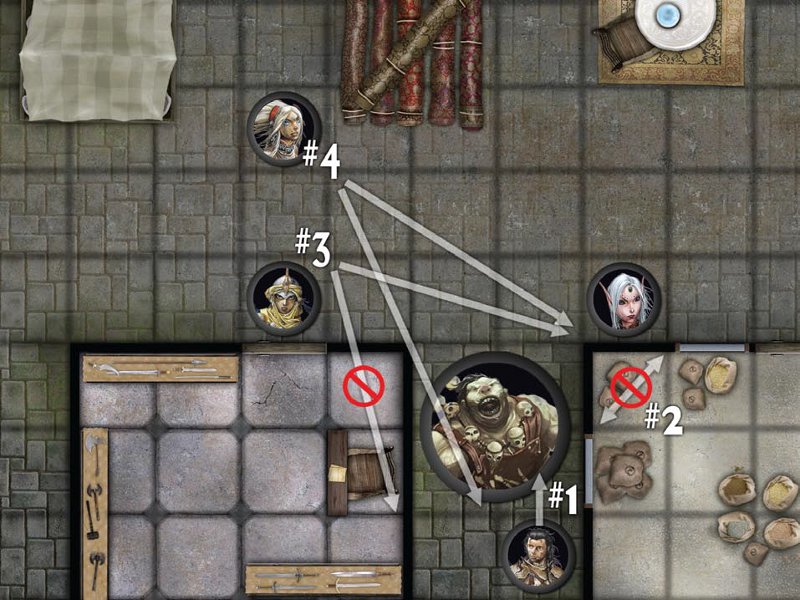
An example of the cover mechanics. Remember, the use of miniatures in Pathfinder is optional.
You can flank foes by having two people on opposite sides. This gives a bonus to hit and let rogues get their Sneak Attack on. It's the main way rogues will get their Sneak Attack on.
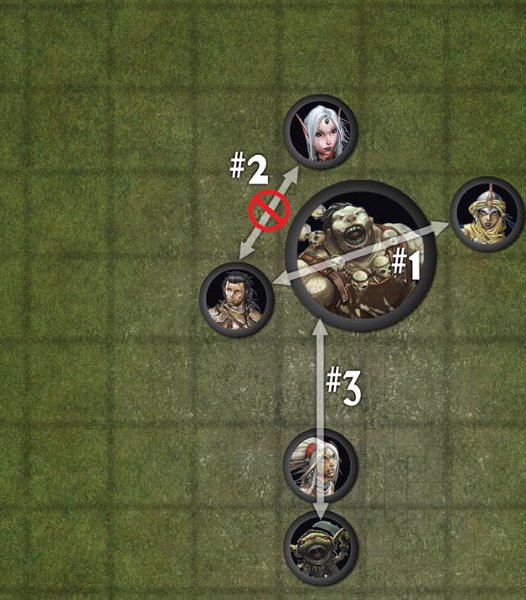
An example of flanking. Remember, the use of miniatures in Pathfinder is optional.
Special Attacks
These are different moves you can do in fights:
-
Aid Another:
A simple attack roll can add a bonus to an ally's attack or defense.
-
Charge:
This lets you get a double move and and an attack as long you move straight at your foe. You get an attack bonus and a defense penalty.
-
Combat Maneuvers:
Unlike
Dungeons & Dragons 3.5
, Pathfinder uses a unified mechanic and bonus for bull rush, disarm, grapple, overrun, sunder, and trip, as mentioned earlier.
-
Combat Maneuver - Bull Rush:
Lets you shove people around the battlefield. Provokes an attack of opportunity.
-
Combat Maneuver - Disarm:
Lets you try and knock a weapon out of somebody's hand. Provokes an attack of opportunity.
-
Combat Maneuver - Grapple:
Lets you try and grab somebody and hold them. Lets you do various effects like try and damage or pin your foe while you have them held. Slightly simplified from
Dungeons & Dragons 3.5
, but still pretty complex. Provokes an attack of opportunity.
-
Combat Maneuver - Overrun:
Lets you try and move through somebody's space forcibly, and can knock them over. Provokes an attack of opportunity. Also, you foe can just ignore you and let you through.
-
Combat Maneuver - Sunder:
Lets you try and damage an item held by an opponent. Provokes an attack of opportunity.
-
Feint:
Lets you use a Bluff check against your foe's Sense Motive to make a target flat-footed. As noted, many monsters don't have Sense Motive, making this is a rather problematic mechanic.
-
Mounted Combat:
Requires Ride checks to guide your mount, gives you extra movement, attack bonus, and makes ranged attacks and spells more difficult while moving. Note if your mount moves, you can't do a full attack.
-
Throw Splash Attack:
These is the scatter rules for grenades. You can target a single point with the attack, which lets you do splash damage only, but is super-easy to hit.
-
Two-Weapon Fighting:
Fighting with two weapons lets you get an additional attack at extreme penalties. Unless you pay the feat tax, this isn't typically ever an option worth taking. You can also do this with a double weapon if you're proficient in it. Also you can use these rules for thrown weapons as well.
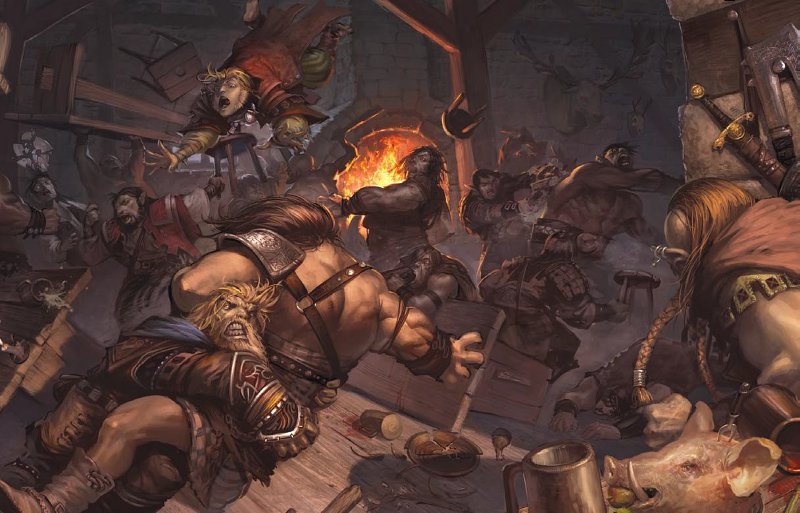
I can count 18 dice rolls required to make this scene happen. Can you find more?
Like Dungeons & Dragons 3.5 , several options here provoke attacks of opportunity, requiring you to take feats like Improved Disarm to perform them without getting shivved. Though the unified mechanic is nice, requiring a feat for each has something of a chilling effect. Putting risk on a lot of these moves makes people less likely to use them. And putting a feat tax on them actually makes them less likely to take a feat just to use them, when it would be simpler just to take feats that improve damage-dealing capabilities or class features. Worse yet, if you want to perform a combat maneuver without being strength-focused, guess what? There's a feat tax if you want to use dexterity instead.
In short, they potentially make combat a lot more boring, and I think it's the wrong move to make.
Now, to be fair, those who focus on a given maneuver will be a lot more effective than they were in Dungeons & Dragons 3.5 . The odds of actually succeeding for a focused and skilled combatant shake out better, though you still run into the problem where as you go up in levels - and face bigger monsters and greater spellcasters - the less effective it gets. This is either due to the creatures you face being too strong or big to effect reliably, or having magical or supernatural effects that allow them absolute immunity to your tactic.
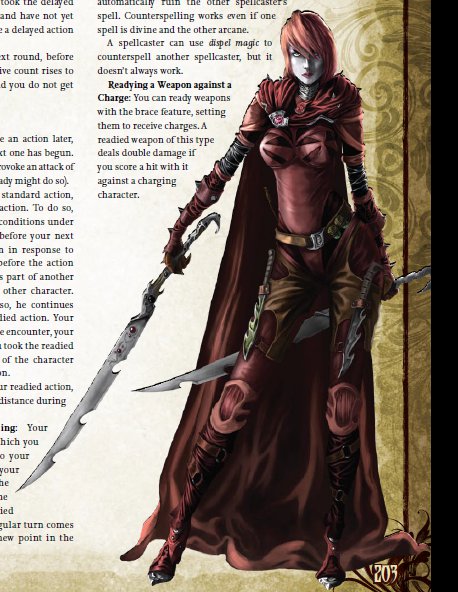
I believe her proportions indicate the aberration creature type.
Special Initiative Actions
Oh yes, we're not done with special edge cases for actions.
-
Delay:
Basically, you can voluntarily reduce your initiative for the rest of the combat to act later.
-
Ready:
You can declare an action to use later under certain circumstances, and act later in the round that way. This also changes your initiative position, making it a lot less useful than
Dungeons & Dragons 3.5
, where you kept the same initiative count, though you always act before the person you readied against. Seems potentially more complex to track, and I'm not sure why the change was made. Anyway, this is how you ready for counterspells or ready a "brace" weapon against a charge.
Next: Fuck me, it's magic.
* Yes, I am referring to Woof Meow .
Grappling
Original SA post
Pathfinder Roleplaying Game Part 9a: Grappling
I didn't run across the material I'm going to include here before the post I made on combat today, which is too bad, because it totally deserves inclusion. So I'm putting it here. See, I write ahead on these FATAL & Friends writeups, way ahead in Pathfinder's case, which is what allows me to post every day. Right now, I've already started on work for the next book I'm doing, which required me to look up the grapple rules to refresh myself on something. Instead of turning to the Pathfinder Roleplaying Game , though, I turned to the Pathfinder System Reference Document , since that's easier to dig through for some things.
And well. I mentioned that they simplified grappling. And that's a bit of a misnomer, because more importantly, they just phrased it better for the most part and cleaned up the language. It's still complicated. How complicated?
Well, I found this chart on the SRD that sums up the grappling rules for those who find themselves puzzled.
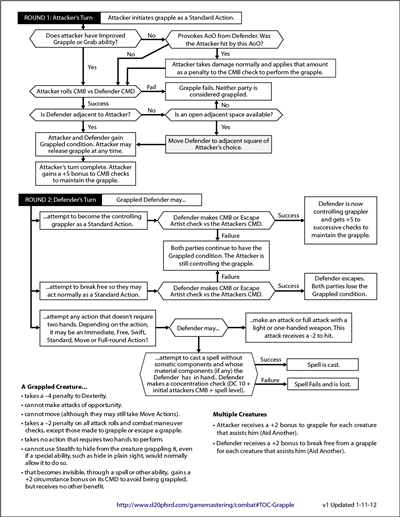
I have nothing more to add.

Next: Magic... for real, this time. Fffffufufuuuuuuuuuu-
Magic
Original SA post
Pathfinder Roleplaying Game Part 10: Magic
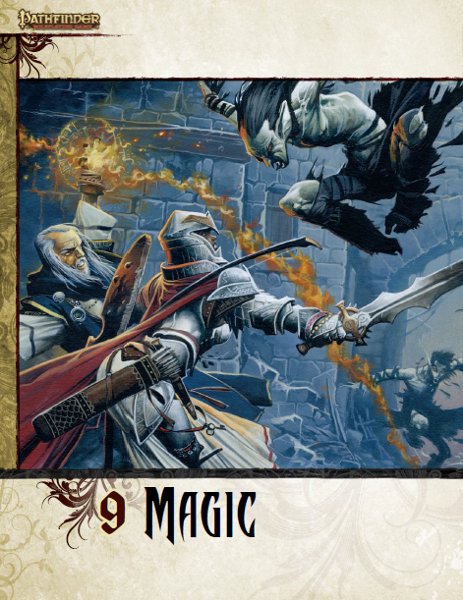
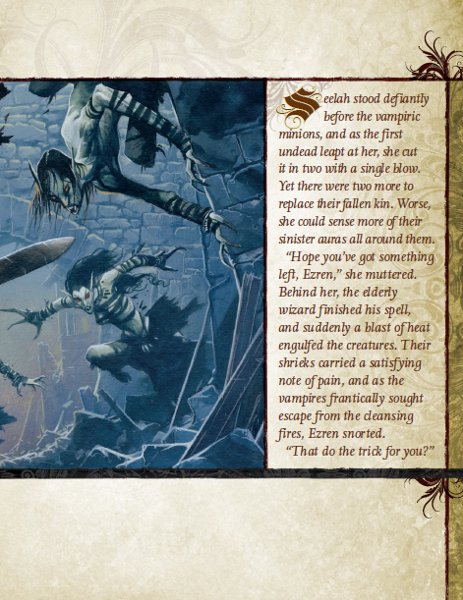
Yep, the spellcasters do the heavy lifting even in the flavor fiction.
Erik Mona, Head Publisher at Paizo posted:
[Vancian magic] anchors the game to the pulp fantasy traditions that inspired it in the first place. After three decades of presenting magic in this way, it seems ludicrous to all of a sudden say that it no longer exists. You can build other systems of arcane jiggery-pokery without sacrificing this core fantastic element of the game, so why bother?
The more you cut the ties the game has to the pulp fantasy traditions that inspired it, the less it begins to resemble itself. It's part of the lingua franca of the game, and it has been since the very beginning. It is a feature, not a flaw.
Getting rid of Vancian spellcasting for the Pathfinder RPG was never on the table. It would be as preposterous as scrapping the alignment system. It was Not Going to Happen.
I'm preparing to curse at Erik Mona. A curse on you, Erik Mona. I have cast my curse.

Fuck him and his grog cronies for keeping this overcomplicated mess of a system intact like a memetic filth to infect future gamers just because it Came Before. Kill it. Kill it with fire.
Am I overreacting? Yes. Still. It's a mess.
Casting Spells
First, you choose a spell to cast. This may be a spell you've prepared, or, if you're a bard or sorcerer, a spell of your choosing from your list. You have to be able to produce all components, like somatic (handwaves), verbal (blabbin'), and material (eye of newt). You can't cast it again before taking a nice eight hour nap.
Yep. Once you're out, you're largely useless until you can have some warm milk and naptime.
Then, you have to be able to concentrate. The formula for a concentration check is:
1d20 + Spellcasting attribute modifer + caster level
You have get injured, you have to make a concentration check. Doesn't happen very often. Generally, other people have to ready an attack to do so, or you have to be taking continuous damage like acid rain, or you have to be casting one of the few spells that takes a long time. You also have to make a check if you get nailed with a Bad Spell during casting. If you're being grappled, you can't cast any spell with somatic components or material components you don't have in had, it requires a concentration check. Same if you're suffering vigorous or violent motion like an earthquake or storm. Trying to cast while entangled also requires a concentration check.
You can also cast defensively to avoid getting stabbed while casting a spell. If you fail, you lose the spell, but don't get nailed with an attack of opportunity.
Whew!
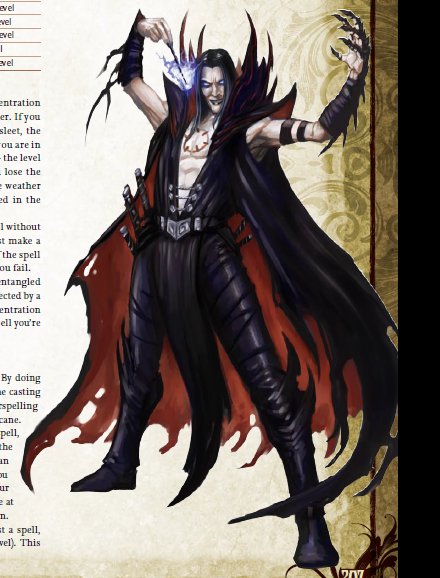
Anachronistically tacky.
Counterspells
If you ready yourself for countermagic, and you make a spellcraft check to identify a spell being cast, and you have the exact spell being cast prepared, and you successfully cast it, you can automatically negate another spellcaster's spell.
You can also use dispel magic in place of a spell. This only gives you a certain chance of success, though.
How's that for arcane rules! Get it? Arcane?
Caster Level
A lot of spells level with you. This is a big advantage casters get, that they automatically get bonuses to range, area, damage, effect, etc., based on your level.
Spell Failure
This mainly comes up if you're wearing armor, as mentioned before. I wonder what sort of combat manuever it is to throw a chain shirt on a spellcaster?
The Spell's Result
And once all of the above is figured, yay! You can figure out what effect the spell has.
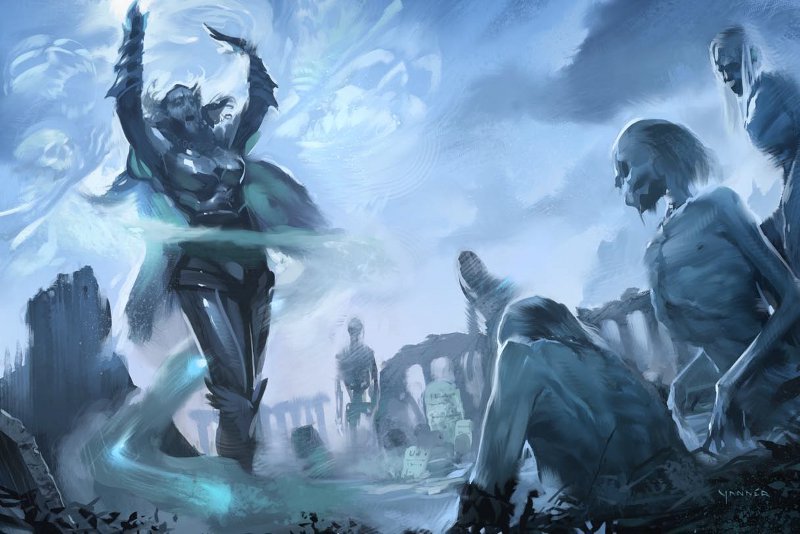
Boobplate. Again.
Special Spell Effects
Some spells use other special rules!
-
Attacks:
Some spells require attack rolls and are treated as attacks when referenced as such. Channeling energy is an attack if it would do any harm.
-
Bonus Types:
Some spells give bonuses, but bonuses of the same type don't stack.
-
Bringing Back the Dead:
Basically, you might get negative levels from dying or constitution loss (if you're first level). Most revivification spells require the body to be present, and the soul not to be locked up somewhere. Lastly, a soul knows the name, alignment, and deity of anybody trying to bring them back, and can refuse.
You can stack spells with different bonuses together. If you have the same spell cast repeatedly, the highest-strength version applies and the last spell's result applies. If two people are trying to control the same creature and have contradictory commands, they must make opposed Charisma checks to see who wins out.
Spell Descriptions
Spells have a formulae through which they are described. There's a name, and:
Every spell has a magic school, which mostly just matters to sorcerers and wizards, who have abilities that give them bonuses or penalities with certain schools.
-
Abjuration:
These are protective, one-trick pony kind of spells. Except a lot of the best defensive spells aren't in this school, so. It's kind of dumb. It also lets you banish things.
-
Conjuration:
Creates or moves matter. Some of the best spells, including summoning creatures, creating objects, healing, teleporting, etc. Embarasses the other schools by being so utilitarian and awesome.
-
Divination:
Lets you find stuff out. Lots of great spells, but a lot of redundancy here. The Perception skill can notice magic sensors created through this school, somehow, as if it wasn't good enough.
-
Enchantment:
Magic that lets you mind control and otherwise effects minds. Very narrow as it requires A) somebody you're willing to mind control, B) somebody vulnerable to mind control (i.e. not a zombie or robot), and C) somebody you can actually mind control (doesn't have a high will saving throw). Pretty strong if you have all those ducks lined up, though.
-
Evocation:
Lets you throw energy. Great for doing damage. Doing damage is great, but a bit limited around the house.
-
Illusion:
Lets you create illusions and turn invisible and stuff like that. Has some of the best defensive spells, ha ha, suck it, abjuration. A lot of these don't have saving throws until you interact with the illusion, which is a wonderfully vague description. "The non-light not-bouncing off the illusion that enters my eye is fake, I'm interacting, I get a save!" Overly complex and vague save mechanic.
-
Necromancy:
Lets you raise the dead and also just do generally evil and gross things to people. Pretty solid as it lets you cripple people and get undead minions, but somewhat limited.
-
Transmutation:
Lets you transform things. Mostly best for making yourself into a totally awesome monster, but not a lot else where. There's over a half-page of notes on now polymorph spells work and all the special cases they introduce. Pathfinder is trying to simplify this, and they're still the most complex spell rules in the game, loaded with if/then special cases, so I'm going to call failure on that.
-
Univeralist:
Grab bag of useful spells they couldn't put in a category due to being too general or too powerful.
Next, spells get descriptors (evil, fire, mind-affecting), which can affect certain abilities that interact with spells with those descriptions.
Spells have a level between 0 and 9, which you cross-reference with a table under your class to see what spells you can cast at what level. Why not just use the caster level instead of having a specific spell level? Because that's the way Dungeons & Dragons did it in previous editions and making things easier to use is less important than that.
Components describes what spell components are needed-
Pathfinder Roleplaying Game posted:
Usually you don’t need to worry about components, but when you can’t use a component for some reason or when a material or focus component is expensive, then the components are important.
Oh, maybe not. See, warriors need to track and pay for every arrow they shoot, pay for expensive armor, pay for expensive alchemical items, possibly get their weapons or armor damaged by spells or rust monsters, but spellcasters? Oh, they get their items handwaved, unless they're captured and stripped or if their material cost is an expensive penalty cost.
Because fuck fighters . Also, if you don't need to track them, why are they there in the first place?
Because mindless adherence to tradition is awesome.
There are also focuses and divine focuses, which are basically components that can be reused.
There are several ranges for spells, from personal (only affects you), to touch (requires you to poke as mentioned under combat), and then close, medium, long, or unlimited. If a spell has a target, you have to be able to see it, unless the spell says otherwise. Then there are some special effects to detail:
-
Burst:
These are areas that are stopped by cover and walls.
-
Emanation:
These are like bursts but have a duration and last for a bit.
-
Ray:
Ray spells do a ranged touch attack - an attack that ignores all armor. Even if it does harm. Apparently armor is no good against magic rays, of some reason. These can critically hit, too.
-
Spread:
These are area effects that are stopped by walls but can go around them, usually gases.
-
Cone:
Starts small where you're at and then widens out to its area at its full range.
-
Cylinder:
Like a burst, but it ignores cover because it goes wayyyy up and shoots down.
-
Lines:
Shoots in a long line and is not stopped by creatures, only barriers.
-
Shapeable:
Some give a specific area you can shape however you want.
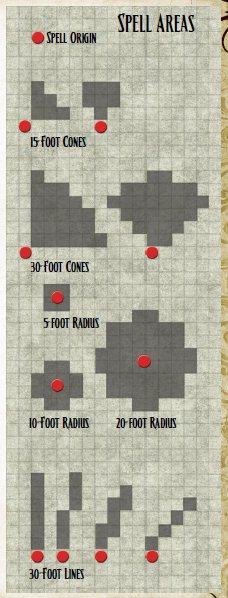
Spell blast templates. But remember, the use of miniatures in Pathfinder is option- *snort*, okay, can't say it with a straight face anymore.
Spells have duration. Some have timed durations, others are instantaneous, others are permanent, some require concentration (which takes a standard action each round) to maintain, and there's other funky stuff, like spells that last forever until discharged.
Some spells have a saving throw to reduce or cancel their effects. The formula is:
DC 10 + spellcasting attribute modifier + spell level
You can voluntarily accept a spell. There are a lot of special cases here, blah blah blah.
Armor and shield doesn't protect you against spells, because fuck fighters. You thought you could use your magic shield and block the party from that fireball ? Ha ha, fuck you, you burn as easily in plate armor as you do in padded.
Some creatures have spell resistance, where the caster has to make a caster level check to overcome their # of spell resistance. The formula is:
1d20 + caster level
This ability exists because saves are complicated and sometimes you don't get them so they came with an entirely separate mechanic rather than clean up the saving throw rules because-
- Pathfinder is bad at rules.
Arcane Spell
I'm not done yet? But... but...
Sigh.
Arcane spells are the sorts of spells cast by wizards, sorcerers, and bards. Each gets a number of spell slots of each spell level. You can put lower-level spells in a spell slot than its spell level, but not vice versa. If for some reason you can't cast spells of a certain level (your character was built really badly) you can fill the higher-level slots with the highest level you can cast instead.
Why limit spellcasting by attribute, when Dungeons & Dragons didn't do it in older editions before 3.5? Copy / paste, really. Oh, and for the record, sorcerer and bard spellcasting is controlled by how likeable they are. I'm not sure how that works either. Maybe magic is just really shallow and vain?
Wizards have to sleep for eight hours and prepare for one hour. I imagine this makes a lot of career wizards nap-happy. Wizards also need their spellbook, unless they have the Spell Mastery feat, that lets them prep spells without a spellbook.
Unfamiliar scrolls and spellbooks require a Spellcraft check to decipher, or you can just cast read magic , which is a 0-level spell, and fuck Spellcraft. A wizard using a borrowed spellbook has to make a roll for every spell they can cast from it. This can be dozens of rolls at higher levels. Enjoy bogging the game down!
Now time for wizards to break the game over their knee. See, wizards get two extra spells in their spellbook every level. Or, they can copy spells from scrolls or spellbooks. Or they can just research a spell they don't have access to and create that, or even create their own spells (there are rules for doing this, but no guidelines on creating spells like I win or defenestrate fighter .
A spellbook has limited space, but you can have multiple spellbooks, so that's not an issue. Writing books into a spellbook costs gold and hours, but it's generally just a token gold cost for your level.
Sorcerers and bards don't have to futz around with spellbooks, but only gain spells by leveling up. They only require 15 minutes of preparation after their 8 hour sleep. Yay, only 8 hours and 15 minutes instead of 9 hours!
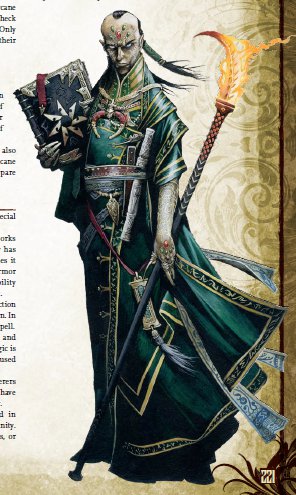
"You'd have a sour expression like mine too if you'd drilled gems into your skull!"
Divine Spells
Divine spellcasters (rangers, paladins, druids, clerics) prep their spells like wizards, only they don't have a spellbook, they just take whatever spells they need off their spell list. Yes, this results in any supplement you use with divine spells directly boosting the versatility (and likely power level) of divine casters, because they just prep any damn spell they like.
Also, they don't need a nap, they just need a particular time of day to prep and regain spells. You have to prep right then, even if it's fightin' time, and if you oversleep or forget, no spells for you. Prepping takes an hour, and any spells you cast in the last eight hours cast against the amount of spells you can prep.
There are divine magical writings, which Knowledge (divine) won't help you with, you still need Spellcraft.
If being able to cast any spell from your class list wasn't enough, divine casters can research and create new spells just like wizards do.
Special Abilities
There are spell-like abilities, which are like spells, but don't require components or focuses, even if the spell usually does. They can be cast in armor, and can't be counterspelled. It doesn't say explicitly if they require concentration checks when necessary.
There are also supernatural abilities, which are affected by stuff that messes with magic, but don't resemble spells.
There are extraordinary abilities, which are like supernatural abilities, but are not supernatural, and there's natural abilities, which are like extraordinary abilities, but come from a creature's "physical nature", like poop.
Next: See that shadow blotting out the sun? That's the spell section.
Spells
Original SA post
Pathfinder Roleplaying Game Part 11: Spells
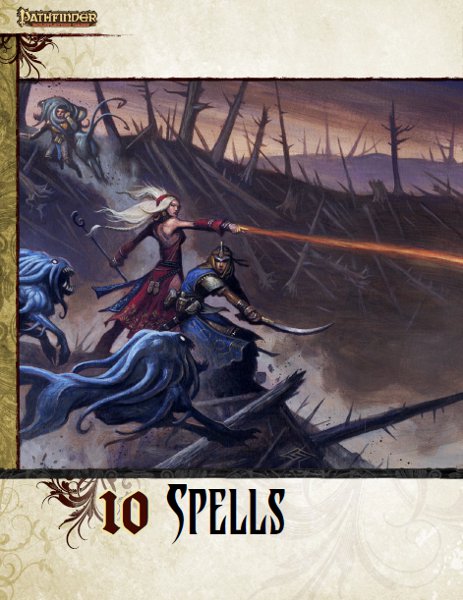
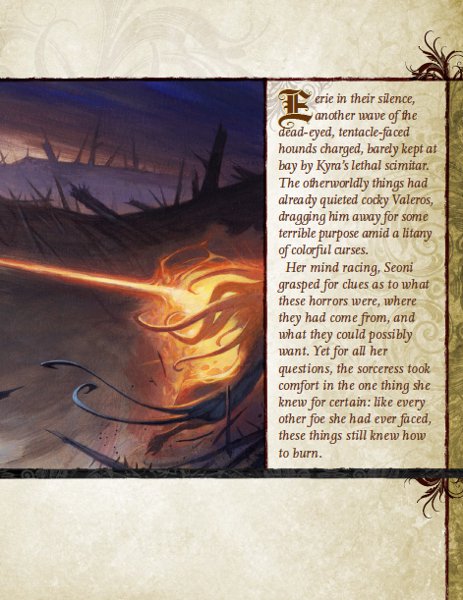
Note the fighter in the background just getting dragged off.
I just want to cover a interesting set of numbers first:
-
Introduction (2 pages)
-
Chapter 1: Getting started (10 pages)
-
Chapter 2: Races (8 pages)
-
Chapter 3: Classes (54 pages)
-
Chapter 4: Skills (24 pages)
-
Chapter 5: Feats (26 pages)
-
Chapter 6: Equipment (24 pages)
-
Chapter 7: Additional Rules (10 pages)
-
Chapter 8: Combat (26 pages)
-
Chapter 9: Magic (16 pages)
-
Chapter 10:
Spells (
148
pages)
-
Chapter 11: Prestige Classes (20 pages)
-
Chapter 12: Gamemastering (32 pages)
-
Chapter 13: Environment (16 pages)
-
Chapter 14: Creating NPCs (8 pages)
-
Chapter 15:
Magic Items (94 pages)
-
Appendices (26 pages)
Why don't barbarians, rogues, and fighters get 100+ pages of combat feats? Why don't they get rules on being able to train and spend GP to expand their feats known like wizards and clerics do for spells?
I'm sure you can work out your own answers at this point.
I'm going to look at each class and pick out some choice spells for each. Going through the 400 or 500 spells or so that are in here would be a bit more insane than even I'm willing to tackle.
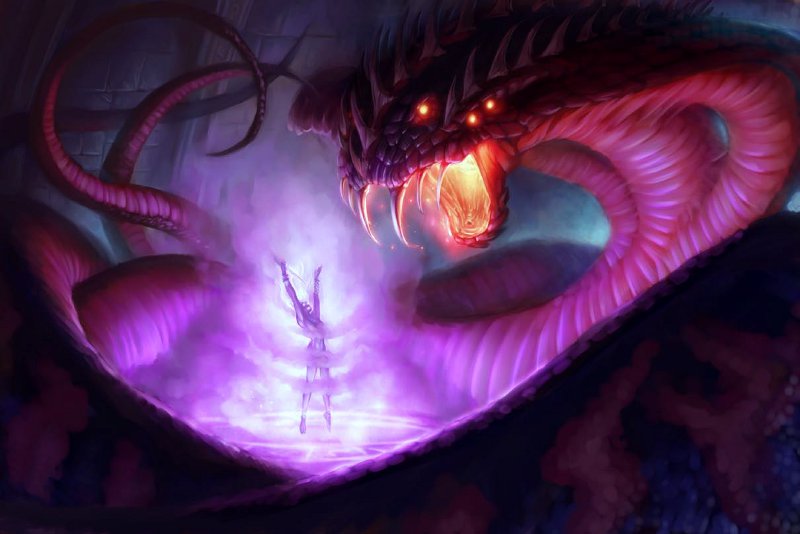
Magically delicious?
Bard Spells
Bards get a mix of enchantment, illusion, and healing, largely. Their progression is unique to them; no other class in the core gets a middle-of-the-road progression like they do. But that defines bards pretty well: good at many things, great at nothing.
0-Level
-
Mage Hand:
Telekinesis on five pounds of unattended objects, whenever you want.
-
Read Magic:
Never have to make a Spellcraft roll to decipher magic texts again.
-
Feather Fall:
Utter immunity to a single fall is a 1st level spell. If you're heavily specialized in Acrobatics, you can reduce fall distance by 10'. Compare and contrast.
-
Unseen Servant:
Gives you an intangible servant. Want to open a door or lock you think might be trapped? Take an item out of boiling water? Carry an item out of den of monsters? The unseen servant is the perfect way to break a lot of low-level, conventional traps and encounters.
-
Detect Thoughts:
A good low-level mystery-busting power.
-
Invisibility:
I don't need to even describe how good this is. You can't attack without dispelling it, but that's about it for drawbacks.
-
Blink:
Attacks and spells only have 50% chance of hitting you, you take half damage from area attacks, and can move short distances through solid objects. A good example of how ridiculous defensive spells get.
-
Charm Monster:
Target a dumb monster, make it a friend for
days
.
-
Dimension Door:
Short-distance teleport. Another great way to evade traps, hazards, and monsters.
-
Hold Monster:
Save or suck. Lets you paralyze any creature for a minute or more on a failed save, during which the average Pathfinder party can kill the average monster approximately ten times (before it hits the floor).
-
Mind Fog:
Creates a fog that, on a failed save, gives targets -10 to will saving throws, which is the equivalent of saying 'you lose' to subsequent enchantment effects. Bards have a lot of effects that target that and can easily make a monkey out of any creature that fails that save.
-
Song of Discord:
Targets a group of enemies. On a failed save, they have a 50/50 chance of attacking their fellows. This lasts a minute or so.
-
Irresistible Dance:
It really is. The target dances for a single round even on a successful save.
-
Permanent Image:
A perfect illusion that lasts forever (unless dispelled by other magic). 1001 uses.
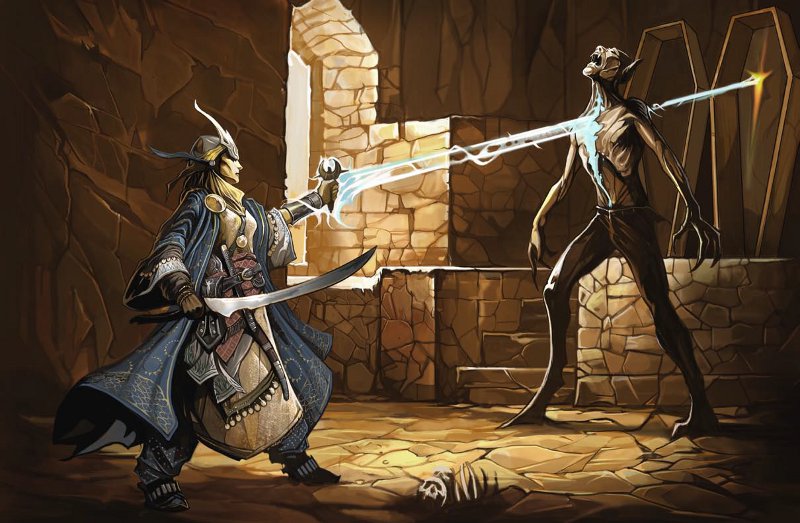
"Welcome to our scenic burial cham- ow! Ow! What the hell?!"
Cleric Spells
Clerics start out getting mostly support, healing, and alignment-oriented spells, but later on they get much broader, random effects. They have probably the second strongest spell list in the game, behind wizards and sorcerers.
0-Level
-
Create Water:
A cleric can cast this infinitely, so kiss all grim desert or seagoing survival adventure goodbye!
-
Cure Light Wounds:
Ahhh, the essential dilemma of the cleric! Heal your friends, or do fun things? Can you afford to do fun things? You friends might die if you do! Enjoy the exciting suspense of learning whether or not you're personally responsible for a TPK.
-
Summon Monster I:
Because summoning dolphins on land is putting me on the fast track to evil like nobody's business.
-
Find Traps:
Who needs a Rogue's Trapfinding ability, anyway? Not a Cleric!
-
Silence:
Negates all sound in an area, including verbal components. For those old hands wondering if you can still cast this on an arrow and sink it into enemy mages, denying them the save... why, yes. Yes, you still can. Weasel.
-
Blindness/Deafness:
If you fail the save? You're permanently blind (or deaf). Unless, of course, you can get a cleric to cure you. Hey, I just thought of a great racket, folks.
-
Speak to Dead:
"Man, why do all the murder mysteries we investigate involve people getting stabbed by an unseen assailant?! Or having
blindness
cast on them..."
-
Divine Power:
A good example of how clerics can get started on outdoing fightin' classes in melee. Gives bonuses to hit, damage, Strength, hit points, and an extra attack.
-
Tongues:
Invalidate Linguistics forever.
-
Plane Shift:
Fuck this adventuring shit, I'm retiring in heaven (aka the
Land of Dairy Queen
).
-
Raise Dead:
Pathfinder isn't like video games, despite the fact it includes a respawn function.
-
Slay Living:
No longer does save or die, instead just does 12d6 damage, +1 pip per level. To Pathfinder's credit, save or die effects have largely been eliminated. But not entirely.
-
Harm:
Does 110-150 HP of damage. Does only half on a save. Well,
that's
a relief.

-
Heal:
Heals 110-150 HP (your level x 10), and cures over a dozen different conditions.
-
Control Weather:
Lets you control the weather for 4-48 hours. Can create hailstorms, hurricanes, and tornadoes. But you're limited by what you can call down by season. You know, in the name of game balance.
-
Resurrection:
Bring back the dead, as long as you have even just a sprinkling of the body, a toenail or whatever, it just had to be part of their body when they died. No raiding the bathhouse for stray hairs, apparently. Unless they died in the bath.
-
Discern Location:
Lets you locate anyone. Anywhere. Only one spell counters it. There's no saving throw. Spell resistance doesn't help.
-
Planar Ally, Greater:
"Angels, COME FORTH!" Lets you call an angel ally that casts spells as a 16th level cleric as 15th level cleric, because ahaha fuck balance.
-
Energy Drain:
Inflicts 2d4 negative levels. There's no saving throw, though you can roll
for each level
to try and recover later. Any saving throw failed means it's lost forever. This stacks with other effects that inflict negative levels, including itself.
-
Miracle:
"Hey, God, do stuff for me." "Hokay."
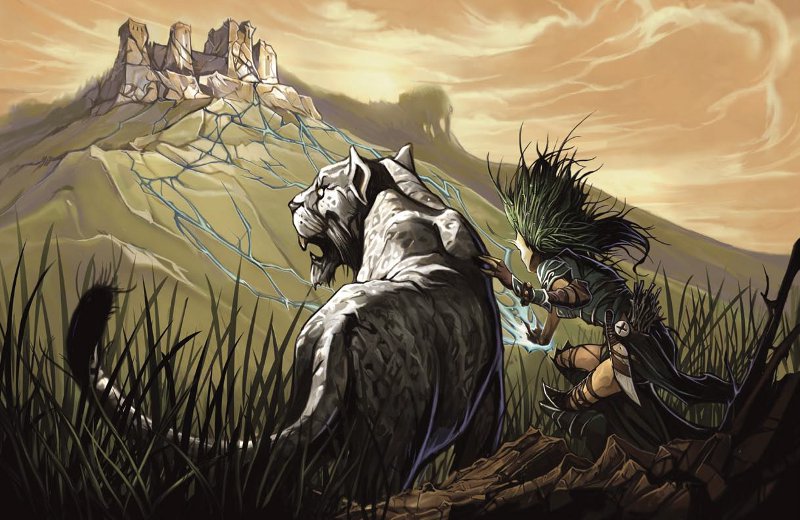
Yes, they can wreck castles single-handed.
Druid Spells
Druids mostly focus on nature crap - spells relating to animals, plants, healing, and eventually some elemental effects. They're not as flexible as clerics, but still have a pretty strong spell list.
1st Level
-
Entangled:
Makes everybody in a 40' radius save every turn or become entangled.
-
Faerie Fire:
A 1st level spell that cancels out some 2nd and 3rd level spells, because
-
Flame Blade:
Lets you create a
lightflame saber that ignores all armor and damage reduction. Why, yes, you can wield this as a bear, why not?
-
Resist Energy:
Lets you resist 10 points of energy damage, which you can select each time you cast, for 10 min/level. Upgrades later to 20 points and 30 points. Yes, you can go lava-wading at level 3, given lava does 2d6 damage per turn of exposure.
-
Contagion:
You're only 5th level and you can inflict the black plague on a community.

-
Sleet Storm:
Blocks all sight and hinders movement! No saving throw.
-
Freedom of Movement:
Immunity to grapples. Not a bonus. Immunity.
-
Reincarnate:
Brings a subject back from death in a different body. Hilarious results guaranteed.
-
Awaken:
Give an animal or plant sentience. Lasts forever. Yep, you're a creator god at 9th level.
-
Stoneskin:
Gives you Damage Reduction 10, only pierced by Adamantine.
-
Stone Tell:
Congratulations - you just waited 11 levels to chat with a rock.
-
Summon Monster VI:
On the other hand, you can summon up a stone giant with more hit dice than you have. Sounds fair to me!
-
Fire Storm:
Does 13d6-20d6 fire damage in an area.
-
Wind Walk:
Lets you fly 60 MPH intangibly as a group for at least a half-day. Basically a means to skip travel adventures entirely at high levels.
-
Animal Shapes:
Whole party is bears!
-
Repel Metal or Stone:
Aka the Fighterfucker. No saving throw, shoves anybody away with metal armor or a sword or whatever at 40' each round for a minute or more. Not even spell resistance or a
+5
sword helps.
-
Elemental Swarm:
Lets you summon 4-13 elementals! Fuck you, action economy, I never liked you anyway.
-
Shapechange:
Change shape once a round. Lasts over two hours, for some reason. So any dragon, elemental, giant, plant, animal, or humanoid, and cast spells as all of the above!
Paladin Spells
Paladins have a lot of redundancy - they basically get some protection, healing, and some buffs - but a lot of their high level spells resemble stronger versions of their low-level spells. What's more, there's redundancy with their "lay on hands" ability, so they don't have the most compelling list, but it's still got definite strengths. It's just fairly narrow.
1st Level
-
Protection From Evil:
This gives three benefits against Evil creatures - a bonus to all your saves and defense, another saving bonus and a secondary save against any eeevil mind control, and it keeps any evil summoned from making bodily contact unless you attack it first (no save, just happens). This is a first level spell, folks.

-
Virtue:
You could prepare this spell, which grants 1 temporary hit point, or cure light wounds, which heals 1d8+1 or more hit points. Not that it's a trap, or anything!
-
Delay Poison:
Only delays poison - just a stopgap measure, you say? It lasts for
hours
, providing temporary immunity to any and all poisons for the duration.
-
Shield Other:
Lets you soak half the damage from another party member and give them a small defensive buff. The best way to tank in Pathfinder: through magic.
-
Magic Circle against Evil:
Like Protection From Evil, but makes evil summoned creatures stay 10 ft. away, making it harder for them to poke you with sharp sticks.
-
Prayer:
Gives a +1 to hit for allies and a -1 to hit for enemies. Yay, nickels for everyone!

-
Holy Sword:
Gives you +5 to hit and damage, and another +2d6 damage against evil. And to think, a fighter would only have to pay 98,000+ gold for an equivalent effect.
-
Mark of Justice:
Takes 10 minutes to cast, but lets you cast a conditional curse with no saving throw.
Ranger Spells
The ranger spell list, on the other hand, is mostly just boring. It's basically the druid, only less so. Healing, animal, plant stuff, still relatively potent, but with a lot of niche spells that makes this one of the weaker spell lists.
1st Level
-
Alarm:
Lets you ward an area so you know whether or not somebody's coming in or out. No saving throw, just automatic.
-
Pass Without Trace:
Congrats, your first level spell trumps any amount of Survival skill as far as tracking goes.
-
Snare:
This lets a ranger create a snare magically. It works just like a real snare! The sort of snare a ranger should be able to work up anyway. But it's
magic
!
-
Speak With Plants:
"A normal plant’s sense of its surroundings is limited, so it won’t be able to give (or recognize) detailed descriptions of creatures or answer questions about events outside its immediate vicinity." ... normal plants have senses?
-
Darkvision:
That's right. A ranger has to wait until 10th or 11th level for magical darkvision.
-
Reduce Animal:
Like
reduce person
, which is a wizard spell, but instead of getting it at 1st Level, like wizards do for
reduce person
, instead you get a more niche version about ten levels later.
-
Commune With Nature:
Learn about the local area for about 13+ miles around you! Completely invalidate your own ranks in the Survival skill!
-
Tree Stride:
Lets you fuse with trees and teleport between them, just like the rangers of myth.
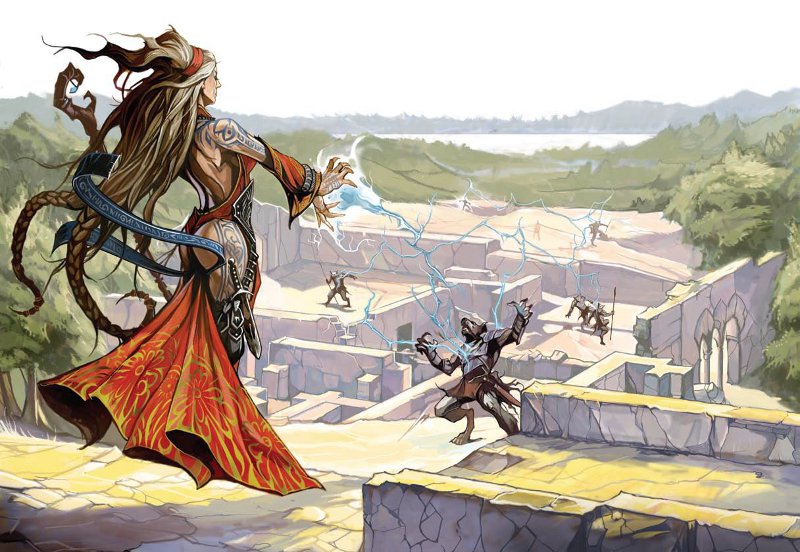
Seriously, they commissioned this art, and somebody was like 'that'll do'.
Sorcerer Spells
Time to get into some of the strongest spell lists in the game. Sorcerers and wizards use the same spell list (mostly; wizards get a few extra spells only they can cast), but I've divided them up to conquer the huge, sprawling list that they represent. What do they do? Well, just about anything except heal, since the cleric gets niche protection. Not sure why they bother, really.
That last sentence is spoken with a tired English accent. Very, very tired.
1st Level
-
Magic Missle:
Lets you fire low-damage projectiles that never miss and have no saving throw. Low-impact, but demonstrates that casters get an absolute ability at level 1.
-
Ray of Enfeeblement:
A ray that saps strength. Toned down from
Dungeons & Dragons 3.5
in that it now requires a save... for half damage.
-
Protection Against Arrows:
Once you can cast
fly
, you can now be like, ha ha, fuck you, mundanes! FUCK YOU AND YOUR LOUSY NONMAGICAL ARROWS.
-
Webs:
Creates a sticky web to entangle folks... which grapples people on a failed save and then you have to make a check to get free. If you try and move in the area with a web, you have to make a save again. If you fail again, you have to start all over again. It also completely avoids the normal grapple rules, so grapple defenses are no effect. Wizards!
-
Displacement:
Provides a 50% miss chance. Period. It's an illusion spell! The sort of defense spell abjuration would dream of.
-
Invisibility Sphere:
Make your whole party invisible! Because fuck rogues.
-
Black Tentacles:
You could be a monk or fighter specializing in grapple, spending feats and able to grapple one person at a time! Or you could just be a wizard, cast this spell, and get the effects of being a large grappler with Strength of 18 who can grapple everybody in an area.
-
Invisibility, Greater:
Like invisibility, but you can attack and cast spells and so on while invisible, because fuck... yeah, you get the idea.
-
Cloudkill:
Did I mention most save-or-die spells were nixed? Not this one! Low-level characters are killed without a save, mid-to-low die on a failed save and take Constitution damage otherwise, and higher-level characters take Constitution damage no matter one. Less on a successful save.
-
Baleful Polymorph:
Turn enemy into puppy, then kick puppy.
See Adnachiel's
Witch Girls Adventures
writeup for further discussion.
-
Chain Lightning:
Lets you do 11d6-20d6 damage to 11-20 targets. Yeah. That's a potential average of 577-1050 damage against a mob. Save for half, because spells don't have to have a miss chance. That's a burden for warriors.
-
Form of the Dragon I:
Lets you fly at 60', gives Darkvision 60', +4 to Strength and natural armor, +2 to Constitution, a 1d6 bite, two 1d6 claw attacks, two 1d4 wing attacks, a 6d8 breath weapon, and additional special abilities based on the dragon type you choose, including energy resistance 20 or 30, swim speed, or a burrow speed. And this the
weak
version, for the record.
-
Prismatic Spray:
Automatically blinds any creature with 8 HD or less for 2-8 rounds. Hits all creatures in a cone. Does randomly: 20 fire damage or 40 acid damage or 80 electricity damage or poison that does Constitution damage or turns them to stone or drives them insane or transports them to another world or might even do any two effects. Save for half on damage, or saving throw negates otherwise. Still. Complex enough,
Pathfinder
?
-
Teleport, Greater:
Lets you teleport anywhere with no range limit and no chance of error.
-
Horrid Wilting:
Lets you do 15d6-20d6 damage to everybody in a group as long as they're not 60' apart or more than 1000-1200 ft. away.
How will you ever overcome its limitations?!
-
Moment of Prescience:
Lets you gain a bonus to any attack, combat manuever, opposed ability or skill check, or saving throw equal to your caster level. It lists a maximum of +25, even though caster level only goes up to 20. Useful for suddenly being able to grapple a dragon. Or, if you're already a dragon, try grappling a tarrasque or something, I dunno.
-
Power Word Kill:
Kills any creature with 100
current
HP or less. No saving throw. Dead.
-
Weird:
Causes anybody you target - they all have to be no less than 30' apart - save or die. If they make the saving throw, they take 3d6 damage, 1d4 points of Strength damage, and are stunned for 1 round. Just cast repeatedly until out of 9th level spells or they're dead, what are they going to do about it? They're stunned!
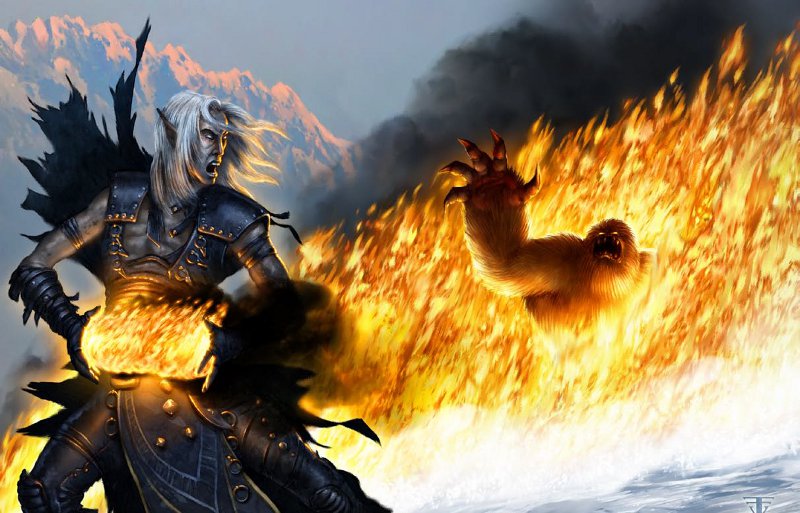
Hadoken?
Wizard Spells
Like sorcerers, only more flexible, but can't cast quite so many spells in a day. Therefore, they get extra spells that... let them cast more spells. Sounds like cheating, doesn't it? Well, cheating is what wizards is.
1st Level
-
Grease:
An example of a spell that had to be nerfed for balance reasons.
An example of a spell that had to be nerfed for balance reasons.
An example of a spell that had to be nerfed for balance reasons.
-
True Strike:
Gain +20 on your next attack roll. Yes, sorcerers and wizards can be more accurate than fighting classes.
-
Knock:
Unlocks a door. Yes, rather than spend points in Disable Device, a wizard gets to roll their caster level + 10. A rogue has to spend their ass off to get that potential. It also lets them unlock magical locks. In other words, fuck rogues.
-
Fly:
Ha ha, break early game balance by completely negating melee combat from all nonflying foes! Use with invisibility for protection from all sorts of claws, bites, and tail slaps!
-
Wind Wall:
Boy, did those lousy mundanes from
protection of arrows
get magical arrows? This'll block those by blowing them aside! Hooray!
-
Globe of Invulnerability, Lesser:
Automatically nixes any spell of 3rd level or less. A way to just totally bootstomp any wizard of lower level when you get this. (Giant boot summoning cast separately.)
-
Mnemonic Enhancer:
Lets a wizard (and wizards only) prepare additional low-level spells, or retain low-level spells you cast after this, which makes sense because wizards obviously don't have enough flexibility.
-
Permanency:
Lets you make certain lesser spells permanent on yourself or others. Forever. This used to cost XP. Now, it doesn't, and actually costs less than most magical items. Lets you imbue yourself with a number of magical effects forever, and free up those spell slots. See the magical item section for more details on how excising the XP costs enhances casters further. I'll bitch about that more there.
-
Polymorph:
Lets you turn into a dragon, plant, elemental, animal, etc. A lot toned down from what it used to be, because you get get attribute bonuses instead of just replacing your attributes. Still has ridiculous flexibility and power.
-
Mage's Lucubration:
Lets you re-memorize spells of 5th level or lower. Because wizards, once again, need more flexibility, despite being the most flexible class in the game (acrobatics aside).
-
Wall of Iron:
Lets you create a wall of... yes. In an ode to ancient rules arguments, you have to create it on a solid surface, but you can create it unanchored so you can topple it over with a DC 40 Strength check! Of course if you fail the check it has a 50% chance of falling on you, instead. Yes, somebody thought this level of detail was necessary.
-
Banishment:
Lets you banish from 26 to 40 HD of outsiders (demons, angels, etc.). They can make a Will save to resist, but have a +2 to your difficulty for each object that opposes them. Hint: carry a backpack of around 40 or so holy symbols, one for each alignment axis, spill them out, at least 10 will oppose your target, and add +20 to their save DC.

-
Statue:
Lets you turn into a statue with hardness 8 - which is to say, damage resistance with no weakness. You can do it as a free action multiple times in a turn, so you can unstatue, cast a spell, then turn back into a statue during your foe's turns. For comparison, a barbarian of the same level has a damage reduction of 3.
-
Clone:
Lets you duplicate somebody with a "backup" body their soul goes to if they die. Takes months to grow the body, but allows instant recoveries from death for your whole party!
- Trap the Soul: Lets you trap somebody's soul in a gem. One of the closes to save or die. Possibly worse, because they can't be ressurected while their soul is trapped. Also has an alternate casting where if you can get them to accept an object given to them, they get no save and instantly have their soul trapped.
-
Time Stop:
Lets you act in a time bubble that lasts 1d4+1 rounds, so you can buff yourself, summon monsters, as long as you don't hurt noone. Not much a drawback to the creative wizard. "Oh, look, how did they get surrounded by five
delayed fireballs
?"
-
Wish:
Like the
Dungeons & Dragons 3.5
spell, this lets you do just about anything, only... it doesn't cost XP, just one 25K diamond. Which, by the time you hit 17th level, is something you find in your sock drawer.
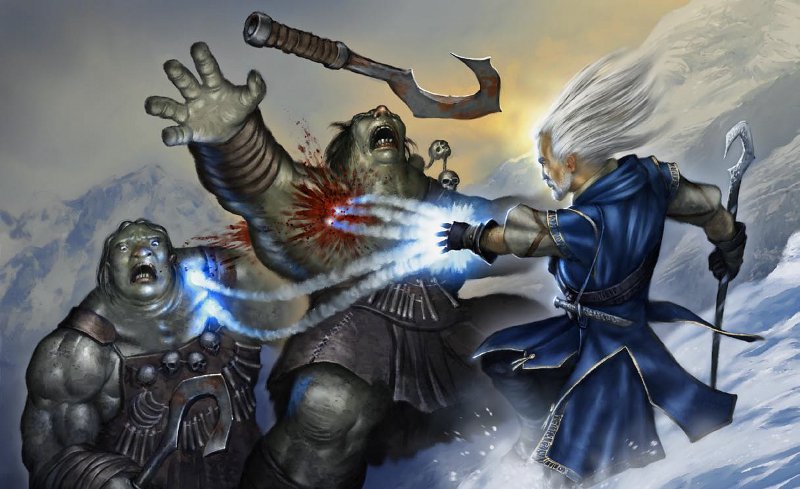
No means no.
Now, to be clear, Pathfinder does nerf some problem spells. The issue is that keyword, "some". A lot of unbalanced spells - and the overall unbalanced nature of the spell system - remains unchanged. So spellcasters take a hit, but it's not like it changes the issues spellcasting presents in the game. After all, there are still a lot of unbalanced spells to pick from. It mainly just changes the priorities of spellcasters when maximizing.
Also: note to mage armor, mage hand, mage's disjunction, mage's faithful hound, mage's lucubration, mage's magnificent mansion, mage's private sanctum, mage's sword, magic aura, magic circle, magic fang, magic jar, magic missle, magic mouth, magic stone, magic vestment, and magic weapon: cut it out. Mage, mage's, and magic are all redundant adjectives for a spell. We know spells are magic. Thank you.
Next: Prestige classes, also known as "character minimization".
Prestige Classes
Original SA post
Pathfinder Roleplaying Game Part 12: Prestige Classes
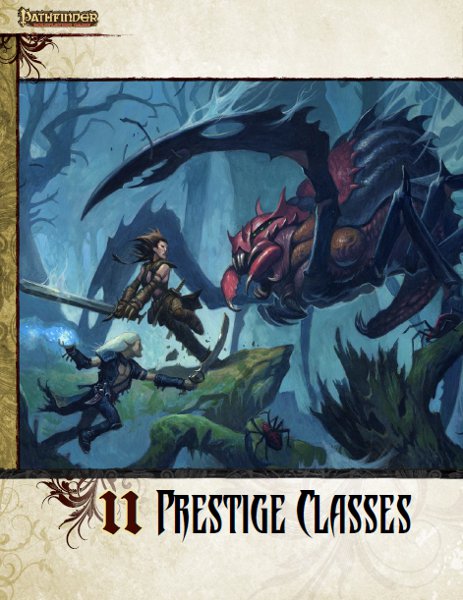
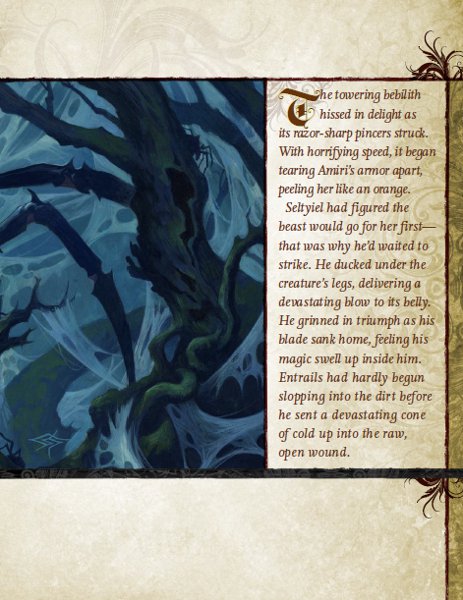
Wouldn't it be cool if you could do that move in the flavor text? Maybe some other game has rules for it.
Prestige classes, for those that have been hiding in a rubbish bin for a decade, are classes with special requirements you can generally only enter after five levels (at the very least) of a regular class. Why? Because. That is why.
Generally they have specific race, feat, bonus, or spell requirements. This means if you want one you have to decide very early, because some of the requirements are pretty complex.
Their inclusion here is particularly odd because for the most part Pathfinder doesn't add nearly as many prestige classes as Dungeons & Dragons 3.5 had. Their existence in here is generally superfluous, wasted space, that would have been much better giving the fighter some more feats, more DM advice or tools, or even *gasp* some sample monsters to make this a complete game.
Arcane Archer
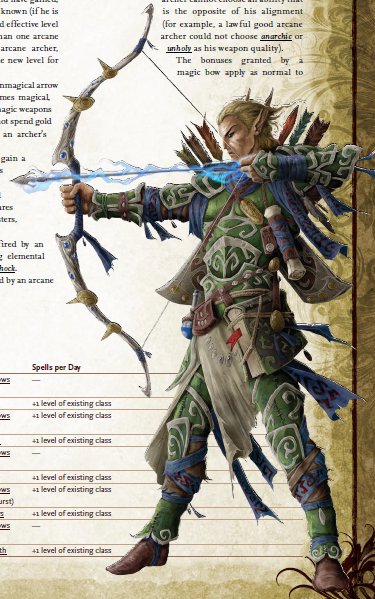
Did you know: elf ears also function as weathervanes?
Basically, this lets you be a magic archer that shoots magic arrows. Can I just say this is crap and be done with it? I suppose you want to hear why, don't you? Let's tell you why it's crap.
First, it requires you to be an elf or half-elf. It's the only prestige class in the book with a race requirement, since they ditched the dwarven defender from Dungeons & Dragons 3.5] . So it's not like there are any other races that get unique classes. Why they kept the racial requirement is puzzling; it's inane with the amount of other requirements.
Second, it requires an attack bonus of +6 and to be able to cast 1st level spells. That means you have to take a level of sorcerer or wizard (a single level of which will give no attack bonus) and then six levels of a fighting class. That means you have to be at least 7th level to enter this class.
It grants spellcasting, but it's a joke, since it makes you give up three levels of spellcasting. If you enter in the quickest way - around 6 levels of fighter and 1 level of wizard - by level 17 you'll be 8 caster levels behind any caster. If you wait through 14 levels of wizard, you can enter, but you'll lose 2 caster levels by level 20. Really not worth it, since spellcasting is better than any amount of arrow-shooting. Either way, to meet the spellcasting requirement means sacrificing attack bonus, which makes you a notably worse archer than any straightforward archer. Hell, you'll never get a fourth attack without feats.
It lets you enhance your arrows as magic items, but fuck - by the time you get the level for those arrows, you'll have the means to buy, find, or craft them anyway. So it's convenient, but redundant. And no, if you have a magic bow, it doesn't stack with this ability. The main advantage is being able to adapt to enemy weaknesses, but that's something a pure spellcaster can already do better.
It lets you put area spells on arrows and shoot them, but hell, most area spells you want to throw around already have range and don't have a miss chance. You can shoot arrows that ignore cover and concealment, which is nice but probably not that create for limited-use abilities over 10th level. About the only saving grace of the class is the ability to create arrows with a decent saving throw DC that are save-or-die arrows. But once again, spellcasters will have much better save-or-die effects at the same level (like the aforementioned mass murder of weird ). Also, the save-or-die effect is restricted to creatures of 100 hp or less.
As a wise mollusk once said, it's a trap.
Arcane Trickster
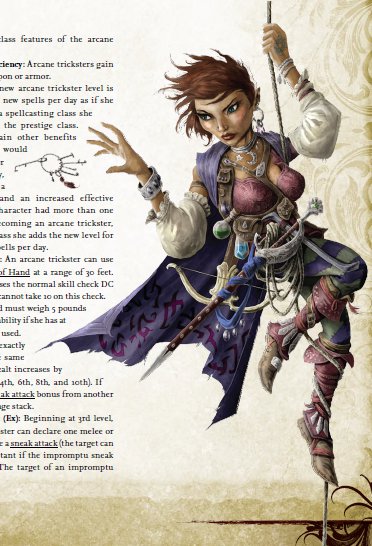
Yes, put the belt-strap right between your breasts. Just like that.
Basically a mix of spellcasting and thievery. But once again, it's a spellcasting class that makes you give up spellcasting levels. In this case, it requires you to be able to cast 2nd level arcane spells and sneak attack of +2d6. That means, for example, you'd have to be at least a 3rd level rogue and 3rd level wizard. So you can't enter it until 6th level, and any spellcaster that takes it is at least three spellcaster levels behind, which leaves them a full spell level or two behind any equivalent caster. So what do they get?
Well, it's better than the arcane archer, at least. They get to do minor telekinesis to use Disable Device or Sleight of Hand up to 30 feet. They get sneak attack damage like a rogue, the ability to declare somebody flat-footed once or twice a day (no save), cast a few spells each day without talking or waving their hands, free invisibility, and finally they get to apply their sneak attack damage when it applies with spells.
It's bad, but a creative player could have fun with this one - in addition to the spellcaster levels, both sorcerer and wizard will be losing feats and other class features. Ultimately it's a fun concept, but requires you to get hit repeatedly in the optimization gut to go with it.
Assassin
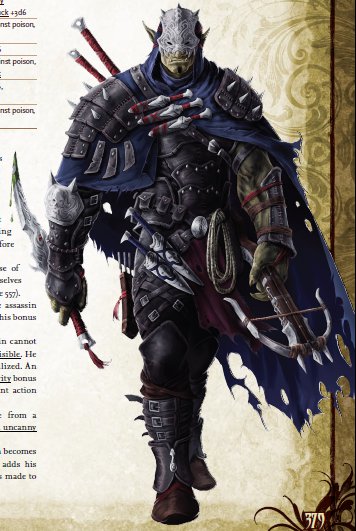
"Remember, the key to being an assassin is subtlety." [
Like it says on the tin, you murder people for $$$. It's basically like a rogue but murders people better. It has the pathetic requirements of Disguise at 2 ranks, Stealth at 3 ranks, and having to kill somebody to become an assassin (it doesn't mention if there's a guild you join, or what, so it doesn't make any sense). It also requires an evil alignment for some reason, it's not rogues, fighters, barbarians, rangers, monks, and paladins aren't all geared up and trained to murder people. It says "... the nature of their duties inevitably pushes them toward an evil alignment.", but that doesn't make any sense, because the class isn't associated with an organization or code of honor or faith that might require any duties at all.
You give up most of the skill ranks a rogue gets, and instead get some more killy abilities. You get an save-or-die attack if you charge up for 3 rounds and unleash a sneak attack against a target, though the save DC is pretty middling (and reliant on Intelligence, for some inane reason). They get to use poisons, hide weapons, make it harder for their targets to be magically raised, and some Stealth enhancements. At higher levels, they can use their death attack once a day without waiting.
Ironically, though, their attack bonus is only middling. What's more, they miss out on the tremendous bonus of rogue talents, which are generally way better than the abilities they get, and also take a hit on skills. What's more, their key ability - the death attack - is reliant on Intelligence, an ability with no direct worth in combat.
This whole class would have been a lot simpler if you just took the more worthwhile abilities and folded them into the rogue's talent array. It's just a mess on its own.
Dragon Disciple
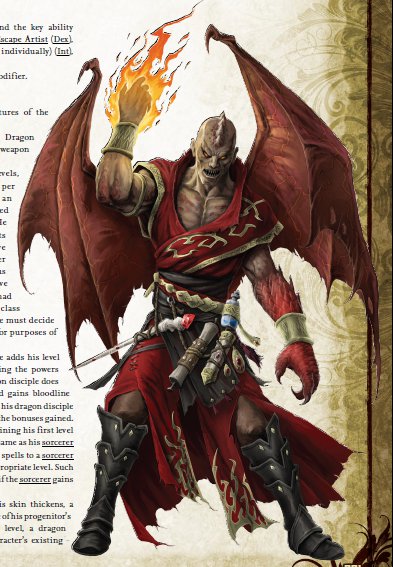
"This isn't actually magic and damn it fucking hurts!"
A prestige class for sorcerers that want to turn into real dragons when they grow up. Crap, and here's why.
They lose out on three levels of spellcasting, and instead get a bunch of bonuses to armor, Strength, Constitution, Intelligence, wings, blindsense, a breath weapon -
- but ultimately nothing that helps them with spellcasting.
You get the ability to cast form of the dragon spells... later than you normally would. Furthermore, the class never grants the most powerful one, form of the dragon iii , and in face, delays you until 20th level to get it, where normally you would get it at 17th level.
It might be useful for a spellcaster that wants a barbarian-equivalent hit die and a much greater ability to withstand damage, but generally there are much better things for a sorcerer to focus on than trying to be an amazingly shitty tank.
Duelist
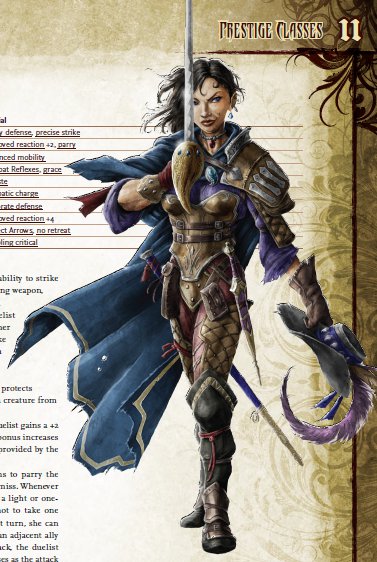
Actually pretty bad at duels.
This is for buckling swash. It requires an attack bonus of +6, so you'll need to be at least 6th level to enter it. But what do they get?
Well, enhanced damage, but only when using low-damage fencing weapons. They get enhanced defense, but can't use medium or heavy armor, or use shields. The problem here is obvious; the bonuses only really cover what they're giving up.
They get bonuses on initiative, on Reflex saving throws... they get the ability to try and parry incoming melee attacks, but only if they give up attacks to do so. Later on, they at least get the ability to opportunity attack any foe they parry, but it seems like a pretty swingy ability, since it's dependent on succeeding at two attack rolls in a row. They get some defense bonuses when avoiding certain opportunity attacks, the ability to charge over difficult terrain, and so on.
The final ability is the only really decent one, as it lets them penalize foes on a critical hit... which is something a fighter can do with critical feats, anyway - the duellist just gets more flexibility.
It's really a dog of a prestige class, and only really starts to shine at the very end. It's too back-loaded, with all the early powers mostly being apology abilities for what you have to sacrifice to take the class. The rogue makes a better swashbuckler - they get more skill points to flip around and charm people, more damage when they land a hit, and rogue talents that are even better for reducing damage. If you're looking to just deal damage and move around the battlefield, the fighter is still better for that, and the fighter is crap.
In other words, just like the prestige classes for spellcasters, players wanting to take this class will take a hit - but melee fighters are already starting from a low bar to begin with, and this class does nothing to help.
Eldritch Knight
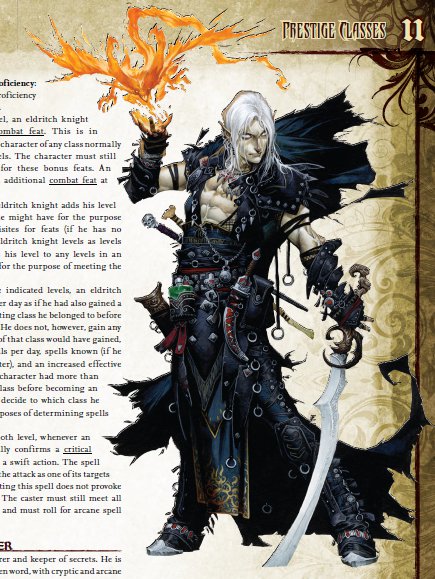
Elric's awkward teenage years.
This is a spellcaster that's practiced in fightin'. Like the arcane archer or the dragon disciple, though, the issue is one of lost spellcaster levels. The eldritch knight, thankfully, only loses two spellcaster levels - one level to having to take single level of a martial class, and is forced to lose another upon taking the first level of the class. The requirements - 3rd level spellcasting and martial weapon proficiencies - restrict this to 6th level spellcasters.
What does the eldritch knight get? A better attack bonus, a better hit die, three combat feats, and the ability to cast a bonus spell upon getting a critical hit. Oh, and armor? The eldritch knight gets no actual ability with armor. They still have to dump feat slots on that. Yeah. Unarmored frontline combatant. Good luck with that.
It's not the worst choice, but Pathfinder punishes not being specialized. An eldritch knight will never have the class abilities, attack bonus, or feats to shine in melee combat, and will lag behind other spellcasters. It's definitely a notch down for any spellcaster that takes this path, but it's not as severely punishing as most of the others we've seen.
Yes, that is damning with faint praise, for the record.
Loremaster
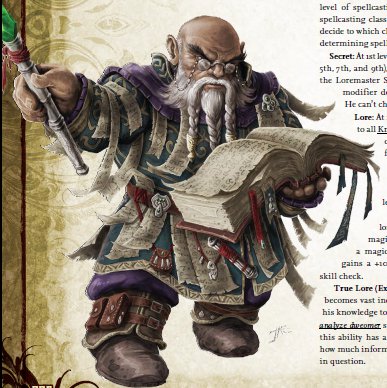
Dwarves make lousy wizards, but don't tell him that. It'll break his heart.

This is about the only truly beneficial prestige class in the book. It's largely for wizards, since it benefits spellcasting and intelligence, and requires metamagic or item creation feats (which wizards get as bonus feats), though other spellcasters can take it to lesser benefit. The skill requirements mean you have to be 7th level to enter this class, but a good wizard will wait until 8th level, get their final specialist ability, and then enter.
"Most loremasters cannot be bothered with distracting and pointless philosophies such as ethics, and so tend to be neutral, neutral good, or neutral evil." Oh. I'm not sure the author understands the word "ethics".
Loremasters get bonuses on Spellcraft, Knowledge, and bonus languages, and their apex ability is to cast legend lore (with greatly reduced casting time) or analyze dweomer] . They also get the Secrets ability, which lets them boost bonuses or get bonus feats or spells, depending on their Intelligence modifier and level. And, unlike previous spellcasting prestige classes, don't have to give up any spellcasting ability.
What do wizards give up? If they have a bonded item, nothing. It's a net gain. If they have a bonded familiar instead, they lose on on some of the familiar's modest benefits later on (increased Intelligence, natural armor, spell resistance, or the ability to scry on the familiar).
It's telling of Pathfinder's design philosophy that the arguably most powerful class - the wizard - gets the most beneficial and synergistic prestige class. There is no emoticon for a raspberry sound but I am making one as I write this, for the record.
*thbbbt*
Mystic Theurge
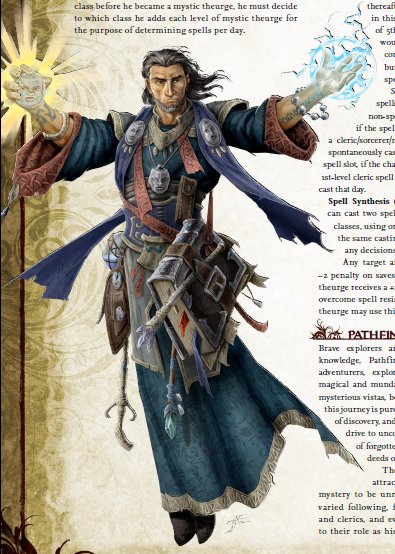
Aim for the spellbook. You can't miss it.
Want both divine and arcane spellcasting? You've come to the right place! A mystic theurge needs 2nd level arcane and divine spellcasting, meaning they have to be 6th level to enter this class.
The mystic theurge advances in the arcane and divine spellcasting paths, and gets the ability to swap their spell slots between the two. At top level, they can cast two spells - one from each casting type - and gets an additional bonus to affect the target if they're targeted with both spells.
At first blush this class looks ridiculous, but the issue is both classes advance three levels behind. So ultimately, the mystic theurge takes a hit in power level, but of any of the sacrifices we've seen - wizard/rogue (arcane trickster), sorcerer/dragon (dragon disciple), wizard/fighter (eldritch knight), this is the most worthwhile, since the mystic theurge gets increased staying power and flexibility compared to a single-class spellcaster. Ultimately I'd say they're weaker than a straight wizard or cleric, but if you're going to make the sacrifice to multiclass as a spellcaster, this is perhaps the only worthwhile sacrifice to make.
Pathfinder Chronicler
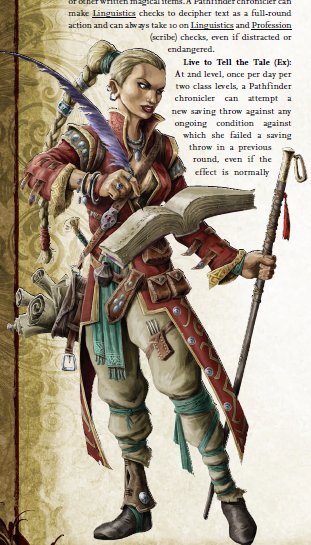
What's important in a character design is that it be overloaded with accessories.
This is the only truly new class in the book, and lets you thrill to the challenge of being a fantasy... historian. The skill ranks restrict it to 5th level or higher.
There's no clear entry point for the chronicler, but it's mildly oriented towards bards. It's the only class other than rogue to get the best skill progression. So, what do they get?
They get bardic knowledge, which stacks with the bard ability if you already. They also get bardic performance. And then this whole shit goes off the rails, trainwrecks, and kills all of its passengers stone dead when you see it gets no spellcasting ability. None. Zero. You're giving up the bard's most potent ability, so what do you get out of it?
Well, more skill ranks, but the pathfinder chronicler does have some interesting ability, at least. They get the ability to produce low-cost items out of their utility belt, effectively. They get to inscribe tales that boost the reader with their bardic performance. They can cast doom from afar or otherwise denounce targets and thusly get some social-shifting abilities. They can summon barbarian spirits to help them fight. They get language, navigation, and saving throw bonuses.
They sound kind of fun, but ultimately there's not much here worth the sacrifice. At the very least, they're different , not much being a melange or variant class, which I'll laud. But any bard that takes this has to give up the bard's biggest advantage to do so, and that's just not worth it.
Shadowdancer
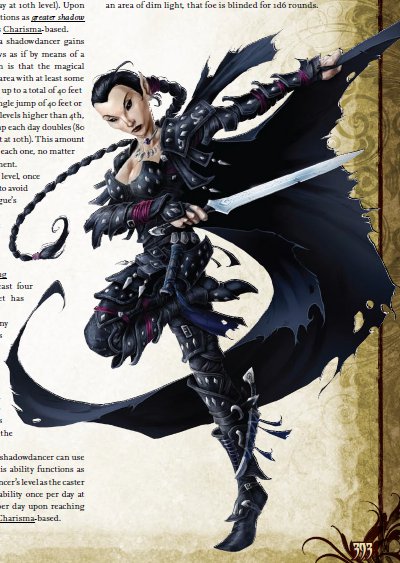
The problem is that the arm has to stay there to keep the boobs from popping out.
This is a spooky class for rogues that basically gives them power over darkness and shadows. The description mentions spellcasters taking this class, but given it provides no casting ability, those are some pretty dense spellcasters.
They get some abilities to hide, evade 'splosions, see in the dark, and dodge around. They get some rogue talents, but not as many or as good as a rogue gets. They can create minor illusions, a limited shadow teleport, minor conjuration or evocation via shadows...
Their first weirder ability is to summon a shadow to help them, though you'll need the Pathfinder Bestiary to get the stats for one - apparently they just couldn't find the room in a 576-page book to slip it in. In addition, they get tremendous defense bonuses while in darkness when they hit their apex, getting Damage Resistance 10 (no weak spot), a bonus on saving throws, and blinding folks they critically hit.
Ultimately this would be perhaps the most even of the prestige classes... if they had sneak attack. As it is, rogues get a lot worse at fighting by taking this - better at tricking, maybe, but they lose their biggest combat advantage to do it. Fighting classes that jump into this lose out on their attack bonus. It's a trap, but it's at least an interesting and flexible trap.
No More
And that's all for prestige classes! As you can see, unlike Dungeons & Dragons 3.5, Pathfinder really encourages people to stick with their base class... by beating them in the skull with the nerf bat if they dare take a prestige class. I started out saying this was wasted space, and rereading it only confirms that. Pathfinder only seems to be keeping Prestige Classes out of tradition, but clearly doesn't know what to do with them design-wise.
What's more, most of the prestige classes mainly just are aimed at giving options to spellcasters, especially arcane spellcasters. Arcane archer, arcane trickster, dragon disciple, elritch knight, and mystic theurge only reward sorcerers and wizards. Any spellcaster can enter loremaster but it's ultimately intended for wizards, as it requires Intelligence. Duelist is the only pure fighting prestige class, assassin and shadowdancer are for rogues, and bards have the pathfinder chronicler. Barbarians, druids, monks, paladins, and rangers won't find a whole lot to like here. You'd think after just going through over 160 pages of rules on magic and spells they'd throw their mundane classes a bone and give them some toys to play with, but no. Pathfinder doesn't really give them a second thought.
Next: Gamemastering, also, buy our stuff.
Gamemastering
Original SA post
Pathfinder Roleplaying Game Part 13: Gamemastering
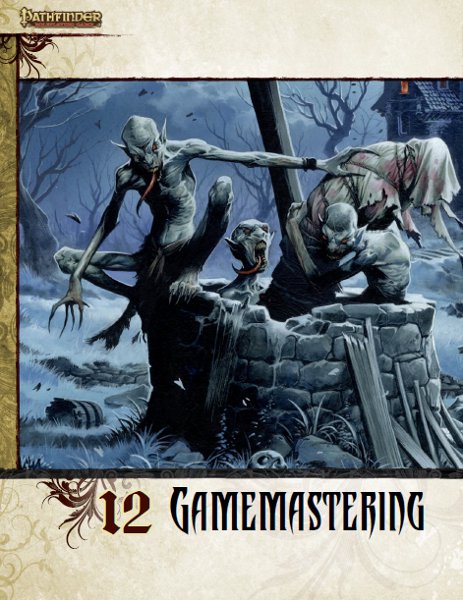
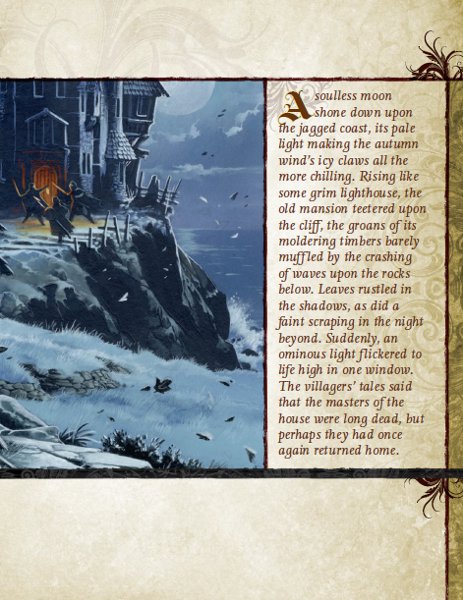
"Don't take a picture yet, my tongue isn't all the way out!"
First it starts with the roles of the game master in an attempt to define it.
-
Storyteller:
It notes the first role of the gamemaster is to be able to craft and tell the game's story. Or, it might be better said, the story of the game.
-
Entertainer:
The second is that a game master has to be able to improvise and adjust the adventure and story to the players' actions and keep them engaged.
-
Judge:
And jury and executioner. "All rule books, including this one, are his tools, but his word is the law." Well, given the state of this rulebook so far, I can see why they'd encourage a gamemaster to discard it when necessary.
-
Inventor:
The gamemaster has to be able to invent characters, plots, magic items, spells, monsters, worlds, etc.
-
Player:
It also mentions that the gamemaster isn't any less of a player than the others. Exactly what this means is seemingly left as an exercise for the reader.
Starting a Campaign
It points out that you'll have to prepare when running a game, either making a "sandbox" for PCs to explore or crafting adventures. It emphasizes note-taking and consistency, etc.
Published Adventures
Pathfinder Roleplaying Game posted:
Published adventures are your friend. As a Game Master, you’re going to be spending a lot of time as it is preparing for games—and when you don’t have time to come up with an adventure, a published adventure can be a godsend.
This is the sort of advice you get from a company that got their start in selling adventures. It points out that adventures should be adapted to your group, and that they offer a large variety of published adventures, of course, in exchange for money. It's not bad advice, but it's flavored with the sort of glowing adjectives one would expect from a salesman.
Pathfinder Roleplaying Game posted:
To learn more about these valuable GM resources, please visit paizo.com .
Yesss.
Building an Adventure
It points out you can do full write-ups for adventures, but generaly that you only need to do an outline, maps, encounters, stats, etc.
Also, that you're not writing a story, even though they said your first role is as storyteller. The point they're trying to make is that the story is defined by the players, but it's a bit confusing. Anyway, they point out three elements to include:
Stat Blocks: It points out it's best to prepare these in advance. Of course, to find out what a statblock looks like, it refers us to the Pathfinder RPG Bestiary .
Designing Encounters: This is how you go about designing conflicts to challenge the PCs. First, you determine the APL (average party level) and then the CR (challenge rating) and the the BTE (build the encounter) which determines the XPB (XP budget) for monsters, traps, and hazards. I may have made up some of those later initialisms but you get the idea. NPCs who aren't straight monsters have CR of their class -1. It notes all sorts of ways to adjust CR and really it's much ado about nothing.
As we've seen, a party made up of a wizard, paladin, cleric, and rogue will have potentially better chances to face off against challenges than a party made up of a monk, ranger, fighter, and sorcerer. What's more, good skill or feat choices could adjust that as well. Also, there's magic items to be considered - CR assumes characters will have a certain $$$ amount of magic items, but a wand of fireballs will be more useful in combat than a crystal ball , but the latter is worth more towards the PC's value of magic items.
And if you want to see how broken the CR system is in the first place, a 12th level commoner is considered CR 10, or able to face off against aforementioned wizard, cleric, paladin, and rogue at level 10. For the record, the commoner has a horrible hit die, horrible skills, bad attack and saving throws. They'll have 25 hit points, which most of those classes will be able to remove in a single attack by that point, unless they don't have at least basic optimization (like a wizard with no attack spells or a paladin with a Charisma of 10 or lower). This is considered to be the same challenge rating as a fire giant or an adult white dragon, for the record. A 20th-level commoner would be CR 18, and considered the same as a fight with a kraken or ancient blue dragon, even though they'd effectively fight like a 10th level fighter, have the hit points of a 10th level cleric, no class features, and little in the way of useful skills or combat proficiencies.
Awarding Experience: Basically you figure this bullshit CR number against the APL and then figure that on a table with the number of characters in the party and then that gives you an XP value of each encounter.
In case you're wondering, the amount of encounters for the PC to gain a level, presuming a four-person party facing challenge ratings at their level, is roughly 20 encounters to gain a level. If we kick things up to "fast" progression, that goes up to to a level about every 13 enounters. Roleplaying challenges - that is, significant skill bits and roleplaying bits where the PCs accomplish a thing - are worth one encounter of their CR. When you finish an adventure, you might get two such encounters in XP as a bonus.
That means for medium progression, getting four encounters a week, a group will take about a year to hit 10th level, and two years to hit 20th level. Clearly, Pathfinder asks for some serious dedication of your group. Of course, this is definitely how Pathfinder really hooks players - by requiring a high level of dedication and time, it encourages a long-term association with the game and the purchase of supplements, adventures, etc. Furthermore, people are more likely to associate themselves with the game when they've dedicated a lot of money, time, or brainpower to it, and will be a lot more likely to defend their choice irrationally after the fact.
I don't think it's deliberate, but it's part of the Dungeons & Dragons formula, and one Pathfinder follows lavishly.
Placing Treasure: Okay, so you're got your CR, and that lets you know how much $$$ your group gets for each encounter. In addition, there's a "player wealth by level" for assigning magic equipment to PCs after 1st level. The player wealth by level is less than the normal gain of items, and presumably is so to account for one-shot expenditures of various sorts.
It also mentions that characters starting with additional wealth shouldn't spend more than:
-
25% of their wealth on weapons.
-
25% of their wealth on armor or protective devices.
-
25% on other magic items
-
15% on disposable magic items
-
10% on mundane equipment
Fuck you, these are the rules.
It also mentions that humanoid enemies generally give more magic items because they get magic gear depending on your level. It suggests you then have the PCs fight some monsters with little or no treasure.
In short, it's a horrible balancing act the GM has to maintain, keeping treasure and XP at equal pace, lest the game break. If only there were some system that tied XP and treasure together...
Building a Treasure Hoard: What's more, the GM is supposed to make sure the treasure hoard is flavorful and include coins, gems, artwork, jewelry, and gear because apparently it's super-important if you got a ruby or an amethyst.
The GM can place items deliberately or just say screw all this careful balance and roll randomly for items! When you roll randomly for items you just use an average value of the magic item category (minor, medium, or major) for the cost of the item. So you could alot a slot for a major item (40,000 gold) and end up with an item over 200,000 gold! Or one that's under 20,000 gold!
Why do they stress item balance and then do a stuka right into unbalanced territory again? Because random treasure was a major part of Dungeons & Dragons , of course! And by using averaged costs, Pathfinder takes the time to make it even worse.
Preparing for the Game
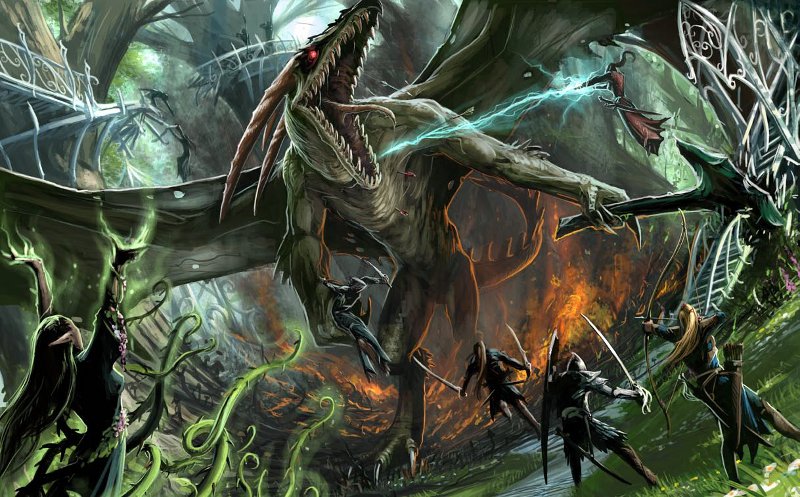
That dragon's got an axe!
They have a number of suggestions for for things to prepare - read up on or design an adventure, come up with props or handouts, cleaning up, help folks with rules questions, etc.
There's a pretty solid summation of the everyday issues with running a game, dealing with absentee players (though no real suggestions on such). Anyway, it's better than most GMing advice sections, even though it's brief.
Pathfinder Roleplaying Game posted:
Try to use common sense here—while it’s tempting to load up with potato chips and soda pop, gaming is no excuse for poor health!
paizo sez we know you are fatties but please stop luv paizo
During the Game
Now, they discuss common issues and techniques.
-
Cheating and Fudging:
They suggest a GM can muck with dice rolls, plot, rules, etc., in order to basically make sure the players don't have an unfun end like having all their characters die early. They suggest you call mucking with dice or stats "fudging" because the GM can break the rules as a part of the game. It's allowed.
-
Divine Intervention:
It mentions you can use deus ex machina to get games back on track. It also suggests you can provide a limited amount of interventions for the whole campaign for the PCs to save their bacon with.
-
GM Fiat:
The GM gets to make the rules and sometimes just has to make quick decisions and come up with a full ruling later. I can't see why you'd need to do thi- oh, right.
Pathfinder
.
-
Managing PC Death:
This mentions that player characters might die, and suggests that the gamemaster let the characters get to the business of restoring the PC to life as soon as possible, or letting the player create a new character. It also mentions the dilemma of having to deal with the old character's magic gear and any new gear, and that the new character may get the old character's gear in wealth by hook or by crook. It would be a lot better if wealth and geegaws weren't so vital to the game's balance, but that's not how Pathfinder rolls.
-
Rolling Dice:
It points out you can hide your rolls or not, however you want to do it, but that some rolls, like rolls to notice secret stuff or saves against secret threats.
-
Troublesome Players:
It points out you should talk with players that cause issues, and if things get really serious, cancel the game to let folks cool off before neck time, etc. Basic adult stuff.
It mentions the presumption of Pathfinder is campaign play, keeping the same characters between adventures and leveling them up until you
Of course, it mentions how daunting and heavy world-building can get, and suggests you start with Earth analogs - but there's help in the Pathfinder Gamemastery Guide ! Gamemastery?
Man, a book to buy if you don't want to make a world, and a book to buy if you do want to make a world. There's no escape!
Cost of Living
It mentions that adventures have to pay for normal stuff! Not sure why this wasn't under equipment or something, since it seems an important thing to track for the money-conscious adventurer. Anyway, it ranges from 3 gold pieces a month (so poor you can't pay attention) to 1,000 gold pieces a month (fabulously wealthy!).
Monstrous Characters
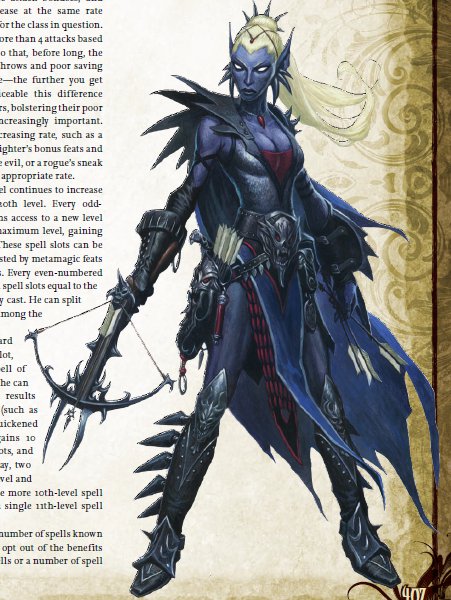
"Protection? No, this is my party armor."
It notes that you can add or remove races from play, and that you can add monster races as well. It says that if you allow a more powerful race, that normal PCs should be able to start a level higher or start at a level equal to the hit dice of the monster being play. Yes, this is terrible balancing as usual, and I can't be bothered to prove it. If I do the Pathfinder Bestiary , I'll look further into it then.
Anyway, it's not like this book has rules for any of these damn races, so it's a waste of space.
Ending the Campaign
The main part of this isn't really about ending the campaign, it's about discussing with your players what level they stop leveling at. That's all it's really concerned with. It also mentions that it requires careful timing to stop a game exactly at 20th level, and not fall over to 21st, as if a gamemaster can't actually stop XP gain. XP is a force of nature , bitches.
It mentions you can exceed 20th level, and that other compatible products have been produced which provide rules for it. By "other products" they mean the Epic Level Handbook for Dungeons & Dragons 3rd edition , and by "compatible" they mean "require a complete rewriting of most of the book". There's This has been your Pathfinder Weasel Cant to American English translation to enhance clarity and diffuse confusion.
Well, okay, Little Red Goblin Games has published a guide to "Legendary" levels, which allows you to swell your numbers and power levels. I really wanted to mock it, but it's not really any worse than Pathfinder's core rules, to its credit.
And finally, reluctantly, Pathfinder just gives up and adds rules for characters over 20th level.
Pathfinder Roleplaying Game posted:
Note that these guidelines aren’t robust enough to keep the game vibrant and interesting on their own for much longer past 20th level, but they should do in a pinch for a campaign that needs, say, 22 or 23 experience levels to wrap up.
Uh-oh. When even Pathfinder admits a set of rules is a horrible kludge, you know you're in for a treat.
-
Experience Points:
Every level beyond 20th requires you to double experience point gain. But we don't know how much experience these characters need to gain a level, so it's not terribly useful information.
-
Scaling Powers:
Hit dice, attack bonuses, and saving throws progress by the same formulae, but they presume you know the formulae those bonuses work by. (It's not hard to work out, but they don't provide any clues.) Furthermore, class abilities that have a set, increasing rate like bonus feats for a fighter or sneak attackers for a sneaker continue on as usual. However, characters can never get more than four attacks, because fuuuuuuuck fighters! To their credit, they do acknowlege bad saving throw progressions will result in rock paper scissors issues, where effects that target a bad save will just win... but do their discredit, they do nothing to fix the math.
-
Spells:
Oh, but spellcasting. That increases like usual. You even get higher level spell slots that can be used to prepare metamagic spells. Hey, it's another set of rules spellcaster dominate, whowouldathunkit?
-
Multiclassing:
Oh, yeah, you can just multiclass or pick up a prestige class or whatever.
Next: Time to detail environments! Or: all the rules you need for awesome sewer adventures. Radical!*
* it is not actually radical
Environments
Original SA post
Pathfinder Roleplaying Game Part 14: Environments
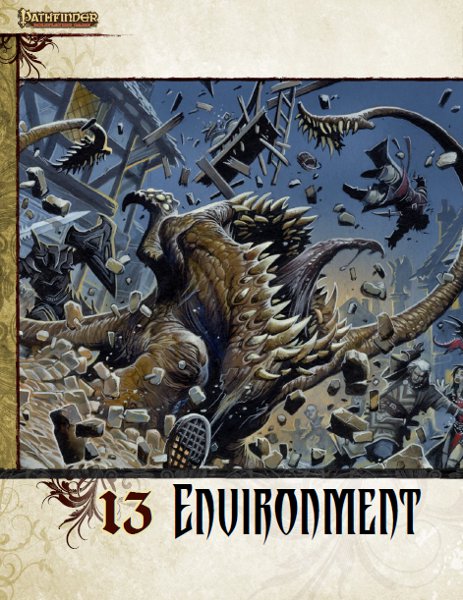
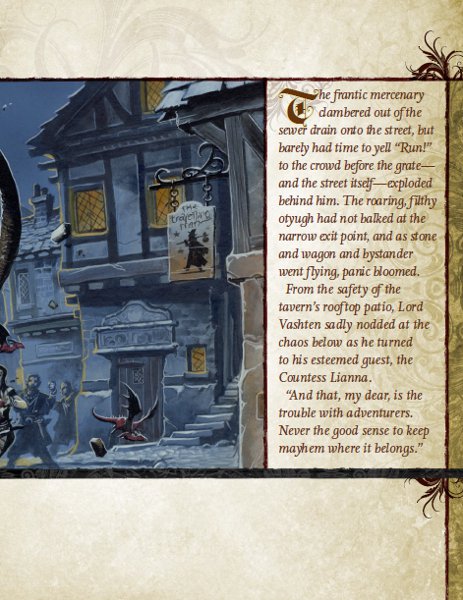
I bet you thought I was joking about sewer adventures! I was not.
Welcome to Sewerfinder! Roll for pipe circumference.
It doesn't waste time getting to the point of things:
Dungeons
There are four basic dungeon types:
-
Ruined Structure:
A place abandoned by its creators.
-
Occupied Structure:
This is still occupied by monsters. It might be a community or a mine or whatever.
-
Safe Storage:
This is a burial site, a vault, or whatever.
-
Natural Caverns:
These are caves, folks.
-
Stanky Sewers:
This is where the poop goes.
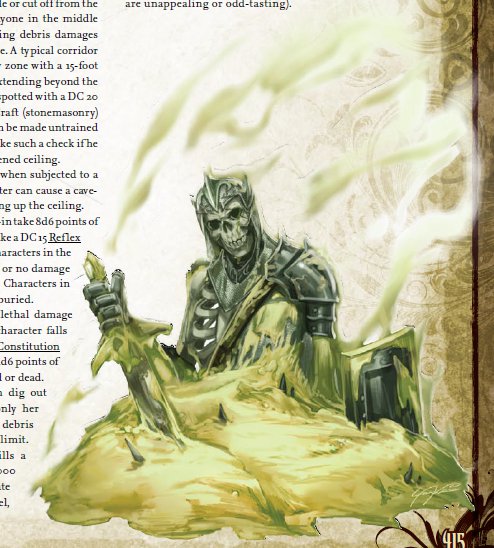
"Sorry this dungeon's a mess, but another party showed up and you know how it is-"
Anyway, it gets into dungeon terrain. First: walls! It gives durability and hit points for each kind of wall, for adventurers that say "fuck it", and just go through those mazelike structures with a pickaxe.
waallllls
-
Masonry walls:
= mortar + rocks.
-
Superior Masonry Walls:
mortar + rocks + stucco.
-
Reinforced Masonry Walls:
mortar + rocks + iron bars
-
Hewn Stone Walls:
Tunneled out of solid rock.
-
Unworked Stone Walls:
Aka cave walls.
-
Iron Walls:
Ferrous.
-
Paper Walls:
Screens to block line of sight! They have a break DC of 1. And 1 hp. Just FYI.
-
Wooden Walls:
The trees are crying.
-
Magically Treated Walls:
Walls that are made better with Craft Wondrous Item, as if that feat didn't do enough shit.
-
Walls with Arrow Slits:
These are like walls but with slits for people to shoot arrows at you through. Wait, maybe I have that backwards.
Geez, walls. What could be more exciting? How about floors?
floooooors
-
Flagstone:
It's like masonry walls, only it's a floor.
-
Uneven Flagstone:
These are like the above, only they're so crummy they require an Acrobatics check to run across.
-
Hewn Stone Floors:
Gravel floors! Acrobatics check for these too.
-
Light Rubble:
Makes Acrobatics harder.
-
Heavy Rubble:
Makes Acrobatics and Stealth harder!
-
Smooth Stone Floors:
Swanky.
-
Natural Stone Floors:
Like in caves. Makes Acrobatics harder, and you can't run in these, because
-
Slippery:
Makes Acro- yes it is wet we get that.
-
Grate:
Like over a pit or lower floor. Takes a DC 27 Strength check to open. Then to open it with a roll of 10 only takes... Strength 42! I'm sure tons of PCs have that.
-
Ledge:
Uhm, yeah. Sometimes they have railings! If they're really narrow it takes Acrobattery checks to move along them.
-
Transparent Floors:
Like magic glass or whatever.
-
Sliding Floors:
A trap door, or something?
-
Trap Floors:
You make these like traps. Thanks for the tip, Pathfinder.
doooooors
-
Wooden Doors:
Sometimes they have iron reinforcement! Sometimes they don't! You can choose either: it's a world of possibilities!
-
Stone:
It's like a wooden door! But stone!
-
Iron:
The toughest form of nonmagical door! How are you gonna get through this door? It's iron!
-
Breaking Doors:
There's rules for hacking at or busting down doors! It's really hard to do with a weapon, but easier if you just try and shove it. Yep, the warhammer or axe just makes it harder.
-
Locks:
Often there's locks! Bar locks! Combination locks! So many locks! :byo:
-
Stuck Doors:
Sometimes doors get stuck! Assumed that 10% of wooden doors are stuck and 5% of non-wooden doors are not stuck. I wonder how I get out of my home sometimes with statistics like that...
-
Hinges:
Oh, you think hinges are simple, do you? There are standard hinges, and then nested hinges - nested ones swing either way! And pivots! What are you doing to do about a pivot door, rookie? Huh?
-
Secret Doors:
They're in disguise.
-
Magic Doors:
It might be a talking door, or a tougher door, a magic portal, or password protected.
-
Portcullises:
These are bars from the ceiling! Strength DC 25 to lift. Hope you've got somebody with Strength 40...
moooolds
-
Brown Mold:
This is heat-sucking mold! It sucks heat.
-
Green Mold:
This is green slime that does 1d6 Constitution damage per round. It can kill you in three rounds, and it's Challenge Rating? 4. Have fun, explorers! It also will eat up your metal armor.
-
Phosphorescent Fungus:
"Phosphorescent" is a fancy
college
word for "glows".
-
Shriek:
It makes noise when you get close. A sort of shrieking, as I understand it.
-
Yellow Mold:
This does 1d3 Constitution damage for 5 rounds or until you make a successful save against it. It might kill you, but it'll take longer than green slime, and isn't likely to. It's Challenge Rating 6. I'm not sure they understand how this "challenge rating" system of theirs functions, where things that are
more dangerous get a higher rating
.
Traps
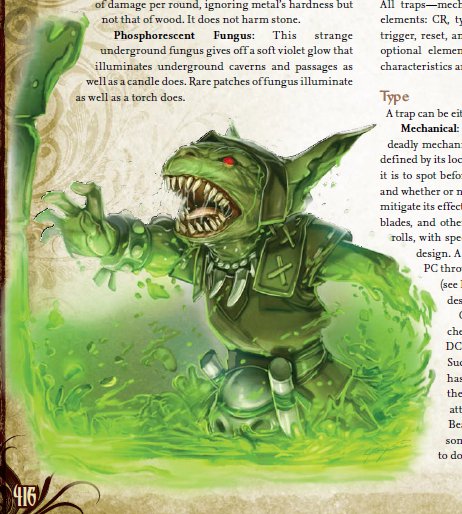
And then there was the dungeon with so many traps it killed all the monsters. Ooops.
Because in fantasy Vietnam the tunnel rat gets it worst of all.
Anyway, traps have a Challenge Rating just like monsters and molds, they have DCs to notice them, disable them, what triggers them, what causes them to reset, how long they last, and what terrible thing they do. And there are two types
-
Mechanical:
It's all Rube Goldberg up in this shit.
-
Magic:
This is some Wizarding bullcrap. There are two types, one inflicts a spell effect, the other has a more general magical effect, and is made with... Craft Wondrous Item. These are also generally harder to notice and disarm, because magic > mechanical.
-
Location:
When you're here, you're fucked.
-
Proximity:
This activates the trap when you get near. This can be a physical or magical sensor.
-
Sound:
These traps activate when they hear a sound.
-
Visual:
These activate when they see something; usually magic is used for these triggers.
-
Touch:
This triggers when the trap is touched.
-
Timed:
Periodically, the trap goes off.
-
Spell:
spehsul magik sheet
-
No Reset:
One-shot traps like bombs.
-
Repair:
Requires somebody to fix the trap after each use.
-
Manual:
Requires a reset after each trigger.
-
Automatic:
The trap resets itself.
-
Lock:
Requires a key!
-
Hidden Switch:
A switch that is hidden.
-
Hidden Lock:
It's both hidden and locked?! Dastardly.

-
Pits:
You fall into these! They sometimes have covers! Or don't have covers! Or spikes! Or don't have spikes! Sometimes there's a trap at the bottom of the pit,
traps on traps
. Or a monster in the pit! Or a trap and a
monster and a trap
, oh shit
mind blown-
-
Ranged Attack Traps:
These shoot shit.
-
Melee Attack Traps:
These are things like blades from walls and stuff that drops on your head.
-
Spell Traps:
These spell at you.
-
Magic Device Traps:
These do magic things.
-
Special:
Like a trap that covers you in maple syrup to attract monkeyants*.
-
Alchemical Item:
This uses alchemical items as part of its effect.
-
Gas:
Fart trap. Usually can't be dodged.
-
Liquid:
Bath trap. Usually can't be dodged.
-
Never Miss:
Basically assumes the whole room is affected. Always has an onset delay, which I guess means
Pathfinder
trap designers have a sense of drama.
-
Onset Delay:
The amount of time between when the trap is sprung and does damage.
-
Poison:
The trap has a poison innit.
-
Pit Spikes:
Spikes in a pit.
-
Pit Bottom:
If there's a trap at the bottom of a pit, you just build that trap as a trap. Traptastic!
-
Touch Attack:
Some traps are touch attacks. It doesn't say which or why.
Sample Traps
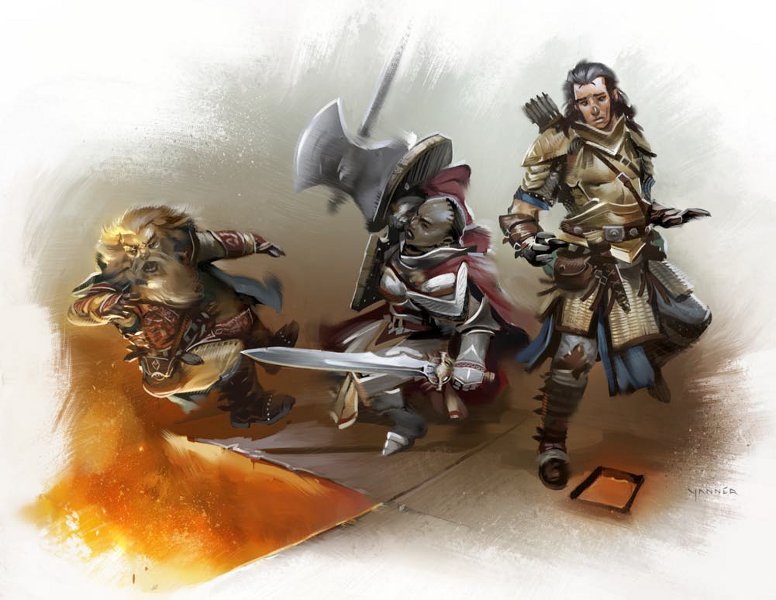
Silly warriors, always getting into trouble!
Yeah, we ain't done yet. Highlights through the wonder of bullet points!
-
Electricity Arc Trap (CR 4):
It's mechanical, because apparently Pathfinder has discovered electricity, but only use it for traps.
-
Frost Fangs Trap (CR 7):
Shoots jets of freezing water, oh god its the shower without the heat, noooo-
-
Insanity Mist Trap (CR 8):
It's a mechanical trap that fires "insanity mist", by which I think they mean gaseous LSD.
-
Empowered Disintegrate Trap (CR 16):
Does 45d6 damage on a failed save, or "7.5"d6 on a successfull save. Whee!
Designing Traps
Noooo fuck nooooo stop it stop it.

Anyway traps can be built by PCs, you put the elements listed above together that gives you a Challenge Rating, which determines the Difficulty Class of the Craft roll to make a goddamn trap. If you're making a magic trap you have to have somebody with Craft Wondrous Item and the ability to cast the necessary component spells. The cost of the trap ends up being 1,000 gp x the CR of the trap, or 250gp x the CR for very simple traps.
Yes, this means a punji pit costs 750 gp. No, I have no goddamn idea why. Get some sticks, dig a hole - how hard is that? So that's:
-
4 gp for a pair of shovels.
-
20 gp for a set of twenty shortspears.
-
0 gp for dung to poison the spears with (have the workers make some).
-
726 gp for labor.
-
Total Cost: 750 gp
There are magic traps and those require a spellcaster and Craft Wondrous Whatever and spell components in addition. There's a lot of charts but I'm just done with traps, time for a new section.
Wilderness
It's time for bold adventure actually no ha ha it's time for Blair Witch.
Getting Lost
Yes, there are rules for... wait, which section of the book was I on? There are rules for getting lost. Thankfully, you don't have to roll to follow a road or river or whatever. Otherwise... there's visibility and terrain which can affect the Survival check, and if you get lost, you have to check again to realize you're lost, and another to get back on track.
Forest Terrain
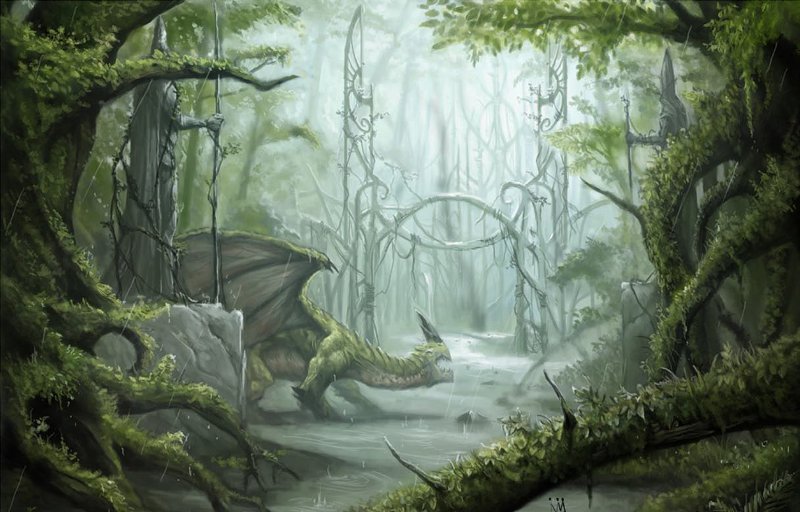
It turns out all the trees are actually druids and rangers.
There's a fucking table to randomly determine what terrain features are in every square of a map, dragged in from Dungeons & Dragons 3.5. Has anybody ever used this? Hands up if you have, Pathfinder and Dungeons & Dragons 3.5 players. Be honest.
Anyway, trees can provide cover and are honestly tougher than most monsters (but are a lot easier to hit). There's undergrowth that messes with movement and skill checks. There's some short rules in case you meet elves that live in treehouses. There's details on how fallen logs and streams mess with movement.
There's rules for stealth and detection, see, the sneaking person gets their DC raised by 2 because undergrowth is noisy, but the watcher gets their DC raised by 1 per 10 feet instead of 1 per 20 feet because animals are makin' noise, and have a lower maximum distance at which they can detect people (3d6x10 for sparse forest, 2d6x10 for medium, 1d6x10 for dense). Couldn't you just use one modifier... no...?
Forest Fires (CR 6)
Yeah, we have rules for forest fires, you have to roll to spot them at +16, because, you know, it's assumed the characters are blind as bats. Anyway, fires move at 120' a round and do heat damage (roll Fortitude to avoid taking fire damage), smoke damage (roll Fortitude to avoid taking nonlethal damage), and catching on fire (rules not included in this section).
Marsh Terrain
Yes, they have tables for determining what sort of terrain you're in. Are you in a ditch? Roll to find out?
Anywhat, there's bogs, which come in shallow and deep, undergrowth which messes with movement, hedgerows which work as small walls, and quicksand to sink in. Quicksand is DC 8 to notice, which is important to know in case your characters are basically blind. There's swim checks to get out, Strength checks to assist, etc. Oh, and hedgerows are back! Fucking hedgerows. They work like walls. Obviously hedgerows were more important to include in this book than rules for dragons. After all, first you face the threat of the hedgerows. Then the dragons.
* Rules for monkeyants not actually included in the Pathfinder Roleplaying Game .
Hills Terrain
Yes, Pathfinder . Tell me about some fucking hills. How do I know if I'm going up or down? How do I know? Is it a Survival check-
So they start out once again with a means of randomly determining what a hex contains. You know, in case you use those optional miniatures rules they keep assuming you're using, because, you know. Optional.
There are gradual slopes, that give a bonus to hit for the higher person, steep slopes, that make it harder to backflip. There are cliffs, which are "1d4 x 10 feet tall, although the needs of your map might mandate a taller cliff". There's undergrowth like before, some details for hiding...
Oh, yes, and "If you add a stream or streambed, remember that water always flows downhill."
If this game had a face I would punch it.

Mountain Terrain
Anyway, we have three types of mountain terrain: alpine meadows, rugged mountains, and forbidding mountains. And yes, there is a chart for what terrain goes where. Also, apparently rock walls are important because you place them between squares, not in them!
There are slopes and cliffs and undergrouth, like in hills, but the cliffs are 2d6 x 10 feet high. There are chasms to fall in to, and scree, which is gravel that can make things slippery. Rubble makes it hard to move and do cartwheels. Rock walls require DC 25 checks to ascend, so if you want to start as a rock climber at 1st level, hahaha, you'll break your neck. There are caves, some of which are monster lairs. There's also streams and ice and stuff.
Avalanches (CR 7)
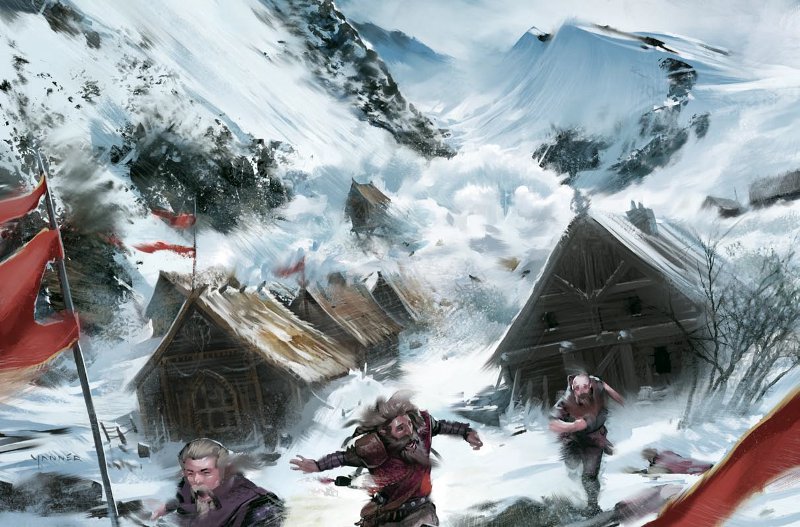
Running in the correct direction.
It is so fucking weird that natural disasters have a challenge rating. I guess this means if you have a little villa of Level 9 peasants, they can take on an avalanche, even though they don't have the skills or abilities to do so. But Pathfinder doesn't care! Anyway, spotting an avalanche from 1d10 x 500 feet requires a DC 20 Perception check. Wait, it's a random distance? You could have a +20 Notice, and not notice it before somebody with +4 Notice, just if your random roll was past because
But at half that distance you automatically notice it. There's Reflex saves to avoid taking damage, and getting buried and start suffocating. Yes, this means it's possible for a rogue to flip out of the way of an avalanche.
Mountain Travel
Uh, now we discuss high-altitude breathing... what? What...? What...? How does this Extreme Survival shit really enhance the game?

As you get higher, you start needing to make Fortitude checks to avoid fatigue. But if you live in a high place for awhile you can get acclimated. Also, zombies don't have to worry about altitude, which is good to know.
Of course, it should be noted these height ratings are totally just based on Earth's atmosphere and all that. So. If you're running on some sort of fantasy world where this is different, it might be different! Er, I'm noting this, not Pathfinder .
Desert Terrain
This where sand grows. Also they include tundra
as a desert. Tundrea have ice sheets, rubble, and undergrowth. Rocky deserts have rubble, undergrowth, and more rubble! And sandy deserts have rubble, dunes, undergrowth, and rubble again.
There's tables, see.
Dunes count as slopes. Strangely there are no rules for slipping down a dune. Also you can see very far in the desert.
Sandstorms
Sandstorms do nonlethal damage, reduces visibility and Perception checks. Also you get sand in your bum-crack, moving along.
Plains Terrain
What. What the fuck are you going to say about plains. Seriously.
Apparently there are three terrain types here - farm, grassland, and battlefield. That's right.
There are trenches and rubble and berms on battlefields! Farms have fences! There's rules and you don't care!
Aquatic Terrain
It notes that aquatic terrain is kept simple because most PCs can't breathe in water. Have you met my friend, the wizard? He can breath in water. He can do anything!
Anyway, there's flowing water in rivers, which requires Swim rolls to keep from being swept away. There's lakes and oceans, which just require swim checks, because apparently we have high-altitude rolls but no undertow.
Also invisibility doesn't work in water very well, you look like a dorky bubble.
Underwater Combat
You can't throw weapons underwater, so forget fish people throwing tridents. You can use a bow or sling, though, at severe penalities.
If you're trying to attack from land into the water, waterborne foes get serious cover bonuses, but magical effects that don't require attack rolls (and aren't fire spells) get to work normally, because

Oh, wait, fire effects can work if you make a good enough caster level check, it's just a steamball instead of a fireball that does the same damage. Also, you have to make Concentration checks to cast spells underwater if you can't breathe. There are spells to fix that, of course.
Floods
There are floods sometimes! Flooding rivers are harder to swim in. That's all!
Urban Adventures
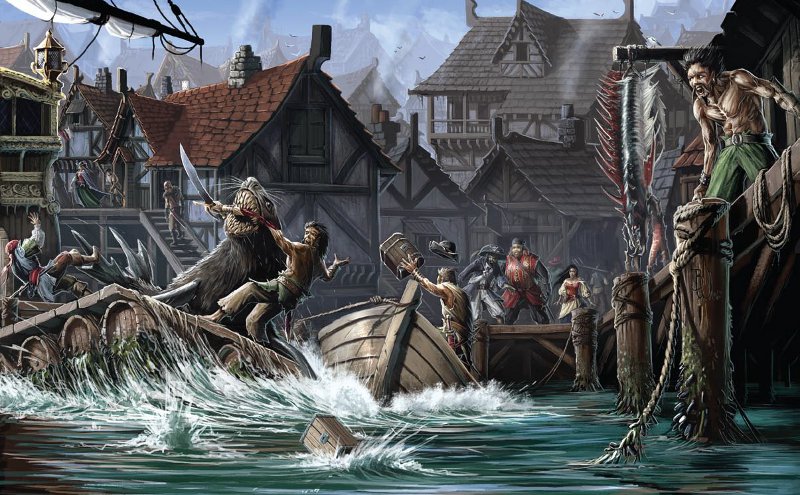
This scene could happen if you have custom rules for hit locations.
Pathfinder Adventure RPG posted:
At first glance, a city is much like a dungeon, made up of walls, doors, rooms, and corridors. Adventures that
take place in cities have two salient differences from their dungeon counterparts, however. Characters have greater access to resources, and they must contend with law enforcement.
Uh, also, you're usually not trying to kill everything and take its stuff, I hope...!
You can trade money for goods and services in a city, and there are laws and stuff, and guards who enforce those laws, and sometimes they won't even let you carry your +4 sword of baby kebabbing around, WTF.
Most of the terrain features are like a dungeons, except for some exciting new terrain features, like walls! And watchtowers! And gates! There are rules for climbing or breaking them.
There's guards and soldiers, but most are just 1st level warriors, which means an angry puppy could murder one if he's unlucky. Officers are higher level and are warriors or fighters and sometimes even have a real class like cleric. It also details their shifts and assignments and ugh.
Siege Engines
Anyway, they have rules for disabling or breaking these first, but you can buy armor for them or enchant them too. Anwyay, there are the following:
-
Catapult, Heavy:
The hit roll for this is made with Intelligence, not Strength, and just aimed at a particular square, and then there's a Reflex roll for half damage, there's scatter rules, Profession and Strength checks to reload, etc.
-
Catapult, Light:
Less damage, easier to reload.
-
Ballista:
A huge heavy crossbow that's hard to aim, despite the fact that it's fixed in place.
-
Ram:
For battering. You take a proficiency penalty to attack with this if you don't have a profiency with this weapon, but the proficiency doesn't exist. It can add in Strength from multiple characters to add up for damage.
-
Siege Tower:
Provides cover for attackers, etc. Lets you climb walls and moves real slow under a crew. It notes that siege towers cannot run, for the record.
Urban Adventures, Cont.
Badly maintained streets are treated as rubble, making Acrobatic checks more difficult. Roads are 25' wide for wagons, with 5' sidewalks. Details, folks! So many details! Crowds can provide cover, or you can use social skills to manipulate them.
There are rooftops, which require Acrobatics checks to move across, and sewers, which are like moist, wet dungeons. Also sewer adventures are better than dungeon adventures, it doesn't say so but it's implicit. There are rules for climbing and breaking buildings. And there are details on city lights, but some people hire lantern-bearers. Also dark alleys give bonuses on Stealth checks.
Pathfinder : we cover things you know, and add Acrobatics checks to damn near everything. At this point I'm not sure how people without at least a +5 in Acrobatics aren't like falling over whenever they make a journey of a hundred feet or more.
Weather
Time for a random weather table! It has calm, cold, cold snap, downpour, heat wave, hot, moderate, powerful storm, precipitation, storm, warm, and windy. But what does it all mean? Where are the numbers
Well, Rain, Snow, Sleet, and Hail are thusly detailed:
-
Rain:
A penalty on Perception checks, ranged attacks, and has a chance of putting fire out.
-
Snow:
Works like rain, and snow counts as hindering terrain.
-
Heavy Snow:
This super-slows you down, causes snowdrifts, and otherwise works like snow.
-
Hail:
This is like snow, but very rarely will be big enough to do lethal damage.
-
Storms:
These give severe penalties to Perception checks, make ranged weapon attacks impossible (magic still works, natch), and puts out mundane fires.
-
Duststorm (CR 3):
Like a storm, but there are sometimes greater duststorms do nonlethal damage, amd cause you to drown if your face is unprotected.
-
Snowstorm:
Like regular storms, but with slowin' snow.
-
Thunderstorm:
Adds lightning, but no rules to see what lightning hits. Also 1 in 10 thunderstorms adds a tornado to the mix. 1 in 10?! 1 in 10.
-
Powerful Storms:
You can't make Perception checks at all in these, and have to make Fortitude checks to keep from being blown around depending on your size. Ha ha, look at that halfling fly off!
-
Windstorm:
No rain, just wind.
-
Blizzard:
These deal heavy snow, storm winds, and cold damage of some sort that isn't detailed yet.
-
Hurricanes:
Causes heavy rain, floods, and can blow humans around. Which is a Fortitude save, yes, you can have a Strength of 7 and as long as you're
healthy
, you can withstand high winds.
-
Tornadoes (CR10):
Anything smaller than a giant has to make a Fortitude check or get bloooown away and take damage.
-
Fog:
Reduces sight distance to 5', and gives concealment to even things you an see.
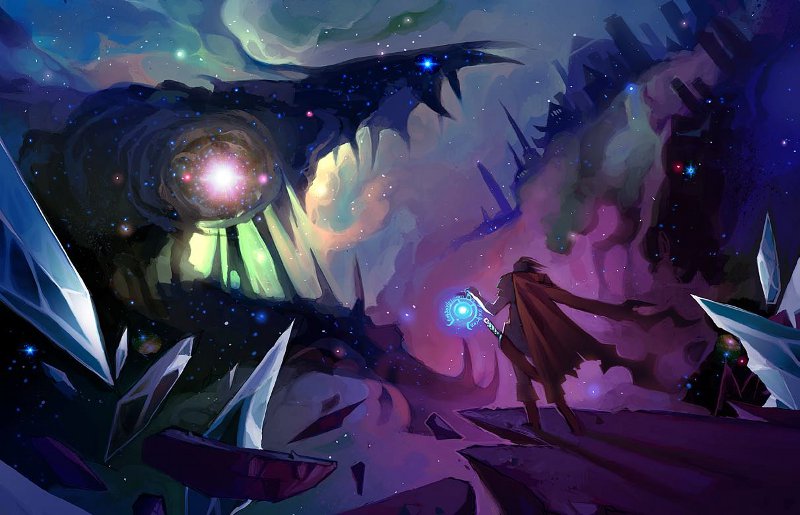
Not gonna lie, this is rad.
Yes, there are other dimensions, other worlds, infinite possibilities!
Pathfinder , noting infinite possibilities, has opted just to crib from Dungeons & Dragons once again.
You have:
-
Material Plane:
This is the "default plane", the one with all the elves and gnomes and dragons and windstorms etc.
-
Astral Plane:
A silvery void that connects the Material and Inner Planes to the Outer Planes, but it doesn't say how. It's also used by wizards for a few spells.
-
Ethereal Plane:
This is a "buffer" between the Material Plane and the Shadow Plane, whatever the fuck this means. Anyway when you're in the Ethereal you can see the Material Plane but you move through it like a ghost. Once again, a number of spells access this plane.
-
Shadow Plane:
A grim, spooky dupe of the Material Plane, which overlaps with the Material Plane (whatever that means) and has evil monsters innit. Also used by spellcasters.
-
Elemental Planes:
Air! Earth! Fire! Water! Anyway, there are genies and elementals in here.
-
Energy Planes:
There are two: the Positive Energy Plane (i.e. life) and the Negative Energy Plane (i.e. death) that apparently somehow flow energy into the Material Plane. Clerics use these planes for channel energy.
-
Outer Planes:
Heaven, Abyss, Hell, Elysium, etc. The afterlife, aka where spellcasters summon angels and demons from.
-
Demiplanes:
These are mini-planes that are generally connected to the Astral or Ethereal.
-
Layered Planes:
Some planes may be broken up into sub-planes and use gates or paths or borders to travel between them.
Environmental Rules
Or, how you take damage just bein' somewhere. Mindin' your own business, but the environment just won't leave you be.
-
Acid Effects
: Acids do 1d6 damage a round, unless you're immersed, in which case it's 10d6 per round. Those breathing in acid fumes have to make a Fortitude save or take Constitution damage. Also you can drown in it.
-
Cold Dangers:
An unprotected character can take nonlethal damage each hour, but in severe cold it goes to every 10 minutes. Frostbite and hypothermia just leave you fatigued, in an unexpected turn of simplicity. Extreme cold does damage every minute and you don't get a save.
-
Ice:
Counts as hindering terrain, and gives penalties to Acrobatics.
-
Darkness:
You can't make sneak attacks or precise strikes, and you can't run or charge for some reason in the dark
don't ask why
. There are Acrobatics checks to move quickly, your'e flat-footed, you have a 50% chance to hit something even if you guess the right square it's in, you have a penalty on Perception and any Str or Dex-based skill check. You can make Perception checks to try and locate the general direction of a noise and grope around to locate things, and getting hit by create pinpoints it for you unless it has reach more than 5'. Also being a good smeller lets you locate nearby creatures. Complications, darkness has 'em.
-
Falling:
Does damage. Acrobatics, soft surfaces, and water can reduce that damage. Most high-level warriors can take a fall from any height and survive. Wizards can just use
feather fall
.
-
Falling Objects:
These do falling damage
to
targets, though "light" objects like wagons might only do half damage.
Yes that is what it says.
-
Heat Dangers:
Like cold, this does nonlethal damage, but you have penalities if you're wearing heavy clothing, like, say, a fighter's armor. Extreme heat just does fire damage automatically, but you still have to check for nonlethal damage because they like their rules complicated, I guess. "Man, I'm burning alive
and
I feel worn out, too!" Boiling water does damage like acid only it's
scalding
damage, a damage type that will never be referred to again.
-
Catching on Fire:
You can make reflex saves not to catch on fire, other wise you take 1d6 fire damage each turn. You can roll around to try and put yourself out, or jump in water. Also you have to make saves for
every piece of equipment you have or it will take damage
. Enjoy bogging down the game with bookkeeping whether or not your 10' pole and hand mirror got burned up! Oddly enough, dragon breath and magic fireballs will not set you on fire, because I guess they're not real fire, or something?
-
Lava Effects:
Like acid, but double that damage in fire damage.
-
Smoke Effects:
You have to make Fortitude saves or spend the round choking and coughing. It's not clear if this uses up your action. If you fail two saves you start taking nonlethal damage.
-
Starvation and Thirst:
You need food or water, otherwise you start saving to avoid nonlethal damage and gain fatigue. Also, magic that heals you will not prevent or heal this damage. Clearly, the way to stop clerics is to starve them to death.
-
Suffocation:
You have to make Constitution checks - not Fortitude saves - when you run out of air. When you fail one, you go unconscious and drop to 0 hit points automatically, and then the next turn you go to dying, then you suffocate, which I guess means you die, but it doesn't say so. There are also details for suffocating slowly in an enclosed space.
-
Water Dangers:
Fast-moving water can sweep you along if you don't make your Swim checks. Very deep water is dark, does water pressure damage (lethal) if you fail a save, and does cold damage (nonlethal) period.
-
Drowning:
Pretty much just recaps suffocation. Next!
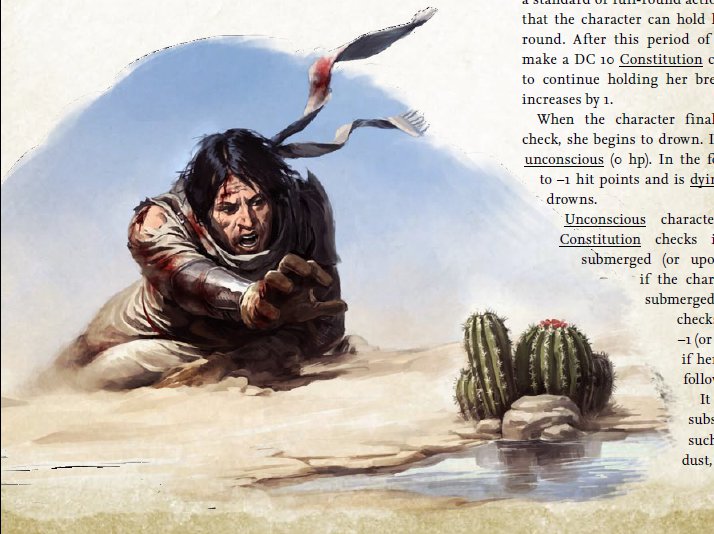
If you played a cleric, you wouldn't be in this situation. Also, you'd be home by now.
If you read this, just be glad you didn't have to read the most boring chapter of the book. It's overcomplicated because it uses a number of different mechanics - nonlethal damage, fatigue, auto-death, lethal damage, Constitution damage, etc. - to simulate various conditions when one would probably do. It's also not clear why some situations fatigue you and others don't.
But I'm getting out of here like a bat out of hell, but first I have to make my Fortitude save to fly in these winds because I'm Tiny, and then I have to make my Fortitude save or take damage from the heat, and make another Fortitude save from the smoke, and it's pretty dark, so I'm pretty sure I have penalties on Acrobatics...
Next: NPCs, and why you're better than them.
Creating NPCs
Original SA post
Pathfinder Roleplaying Game Part 15: Creating NPCs
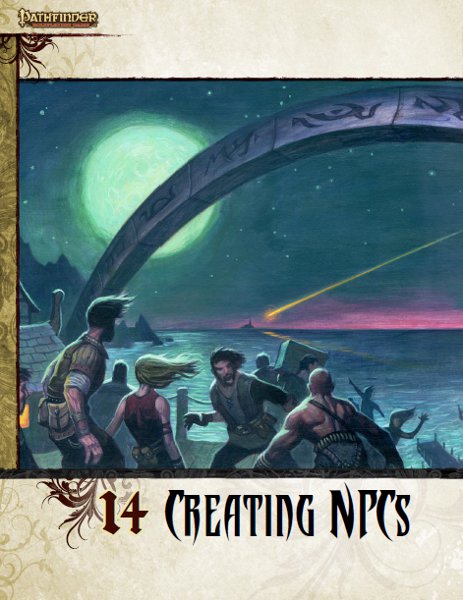
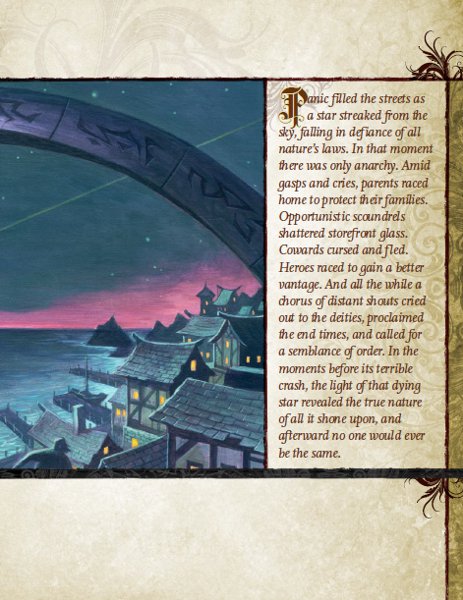
I'd hate to see how they act when a wizard casts meteor swarm.
Now we get on to NPC classes! These are designed to be simpler to quickly generate NPCs... but... they're not that much simpler. You still have to spend skill points and choose feats and maybe spells, they're just missing a lot of class features. So let's get on to them!
Adept
These are minor clerics. They get a smaller spell progression (worse than bard, better than ranger or paladin). They also get a familiar like a wizard. They have lousy skills and hit points, but... their spell list is pretty good! They can turn invisible, cure wounds, animate the dead, polymorph, shoot lightning bolts...
... arguably better than having a fighter or monk in your party. They may be weak spellcasters, but they're still spellcasters, and ones that get their entire spell list to choose from! And furthermore, their spell list is arguably better in places than that of a cleric - they just never get to be as outright powerful. It's kind of weird that they get traditionally arcane spells as part of a divine spell list, but I suppose they're supposed to fill in for either NPC wizards or clerics.
The best NPC class for an NPC to be, clearly.
Aristocrat
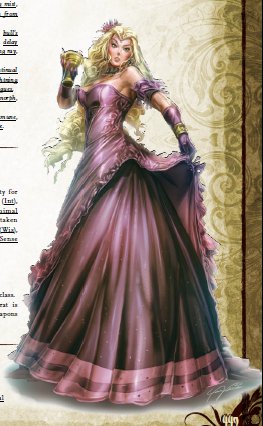
Looking at her proportions... under that skirt, I think we're looking at another aberration.
See, there's a family, and they go to see a talent agent, and... no? Oh.
They've got middling hit points and middling skills and middling attack and no class features and generally it just sucks being a member of the aristocracy.
Ironically.
Commoner
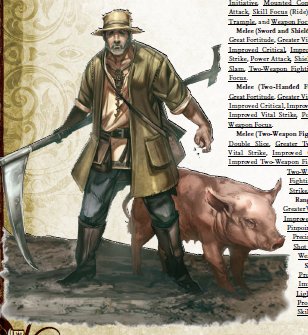
Somehow more badass than a lot of the iconic adventurers.
The worst class in the game, because Bulmahn is a classist pig. Well, not really, but why do commoners have less hit points than aristocrats? "All this hard work in the field has made me sickly and weak!"
Anyway, they have the worst attack bonus, saves, skill points, hit points, etc. It really does suck to be a commoner. The universe - which is to say the rules - literally hates you.
Expert
Like aristocrats, but they get more skill points and more skills to choose from.
Yep, it's better to be a skilled laborer than a king.
Warrior
High hit points, low skills, high attack bonus, that's all you've got here. They get to use any normal weapon and armor, unlike the other NPC classes.
But ultimately it's a fighter that's much worse. Consider that.
Creating NPCs
There's seven simple steps to creating an NPC!
Step 1: The Basics
Determine the race and class. Note all the racial features. You should also figure out its level but they don't mention this for some reason.
Step 2: Determine Ability Scores
There are three methods:
-
Basic NPCs:
These get attributes that boil down to the character getting two +1 modifiers and one -1 modifier.
-
Heroic NPCs:
One +2 modifier, three +1 modifiers, and one -1 modifier. Yes, this passes for "heroic", I guess.
-
Preset Ability Scores:
There's a chart for NPC type (basic or heroic) and then for each "type" (melee, ranged, divine, arcane, skill).
Step 3: Skills
Add up all the points you have for the class and figure in their Intelligence bonus and distribute that amongst skills. Or just simply choose a number of skills equal to the skill points they have and then they get skill points equal to each level in each skill.
If an NPC has two classes you choose skills and you're using the simple method for each seperately starting with the class with the fewer skills.
If they have three or more classes you have to assign skills manually.
Then be sure to add any racial modifiers, modifiers from attributes, class abilities, favored skill bonuses, bonuses from equipment, bonuses from magical items before you're done!
Step 4: Feats
First assign any feats from class abilities (and also races, but they only remember humans for some reason), then a feat for 1st level, and then another feat for every two levels. To their credit, they have easy lists of feats to choose from. To their discredit, there's no details on what the requirements of a feat are, so be prepared to flip back to the feat section and check out all that to make sure they're legal feat choices.
Step 5: Class Features
Choose and note all the class features the NPC has. If they have spells, it notes it's okay just to note their high-level spells and key spells, and choose some off the list during play as you need to determine them.
Step 6: Gear
Cross-reference with a table by their level to determine the GP value of all the gear they have, then divide that by category to see the division of their gear values (weapons, protection, magic, limited use items, and adventuring gear), and then buy items in those five categories. Leftover money converts to jewelry and gold coin carried by the character. These are lower than PCs of the same level because it's just treasure you get for offing them.
To clarify things magic weapons count as weapons and a wand might count as a weapon if it's an attack spell but if not it might be a magic item and it gets a little confusing.
Step 7: Details
Determine the NPC's attack, damage, saving throws, CMB, CMD, intitative modifier, and Armor Class. Make sure you count any bonuses from magic items into their scores. Give them the average hit points, name, alignment, religion, and define their personality.
That's all! Wasn't that simple ? In fact, it's so simple, they recently released Pathfinder Chronicles NPC Guide *, a book full of NPC stats to make it even simpler... er!
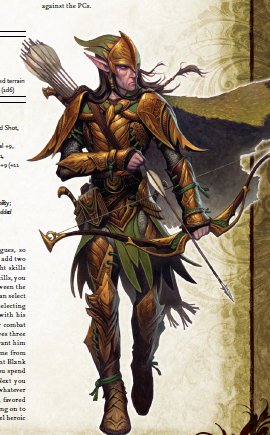
I have to wonder at what point they decided to use repurposed WoW art.
And we round out the chapter with a sample of NPC generation with Kiramor, the Forest Shadow. Check out this simple statblock:
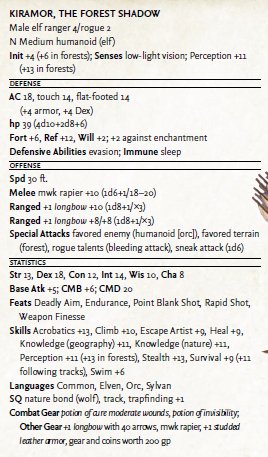
Man. It's so simple I'm amaze- I- my. I think I've strained my ability to be sarcastic for the rest of the day.

Next: Magic Items, or why your badass barbarian needs to be decked out in jewelry and finery like a ponce to be effective.
* A full fifth of that particular book is dedicated to to the Paizo staff's personal PCs. How would you like to spend money to hear "let me tell you about my character..." stories?
Magic Items
Original SA post
Pathfinder Roleplaying Game Part 16: Magic Items
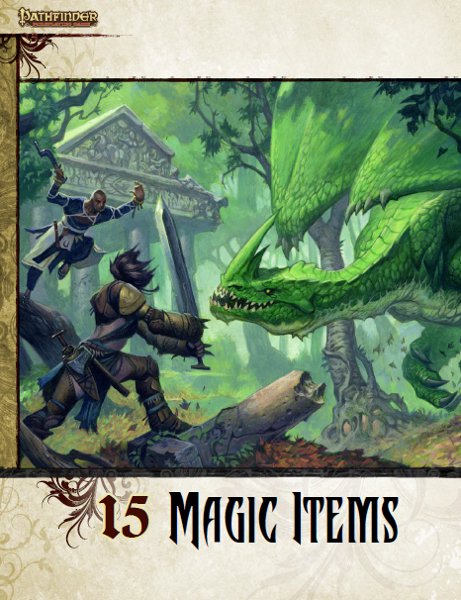
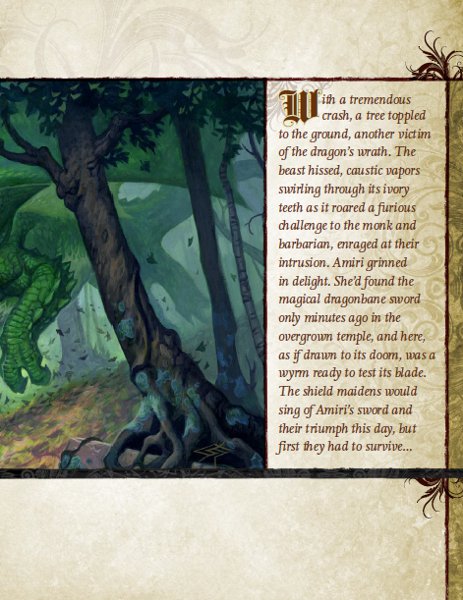
For some reason, Amiri's magical sword just looks like the same buster sword she has in all the art.
The second-longest chapter in the book, as you may recall, because
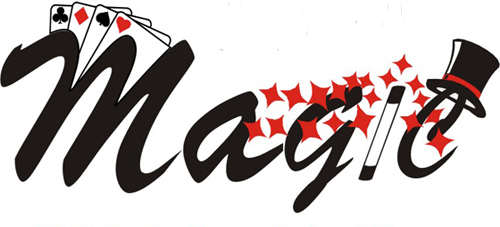
Magic items come in many flavors: armor, weapons, potions, rings, rods, scrolls, staves, wands, and wondrous items. Also there are minor artifacts, which are like magic items but way more badass, and major artifacts, which are badasser.
They detail that each item gives details for uses of detect magic on it. It also gives general guidelines if it's not detailed.
Using Items
To use an item, you have to activate it! Sometimes items work just by putting them on, sometimes they require a standard action. There are four ways to switch a magic item into the "on" position.
-
Spell Completion:
This is a spell that's mostly finished and just needs to be finished. Used for scrolls, mostly.
-
Spell Trigger:
You just have to be able to be able to cast the spell - i.e. have it on your spell list.
-
Command Word:
Needs a word to activate it, often a nonsense word. Very high Knowledge checks can uncover it... or there are spells that just do it automagically.
-
Use Activated:
Just activated by using the item, like wearing a hat or swinging a sword. Not always obvious.
Magic Items on the Body
Basically there are 15 "slots" you can put magic items onto. You can't put more on because (no reason given). They are:
-
Armor
-
Belt
-
Body
(robes)
-
Chest
(shirts, vests)
-
Eyes
(glasses)
-
Feet
-
Head
(tiaras and hats)
-
Headband
-
Neck
(necklaces and amulets)
-
Ring
(up to two)
-
Shield
-
Shoulders
(capes and cloaks)
-
Wrist
Saving Throws against Magic Item Powers
These are dependent on the minimum level to cast whatever effect the item is doing, except staves, which use your level.
Damaging Magic Items
All magic items get saves against damaging spells based on their caster level, except intelligent magic items, which make Will saving throws based on their Wisdom. Magic items that lose half their hit points might not function normally, but it refers us to the Appendix.
There's the broken condition, which generally halves the bonus of an item or makes it use twice the charges etc.
Repairing magic items takes half the time and cost to make them, or you can just find a wizard or cleric to cast make whole , which takes an action and has no cost.
There are some random rolls if your magic item have limited charges to see how many charges they have left, and how to adjust its value based on the remaining charges.
Purchasing Magic Items
Apparently you can buy magic items in most major cities. The size of a community determines a "base value" of the magic items you can find, and then you have a 3/4ths chance of actually finding an item you're looking for. You then roll randomly for higher-cost items to see what's available otherwise.
If you're running a campaign as a low-magic campaign you divide these values by half. "GMs running these sorts of campaigns should make some adjustments to the challenges faced by the characters due to their lack of magic gear." In other words, it's a bullshit rule that they've never going to support.
Or you could have magical communities that increase the base value of magic items available! They do not mention adjusting challenges based on those, however.
Magic Item Descriptions
Every magic item description has certain things:
-
Aura:
What info an item radiates for jerks casting
detect magic
.
-
Caster Level:
The caster level required to make it, or in some cases, the caster level of the jerk that made it.
-
Slot:
The place a jerk puts a magic item on.
-
Weight:
How much a magic item weights a jerk down.
-
Description:
What powers and abilities a magic item provides to a jerk.
-
Construction:
How a magic item is created by a jerk.
-
Requirements:
What a jerk needs to create a magic item.
-
Cost:
How much a magic item costs a jerk to create it. This is half the actual price of the item.
Armor
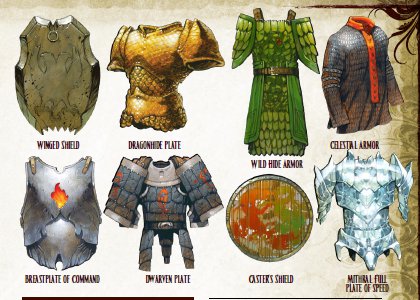
Pants not included.
Now we're getting into actual magic goods - in this case, armor. Armor mostly just provides a bonus to Armor Class, no more than +5, but some abilities basically reduce this bonus in order to give you powers. Armor can go up to +10, but only to accomodate additional powers.
Shields are part of this and stack with armor bonuses.
Here's some notable armor abilities:
-
Animated:
This is a shield that moves on its own! But for some reason you still need to be able to know how to use a shield and still take penalties for using this shield, because magic animated shields are crap.
-
Arrow Catching:
This gives a +1 bonus against ranged weapons. In addition, arrows fired near you now target you, and ranged weapons lose any miss chance they'd normally have against you. Seems like a great way to be a pincushion, really.
-
Blinding:
You'd think it'd be a cone sort of effect, but no. You can blind your friends behind you with this. Ooops.
-
Reflecting:
This costs 25,000 gp to have a shield that can reflect a spell like
spell turning
once a day. Or, you could play a wizard and cast
spell turning
multiple times a day instead. That way, when somebody tries to use their reflective shield, you negate it anyway.
-
Slick:
Armor that seems to be coated with oil. Mostly just gross, but will help you escape from ropes or something, I guess.
-
Wild:
Lets a druid use this armor while in wild shape, in the interest of helping them totally just dominate shit as armored bears.
Then we get specific armors!
-
Banded Mail of Luck:
Lets you reroll an attack roll against you once a week. But the GM doesn't have to show you the roll. And you have to take the second roll. Well, at least it's
+3 banded mail
.
-
Breastplate of Command:
Great for maximizing Leadership and making the game stupid.
-
Demon Armor:
Plate armor that lets you grow claws that disease people. Inflicts negative levels on any nonevil wearer. However, Celestial Armor can be worn by evil people just fine, I guess good spellcasters aren't as judgemental.
-
Mithral Shirt:
Remember, not mithril, mithral. Totally different than mithril, copyright lawyers take note.
-
Caster's Shield:
Lets you put a leather scroll on the back, but it still has arcane spell failure chance, which... affects your ability to cast the scroll, and... well. Most of these are divine-based, for obvious reasons.
-
Spined Shield:
Has spikes you can shoot at people, in the interest of being both metal and silly.
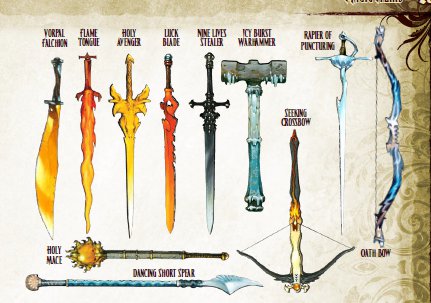
Mostly just magic swords, really.
Magic weapons add to both attack and damage, not more than +5, but can have up to +10 to accomodate powers just like magic armor. Some of these glow, but most don't.
-
Bane:
Yes, a weapon that is bane against dragons or demons costs as much as one that's bane against oozes or plants. I'll let you work out which one of those is more useful.
-
Defending:
Lets you subtract both your bonus to get attack and damage for an Armor Class bonus. Generally a sucker bet to give up two bonuses to get one.
-
Keen:
Doubles the threat range of the weapon. Only really useful if you don't pick up Improved Critical.
-
Ki Focus:
Because monks have to pay a surcharge to use their cool abilities through their crappy weapons.
-
Speed:
Another necessary bonus for fighters to try and keep up with the Elminsters.
-
Throwing:
Lets you throw a weapon you normally can't throw. It doesn't necessarily come back, though, so here's hoping you didn't just give a foe your magic weapon.
-
Vorpal:
Automatically beheads on a natural 20, in case you needed combat to be totally goddamn swingy.
-
Assassin's Dagger:
10,000+ gold for an assassin to get +1 to the difficulty class of the saving throw from their death attack. Want to see nickel design defined? This is it.
-
Holy Avenger:
It's a
+2 cold iron longsword
that upgrades to a
+5 holy cold iron longsword
in the hands of a paladin, and provides spell resistance and lets you area burst
greater dispel magic
. Why? Because most demons or devils are spellcasters.
-
Shatterspike:
A longsword that lets you shatter other magical weapons. Useful for GMs that want takebacks on the magic weapons they've handed out, I suppose.
These can duplicate spells up to 3rd level that target one or more creatures. There are potions, which you drink, and oils, which you smear all over yourself, so oily, so smeared, mmmm-
That's it for potions.
Ring
These are magic rings. Once again, you can only wear two, for some reason. Maybe the gods of magic were very limited on fingers.
All the rings listed are specific items.
-
Ring of Blinking:
Remember how busted
blink
is? Now you get to use it any time you want, forever.
-
Ring of Elemental Command:
Lets you baaasically use a bunch of spells of a given element, making you into an elementalist. Also lets you charm elementals. Good example of a magic item that basically changes your character's capabilities on a fundamental level. And it's not even an artifact!
-
Ring of Evasion:
In case you're jealous of rogues, now you can get one of their core class features in a ring!
-
Ring of Feather Fall:
2,200 gp makes you immune to falling forever.
-
Ring of Regeneration:
So, what roll do you need to make to cut somebody's finger off?
-
Ring of Spell Storing:
In case you didn't think spellcasters were flexible enough. Here. Make them more flexible.
-
Ring of Three Wishes:
Actually costs significantly more than the wishes individually. Learn to cast it yourself, hobo.
-
Ring of Wizardry:
Doubles arcane spells of a specific level.
Doubles arcane spells of a specific level.
Doubles arcane spells of a specific level.
Insert your own dick joke here.
They're like wands but don't use up charges and generally have unique effects. There are also metamagic rods, which let spellcasters cast metamagic without increasing the level of their spell or having the feat. Lesser metamagic rods work up to 3rd level, and greater work up to 6th level spells. Makes the feats a bit of a waste, really, since the rods are so good.
And hard.
And long.
What I'm saying is that they will help wizards fuck this game .
-
Metamagic, Quicken:
Lets you cast three spells a day without using an action. Ha ha, fuck balance.
-
Rod of Absorbtion:
Lets you absorb spells cast at you to fuel your own spellcasting.
-
Rod of Cancellation:
Another way for GMs to destroy beloved magical items.
-
Rod of Enemy Detection:
Automatically detects enemies. Well, that's putting a fine point on it. Basically negates all ambushes.
-
Rod of Rulership:
Lets you control up to 300 hit dice of creatures. They only get a save if their Intelligence is 12 or higher. Can only be used up to 500 minutes total. I'm sure if you take the time you can find some mighty powerful creatures in the
Pathfinder Bestiary
with low Intelligence. You can control ten tarrasques at once, for example. It's not a spell, so fuck their spell resistance. Enjoy.
-
Rod of Wonder:
Yep, random effects are back. Be the most annoying member of your party, with the
rod of wonder
!
Scrolls
These are wads of paper you scribble down spells for later use. There's no level limited, and there are a lot of strictures in how you use them and rolls to make if your caster level is too lost to normally cast them and a special scroll mishap effects. The GM chooses what mishap happens, so you can blame your GM.
Staves
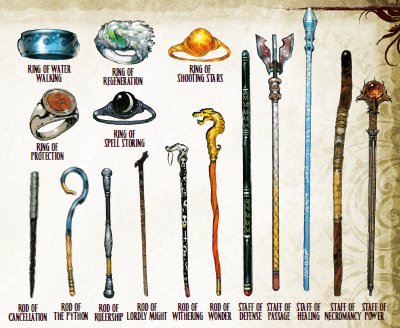
Sticks and stones will annihilate you.
Each staff casts certain spells at the user's casting level. It basically holds 10 charges, which a spellcaster can recharge by giving up spells at the start of the day. Each spell cast from a staff uses a certain amount of charges.
All staffs are unique but generally just give access to spells and are too boring to go over specifically.
Wands
These store spells of 4th level or lower, and can cast that spell up to 50 (!) times. You have to be able to cast that spell to use a wand.
There are just so much of this shit - wands, staves, scrolls - that are spellcaster specific and just designed to give them additional access to spells, as if they didn't already get dozens of spells a day.
It's like "Oh, you have a win button? Have s'more, wizards!"

Wondrous Items
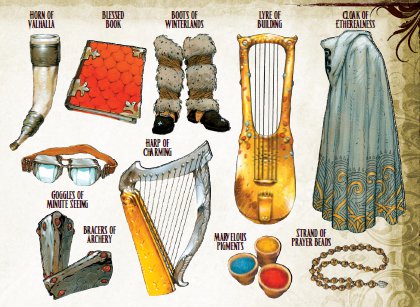
Pigments, huh. You had somebody illustrate pigments.
The generic catch-all anything-else category of magic item.
-
Apparatus of the Crab:
A barrel that turns into a crab-mecha you can ride in.
-
Bag of Holding:
Lets you carry stuff in an extradimensional space. Eventually necessary equipment for all parties considering all the looting and robbing of the dead that goes on in a dungeons.
-
Belt of Giant Strength:
Gives a bonus to strength, with more powerful iterations giving bonuses to multiple physical attributes. An example of necessary equipment for warriors as they level up to keep their bonuses in line with Challenge Ratings.
-
Blessed Book:
A 1,000 page spellbook that a wizard can scribe spells into for free. Yes, for every limitation, a wizard has a magic item to overcome it.
-
Bracers of Armor:
Or, "how arcane spellcasters overcome not being able to wear armor".
-
Candle of Invocation:
Increases a cleric's caster level when lit, even above their hit dice. Worried about it getting blown out in a fight? Just put in a lantern with your holy symbol on it, voila.
-
Chime of Interruption:
Lets you force Concentration checks for any spell with a verbal component. One of the few decent anti-spellcaster items.
-
Chime of Opening:
"Grab one of these, and we don't need a that rogue anymore."
-
Decanter of Endless Water:
"Yeah, now we just fill any dungeon we run across with water, drown out the critters, and send the divers in."
-
Efreeti Bottle:
Summons an efreeti. Has a 10% chance of granting wishes! Or a 10% chance of just attacking you. Costs 145,000 gp either way.
-
Eversmoking Bottle:
"We don't have a decanter, so we just smoke critters out of dungeons."
-
Golem Manual:
Books that assist casters with creating golems. Yes, golems. Another special thing only spellcasters can create.
-
Hand of Glory:
A mummified hand that lets you wear an extra magic ring. Yes, having four arms doesn't let you use four rings, but a gross fucking dead hand around your neck does.
-
Headband of Inspired Wisdom:
Gives a bonus to Wisdom. An example of the sort of item spellcasters will need later on to stay competitive.
-
Incense of Meditation:
Maximizes (that is, gives them the maximum effect roll) all spells a divine spellcasters can cast. Yes, fucking really.
-
Ioun Stones:
Provide a variety of minor bonuses from rocks that circle your head. Get enough of these and you too can be a model of the solar system!
-
Manual of Bodily Health:
Gives a permanent bonus to Constitution. An example of a series of books that give permanent bonuses to attributes high-level characters need to keep up with the monsterses. Yes, instead of just giving characters more attribute points, you have to get a wizard to write magic books for you to be a proper adventurer. Fuuuck.
-
Mirror of Soul Trapping:
Save or die is back. Sort of. It just traps you until the mirror's broken or whatever. So. Pretty much save or die.
-
Mirror of Opposition:
Lets you create a duplicate of a creature to attack it. There's no upper level for this. "Hey, god. Fight you."
-
Pearl of Power:
Lets spellcasters recall spells. No, seriously, it's yet another way for spellcasters to recover / store spells.
-
Portable Hole:
101 comical, game-breaking uses.
-
Robe of the Archmagi:
A special item that gives special powers to special arcane special casters.

-
Robe of Eyes:
You have eyes on your butt! Never be flanked again!
-
Robe, Monk's:
Makes you do more unarmed damage and get to use stunning fist more. Why have items that are "you are your class, only better!" Doesn't that make them basically resquite items for the classes that get them?
-
Robe of Stars:
Lets you travel to the astral plane, gives a bonus on saving throws, and
lets you use the stars on your outfit as +5 shuriken
. Okay, this is getting to the point of self-parody, I think.
-
Sustaining Spoon:
Makes magic gruel. No, seriously. Magic gruel.
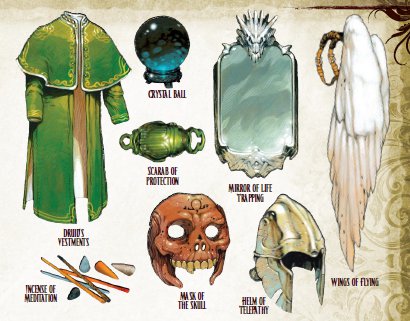
Oh look they illustrated the Mirror of Lif-
Are we done with this shit or what- oh no-
Intelligent Items
Some magic items are smart, but they're very rare. They get Intelligence, Wisdom, and Charisma scores, and are treated as constructions. Many have to glow in order to see, because... um... I have no idea. Doesn't say.
Intelligent magic items have an Ego score, which is how hard they hard to control, and an alignment. They bestow negative levels on characters that don't match up with their alignment. So, the idea if an evil sword that corrupts the user, no matter how iconic, just doesn't happen. It's not compatible until you're evil to begin with.
Being intelligence, the ability scores it has, what senses it has, and how it communicates increases the item's cost. Then, it gets a special power(s) which it uses on its own, and doesn't require an action from the wielder. Most powers are just spell-like abilities or general bonuses towards a skill or roll, in addition to whatever magic powers the item has in the first place.
Some have special purposes, which makes them harder to control but then they get a unique power when fulfilling that purpose.
A magic item's Ego score is dependent on bonuses it gets from its attributes plus a special bonus derived from a table based on its cost, which creates the Ego score, which is really the Will save DC the wielder has to make when conflicting with the item's personality to get it to do as they like. If the item wins, they can force the user to concede to an action of the item's choosing.
And intelligent magic items don't get along with other intelligent magic items, because they're jerks by nature, apparently.
Cursed Items
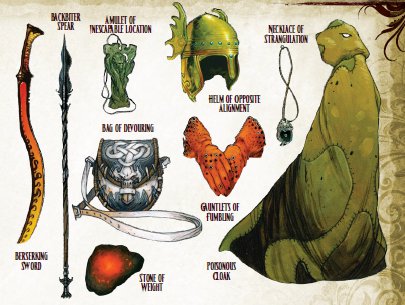
Memorize these descriptions, adventurers.
This is how it works. You train players to pick up and use every magic widget that comes along. Hell, the game presumes it. And then, ha ha, it's a trap! Gotcha!
It's harder to detect cursed items, too - you have to make your Spellcraft check at a DC 10 higher than normal. A lot of cursed items force the user to keep them, reappear when discarded, or other similar forced plot hijinx to keep them in play. No, you don't get a Will save or anything.
There are different common effects for cursed items, including:
-
Delusion:
Makes the user think it has a certain magical effect, but it really doesn't.
-
Opposite Effect or Target:
Basically gives a penalties instead of bonuses, or targets the wrong person.
-
Intermittent Functioning:
Sometimes it no worky, or only worky under certain conditions.
-
Requirement:
Makes the user do something, like eat more (oh nooooo) to destroying other magic items (oh fuck) to murdering people (easy enough for your average D&D character), etc.
-
Drawback:
From the nightmare that the character's hair grows super-long (oh shit, YOUR HAIR), mucks with your height, to changing your gender to preventing you from casting spells, etc.
Then we get specific items. Most of these can only be dealt with by casting remove curse and other spells which means - yep! - only spellcasters can deal with them.
-
Bag of Devouring:
It's like a bag of holding, how handy! Then it tries to eat you.
-
Boots of Dancing:
Magic boots that work normally until you're in a fight, then they make you dance.
-
Broom of Animated Attack:
It's like a
broom of flying
, only it attacks you when you try and use it. It's important to reach out to others when your magic items beat you.

-
Helm of Opposite Alignment:
Only works once, but reverses your alignment. Only a
wish
or
miracle
can undo it.
-
Necklace of Strangulation:
Strangles you for 6 points of damage a turn, and cannot be removed by anything less than a
limited wish
. Didn't have somebody in your party have that spell (and its components) ready? You're dead.
-
Potion of Poison:
You could have a 12th level magic-user turn a potion into a poison - or - or I'm going to go out of a limb here, you could
just poison a fucking potion with actual poison
.
-
Robe of Powerlessness:
This puts ants in your pants.
-
Scarab of Death:
Save or die. Carry this around, and it turns into a beetle and burrows into you. You get one Reflex save to avoid death, otherwise it eats your heart in a single turn.
-
Vacuous Grimoire:
A normal looking book that saps your Intelligence and Wisdom. Permanently. I hope you weren't too attached to being able to cast your spells...
Artifacts
These are special plot device sort of items. Also, they're invulnerable, and can only be destroyed one way like that one... ring. Yes.
First, we have minor artifacts.
-
Deck of Many Things:
Gives random benefits or fuckery, just like the Dungeons & Dragons version. You could get a bonus to an ability score! Or your soul could get sucked away. Or you could get imprisoned and lose all your magic items. Whee! It's pretty much a coin flip whether it's beneficial or a curse. A lot of the penalties are way, way worse than the benefits. A sucker's bet.
-
Sphere of Annihilation:
A sphere that destroys anything that can touch it, with no chance of resurrection. A character with a good Int and level can try and control it mentally, but if you fail, it makes a slow progression towards the attempted controller.
-
Staff of the Magi:
Gives you numerous spell-like powers which use charges, and absorbs spells cast at you, which recharges it. But if you absorb too much, it blows up in your face.
-
Talisman of the Sphere:
Gives arcane casters a bonus on controlling spheres of annihilation. It tries to magic-murder anybody else who picks it up. I know, arcane casters, amirite?
-
Talisman of Ultimate Evil:
Lets you open up a flaming crack to eat up good divine spellcasters. If you're not especially evil, it tries to eat you instead.
 Most minor artifacts are borderline cursed, with drawbacks that often could kill you if used improperly.
Most minor artifacts are borderline cursed, with drawbacks that often could kill you if used improperly.
Then we have major artifacts.
-
Codex of the Infinite Planes:
A giant book that casts
destruction
on the first person to open it. The survivors can study it for Spellcraft checks (DC 50) to gain powers from it, but each day of study forces a Will save that increases or go insane. It also lets you cast a bunch of plane-themed spells, but you have to make a very high Spellcraft check. If you fail, it might throw a natural disaster at you, a bunch of high-level fiends, toss your soul in a gem and bury your body randomly somewhere in the world, or cast two save-or-die spells at you for ten rounds or until you're dead.
-
The Orbs of Dragonkind:
These let you control a specific type of dragon, and get dragonbreath and other powers related to your dragon type. But all dragons then hate you forever.
-
The Shadowstaff:
Gives you a bunch of mighty darkness-themed powers, but then penalizes you in bright light.
~GOTCHA~!
Magic Item Creation
One big difference between Dungeons & Dragons third edition and Pathfinder in magic item creation is this: magic items no longer cost XP to make. See, in Dungeons & Dragons , a spellcaster could get extra magic items (since it's cheaper to make than buy), but they'd pay in being a level behind everybody else. In Pathfinder , they just get the ability to... make additional magic items. And be better than other classes. Yes. Even better than they already are. Better and better as they gain levels. Better, better, better.
Anyway, when you make an item, you have to make a Spellcraft check. If you fail, all of your money and time are wasted. If you fail really well, all your money and time makes a cursed item instead. Each item has certain prerequisites to be created, usually spells, an item creation feat, etc. You can make items without that spell, but it adds to the Spellcraft difficulty.
So if you're using Master Craftsman, mentioned back in the character creation section? Not only do you have to take an extra feat to make magic items, not only are you more limited in what you can create, but the DC is going to be notably higher for most things you try and make, because seriously, what are you wasting your time with not being a wizard if you're an artificer?
The basic cost of the item is half the market price + the actual cost of the physical item + any spell components. They take about a day per 1,000 gp to create, though potions and scrolls can be less. You can speed it up by increasing the Spellcraft check.
There are various tables totalling effects and costs and I could not care less. It's full of holes - a lot of it is based on spell levels, and not every spell of a given level has equal efficacy. As mentioned for rods, wands, scrolls, etc., it's really focused on being a system for spellcasters and giving spellcasters additional benefits. Sure, there are magic armor and weapon, but those tend to be a lot less flexible are a prime examples of nickel design, where fighters have to pay extreme amounts just to get another +1 or +2 on their attacks.
Next: I'm done, right? That's the last chap- oh, appendices ? What the shit?
Appendices
Original SA post
Pathfinder Roleplaying Game Part 17: Appendices
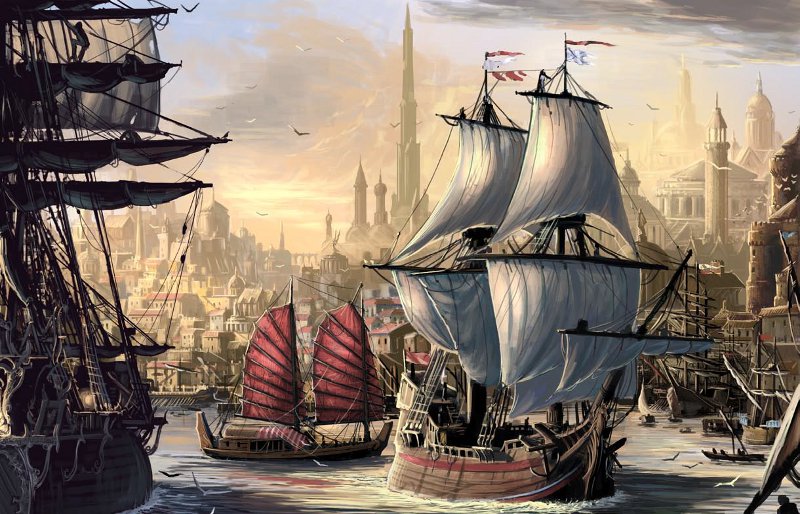
Boats!
Here's where we get rules for special abilities and conditions, presumably put here so they're easy to flip to, which isn't a bad idea. Also, there are are a lot of them.
Appendix 1: Special Abilities
There are spell-like, supernatural, and extraordinary abilities; I'm not going to go over them again.
-
Ability Score Bonuses:
If you have a bonus to your attributes, this discusses what secondary traits benefit and don't benefit.
-
Ability Score Damage, Penalty, and Drain:
Damage weakens an ability score, but can be healed normally, penalties are temporary, and drains just are permanent unless you get a cleric to kiss it and make it all better.
-
Afflictions:
This covers poisons and diseases. These require you to make saves until you fight it off, or die, or whatever.
-
Curses: Some of these are from spells, others include plot devices like "curse of the ages" (makes you age unnaturally fast) to lycanthropy.
-
Diseases:
Usually do ability damage until you save twice in a row against them. There are some nasty ones like Demon Fever or Slimy Doom that can do Constitution drain instead.
-
Poison:
It gives the various means to poison someone, and also keeps alive the Dungeons & Dragonsism that non-assassins have a base 5% chance to accidentally poison themselves when trying to envenom a blade. You can be a master chemist, combatant, wear gloves, and screw you! Five percent. Most just do ability drain, damage, or induce unconsciousness. There are a lot of them listed. Skipping.
-
Blindsight and Blindsense:
Some creatures can "see" through a secondary sense. Blindsight is precise, blindsense is not.
-
Channel Resistance:
This gives a bonus to save against channel energy done by a cleric.
-
Charm and Compulsion:
Charms make you think the caster is your friend; compulsions take over your mind.
-
Damage Reduction:
Reduces damage against all except a listed source, like a weapon made out of silver or iron. Or magic. Magic just bypasses this. Because magic.
-
Darkvision:
You can see in the dark, but only black 'n white.
-
Death Attacks:
If you fail a Fortitude save against these, you diiiiie.
-
Energy Drain and Negative Levels:
These give penalties equal to the amount of negative levels, and also make you lose total and current hit points. If you have more negative levels than hit dice, you diiiiie. There's temporary and permanent, and permanent requires a powerful cleric to fix you.
-
Energy Immunity and Vulnerability:
Basically that a creature is immune to a damage time. Creatures that are immune to fire are vulnerable to cold and vice versa.
-
Energy Resistance:
This is subtracted from any damage taken of the energy type this applies to.
-
Fear:
There's shaken, where you have penalties, frightened, where you run away from the source of the fear, and panicked, where you go apeshit and just run away from all dangers.
-
Invisibility:
Some creatures can become unseen, which is pretty advantageous.
-
Low-Light Vision:
You can see twice as far in dim light.
-
Paralysis:
Some creatures can paralyze people. Spellcasters who can cast a spell without somatic or verbal components can still cast spells, though. Dammit, casters!
-
Scent:
This lets you track by smell with Survival. There's rules and stuff for it.
-
Spell Resistance:
Casters have to make a caster level check (1d20 + caster level) to cast spells at something with spell resistance or the spell fizzles. Yes, with spells, this gets really complicated since they're so complicated to begin with. I'm not going to sweat it at this point.
Appendix 2: Conditions
This is where status effect are listed, like bleeding, blinded, confused, grappled, etc. The significant ones have already been covered elsewhere in my review so I'm not going to belabor them too much.
Appendix 3: Inspiring Reading
This covers a lot of fantasy and horror books, but books only. The fact that the iconic barbarian nabbed her sword from Final Fantasy 7 and that half their elves busted straight out of World of Warcraft is a fact not given its due.
Appendix 4: Game Aids
Pathfinder Roleplaying Game posted:
In addition to a few character sheets and some dice, there are a wide variety of additional tools available to enhance your game.
Of course there are.

This is where they mention there are Adventure Paths, Modules, Chronicles (their setting books), GM Screens, Flip-Mats and Map Packs, Item Cards, Critical Hit Decks, and a free conversion guide for 3.5.
Hmmm.
Then we have the Open Gaming License closing this thing out. In addition to Dungeons & Dragons 3.5 , it also mentions Pathfinder borrows material from The Book of Experimental Might (by Monte Cook) and Tome of Horrors (by Scott Greene, with Clark Peterson, Erica Balsley, Kevin Baase, Casey Christofferson, Lance Hawvermale, Travis Hawvermale, Patrick Lawinger, and Bill Webb).
Why Tome of Horrors ? Because it's their backdoor into TSR's monster library. See, back during the d20 days, Necromancer Games consulted with Wizards of the Coast to find out what critters Wizards had no intention of revising, and was able to get permission to do Tome of Horrors, which took these reject monsters and put them in d20.
Which made a lot of classic Dungeons & Dragons monsters d20.
Which Pathfinder is going to nab like a shopping spree in the later Pathfinder Bestiaries. Like a junkie rogue on haste with five-finger discount gloves .
Because Pathfinder isn't about building a game of their own, but taking Dungeons & Dragons away from Wizards of the Coast. It's what the d20 Open Gaming License was always about, and this is its fruition.
Next: The outro.
Epilogue
Original SA post
Pathfinder Roleplaying Game Part 18: Epilogue
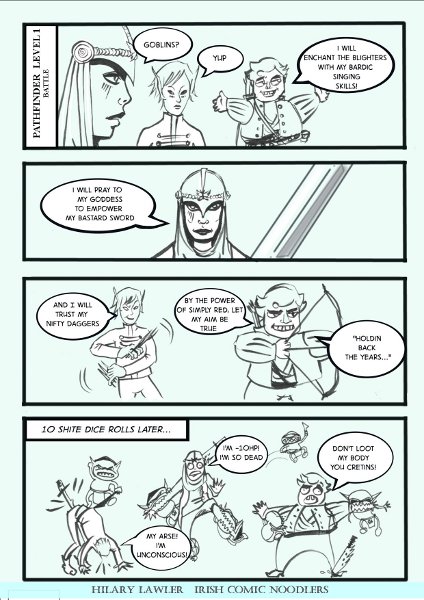
First off, I want to say, for all my snark, if you enjoy the Pathfinder Roleplaying Game , that's just fine. It's a popular game and has a lot of passionate fans. To be honest, there is a lot of fun with any game with this level of crunch - puzzling it all out is an interesting metagame even when you are aware of the flaws. I don't think it's great design, but there is an appeal to the puzzle that Pathfinder's options present. Hopefully at least you're more aware Pathfinder's foibles, and can better deal with them.
And if you have folks who haven't gotten to see a more critical look at Pathfinder , you can point them here. It's not a matter of edition warring, but looking at Pathfinder on its own terms. Not everything I've said has been perfectly serious, of course. I think a lot more of the art here than I probably let on during the review - there are a lot of pieces I like, but I'm trying keep things entertaining for such a long FATAL & Friends. The layout is gorgeous and well-presented, and the actual writing and organization fo the book is solid. The content, however, is the core of the book, and that's where I generally find it lacking.
I decided to do this FATAL & Friends writeup because Pathfinder's so popular; I wanted to understand it better, what makes it successful and where it succeeds and where it fails. I was neck-deep in Dungeons & Dragons 3.5 for awhile, and I ran it for years as well as writing a lot of mechanical material for fan publication s online. I feel like I do understand its appeal and success better, even if it hasn't endeared itself to me much more than when I started.
And, honestly, it's hard to find any critical views of Pathfinder online. Here's some examples of some reviews from the top of a google search.
Adaen of Bridgewater, rpg.net posted:
They essentially wanted people to continue to be able to use their 3.5 materials in a 3P game.....which is nice, considering the thousands of dollars that many people have invested in that system.
Robert A. Howard, amazon.com posted:
I could scarcely be happier with what Paizo has done. The rules flowed nicely, and most importantly kept out of the way until needed. Combat was also quick and easy, and the Pathfinder RPG has made it easier than ever to keep the action flowing without a lot of downtime. This system is an excellent choice for any fantasy setting, and I am confident that if you enjoyed Third Edition, you're really going to love what they've done with this game.
quote:
People harking back to The Good Old Days of earlier versions of the game, in particular the shining diamond that is version 3.5.
...
The reigns have been taken up by other companies, most notably by Paizo Publishing, who have essentially taken the whole thing over, streamlined, improved and repackaged it into something new but familiar under the rather splendid banner of Pathfinder. And if youíre looking to get into the game, itís heartily recommended that you pick up the Pathfinder Core Rulebook, 574 pages that contain everything a player needs bar the dice.
Often reviews just boil down to Dungeons & Dragons 3.5 was good, this is a better version of Dungeons & Dragons 3.5 , therefore it is good". Hell, even I couldn't avoid constant commentary regarding Pathfinder and Dungeons & Dragons 3.5 . It's become a touchstone for our hobby, as was intended .
Ryan Dancey posted:
The OGL/D20 project also ensured that a version of D&D would exist as of the 3rd Edition version no matter what future incarnation of D&D might be developed. Future versions of D&D would be benchmarked against that milestone, and if the market decided they did not want to switch to the new version, unlike in previous iterations where all commercial support for the previous version would be terminated, the market would be able to keep supporting the version that they preferred. This raises a high bar to future versions of D&D ñ you have to be so much better than the 3e game that people will voluntarily switch platforms.
I went for it back in 2000, like so many others did. It was genuinely interesting and slick compared to Advanced Dungeons & Dragons 2nd edition , which had felt like a relic for a decade at that point. d20 was an literal attempt to homogenize the gaming industry, and it's probably as successful at that as any system's going to get. It was exciting, but systems are like technologies, and all the flaws and bugs remain even though they've been exposed many times over now.
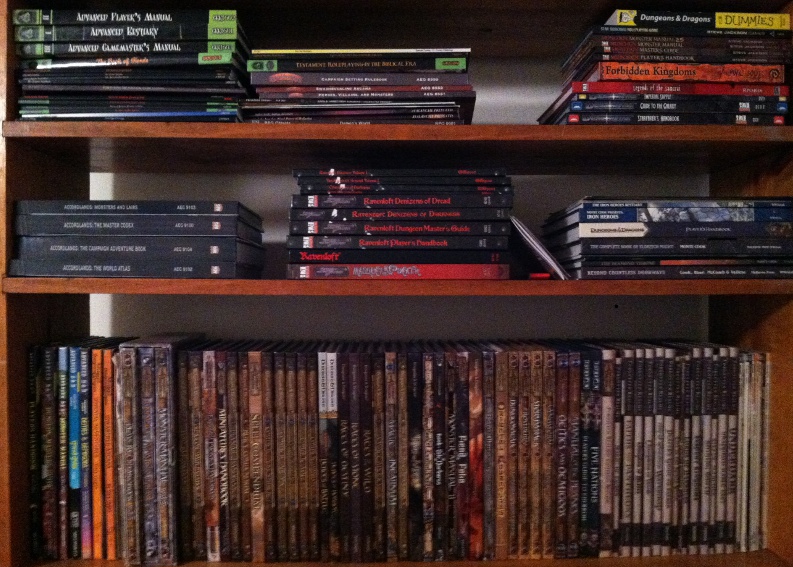
My D&D shelf. A lot of this was "donated" from friends after the d20 / OGL collapse.
While I was in the midst of reviewing this, I had a fellow goon mention something interesting.
Asimo posted:
I realize that if I ever theoretically had the urge to publish an RPG, I would be as thorough as possible but still go and include a bunch of non-critical broken rules and loopholes since apparently nerdarguing and houserules seem to be the primary attention-driver.
Ooof. Well, that's terribly cynical, but really, maybe a squeaky rule does get the house rule. After all, think of the most popular systems - how many have been really well-designed? I don't think it's that people don't give a shit about systems, but rather they're not terribly critical about them. And when they find one that's "good enough", they just tweak it and house rule it enough to file off the sharp edges. And then they settle in, and if somebody points out the flaws, they lash out. After all, the house rules have invested them in the system they had to "fix" in the first place!
Maybe only flawed systems create that kind of investment. When a system isn't flawed, you can pick it up, use it, and put it back exactly the way you left it. House ruling is a form of devotion and investment. A friend of mine once compared the weekly ritual of getting together for roleplay to be akin to a religious ceremony, and if so, systems become the mystery cults of optimizers and gamemasters.
And, ultimately, this game itself emerged from Jason Bulmahn's house rules for Dungeons & Dragons 3.5 . Of course, the reasons for Pathfinder's invention have as much to do with business as hobby - Wizards of the Coast left a lot of publishers hanging over how they were going to license Dungeons & Dragons 4th edition , and so Paizo turned towards revising Dungeons & Dragons 3.5 rather than sit on their hands and publish nothing. And it's worked out better than they ever dreamed, I'm sure.
In that way, it is the "game of the fans" that they describe, but those fans aren't the 45,000 or so downloaders of the beta. Those fans are people like Jason Bulmahn and Sean K Reynolds, who have gotten to make perhaps the first American Dungeons & Dragons heartbreaker to truly make it since the Palladium RPG or Rolemaster . This is on account of the Open Gaming License and Monte Cook's blessing giving them a sort of false legitimacy, an illusion of continuity. It is Ryan Dancey's dream come true, and it's no coincidence he works with Paizo now. After all, he designed d20 to survive the market in the first place. Paizo's claiming of the d20 system isn't some dastardly turn on their part; it was part of the Open Gaming License's intent in the first place. Of course, putting a $80 price tag on a set of house rules is entirely their doing, and folks can judge that for themselves.
Ryan Dancey posted:
One of the goals of the OGL and the D20 project was to ensure that no single company would ever have the ability to kill Dungeons & Dragons. TSR almost did so; near the end of its existence it had pledged the copyrights and trademarks of the D&D franchise as security against loans it could not afford to repay. Had TSR gone into bankruptcy it is likely that for at least some time, and possibly an extremely lengthy period, nobody would have had the right to publish using that IP while the bankers fought over the carcass of TSR.

More d20. More. MORE.
There are times when I was posting this up that I thought maybe I'm wrong . Maybe quality in system design isn't that important, or maybe I'm looking for the wrong things. I could be nitpicking too hard on things that just don't matter to your average TRPG player, hating them because they play a game I don't love. It's tough looking through blogs, boards, and reviews and seeing litanies of unabashed love and devotion for the game.
It reminds of me of an Over the Edge game I was where - and I don't know if this was an element of the game's twisted setting itself or a product of my gamemaster's twisted imagination - at one point my character had to investigate a business "Pervy Ernie's". It was basically Chuck E. Cheese, but instead of a cute cartoon mouse, Pervy Ernie was basically a caricature of a child molester. Brown trenchcoat, wide-brimmed hat, shadowy face, and lollipop in hand, he was the exaggerated figure of "waaant some caaandy?". The adventure never actually had any sign that any children were ever victimized at Pervy Ernie's, but only outsiders to the setting ever noticed anything wrong with it - the locals seemed blithely unaware, which only made the thing much more creepy.
And that's how this feels when you dip your head in deep enough. Something is wrong with the whole situation - be it sloppy rules, the blatancy of the whole Grand Theft System, or just the salesman swagger of Monte or their kickstarters. There's something off about the whole affair, and it seems so plain to the eye from outside the fandom. And it makes you wonder why it isn't plain to everybody else. They get people to purchase something they give away for free through their System Reference Document. That's the sort of salesmanship that's not just good - it's downright surreal. Like Ernie.
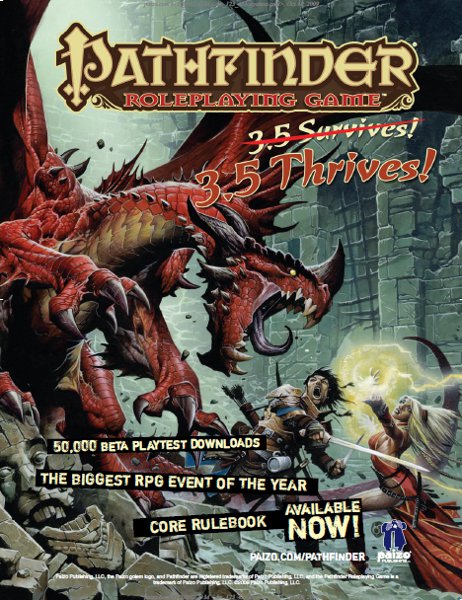
But we'll see what the future will bring. Pathfinder will need to branch into more and more niche products as the line goes on. Next year we'll see the release of Mythic Adventures , a significant variant of the Pathfinder rules. They'll have to (and have already started to) do more and more things that are exclusively theirs once they start running short on nostalgia to mine. The question is, can they succeed with that?
We'll see. As a wise man once said, "People don't want the best hamburger they could have, they generally just want the hamburger they know."
Next: The Pathfinder Bestiary.